Compound and organic light-emitting device including the same
Park , et al.
U.S. patent number 10,720,585 [Application Number 15/394,476] was granted by the patent office on 2020-07-21 for compound and organic light-emitting device including the same. This patent grant is currently assigned to SAMSUNG DISPLAY CO., LTD.. The grantee listed for this patent is Samsung Display Co., Ltd. Invention is credited to Seokhwan Hwang, Eunjae Jeong, Youngkook Kim, Eunyoung Lee, Hyoyoung Lee, Junha Park, Munki Sim.

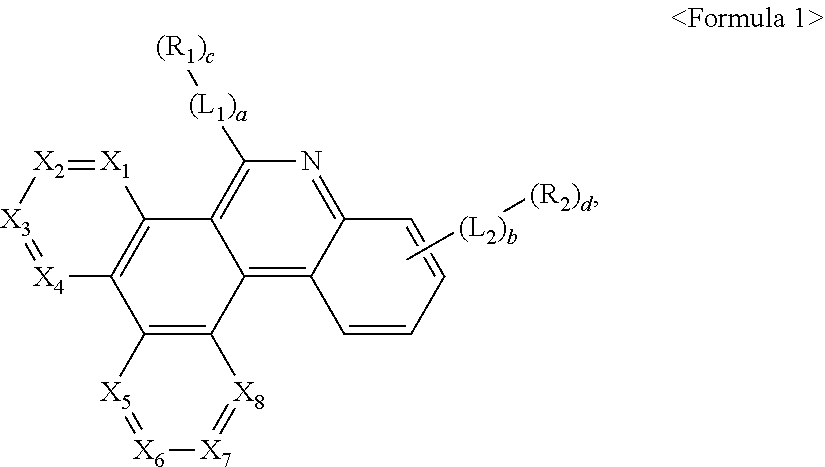

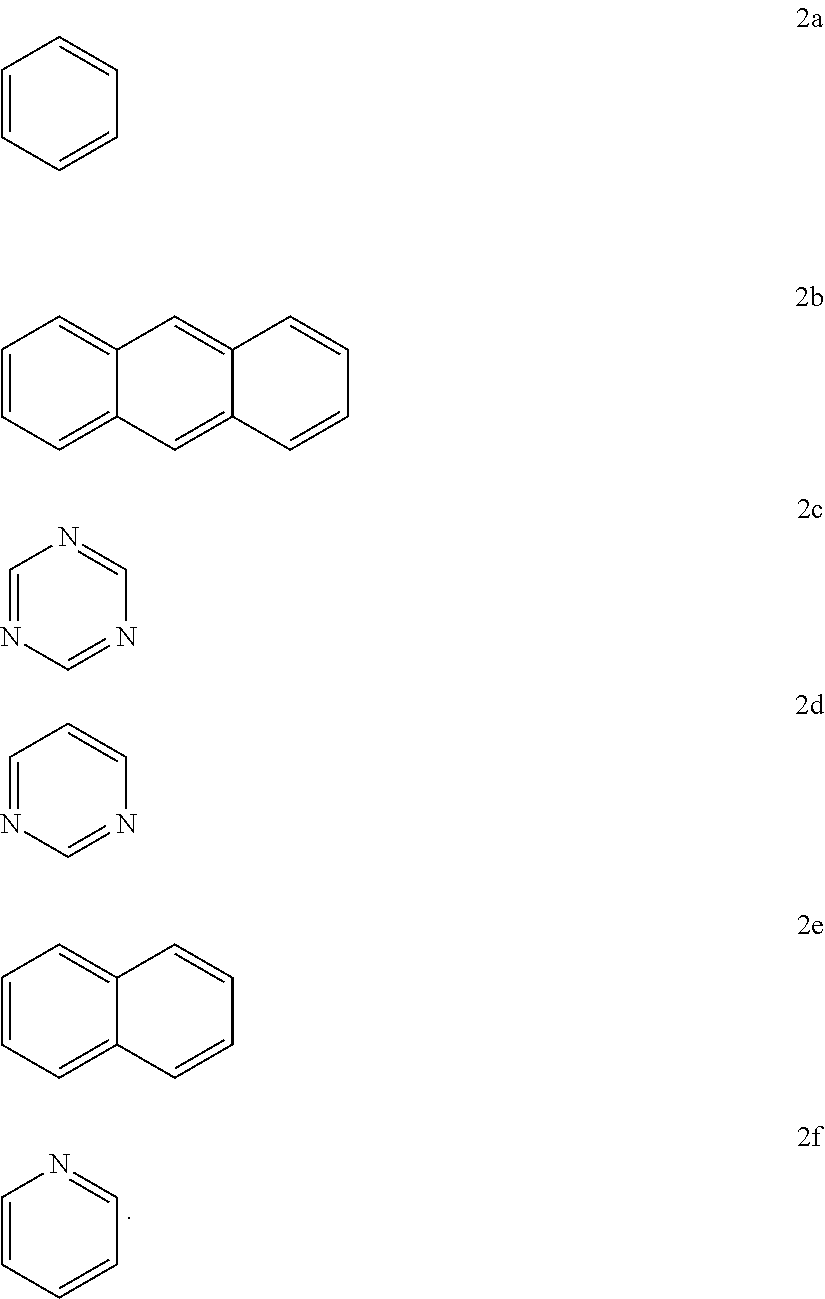



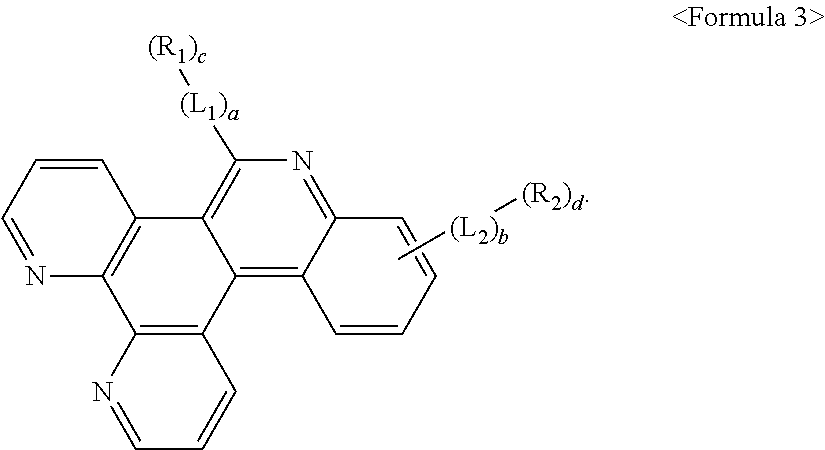




View All Diagrams
| United States Patent | 10,720,585 |
| Park , et al. | July 21, 2020 |
Compound and organic light-emitting device including the same
Abstract
A compound is represented by Formula 1 and an organic light-emitting device including the same: ##STR00001## wherein Formula 1 is the same as described above.
| Inventors: | Park; Junha (Yongin-si, KR), Lee; Eunyoung (Yongin-si, KR), Kim; Youngkook (Yongin-si, KR), Sim; Munki (Yongin-si, KR), Lee; Hyoyoung (Yongin-si, KR), Jeong; Eunjae (Yongin-si, KR), Hwang; Seokhwan (Yongin-si, KR) | ||||||||||
|---|---|---|---|---|---|---|---|---|---|---|---|
| Applicant: |
|
||||||||||
| Assignee: | SAMSUNG DISPLAY CO., LTD.
(Yongin-si, Gyeonggi-Do, KR) |
||||||||||
| Family ID: | 59086048 | ||||||||||
| Appl. No.: | 15/394,476 | ||||||||||
| Filed: | December 29, 2016 |
Prior Publication Data
| Document Identifier | Publication Date | |
|---|---|---|
| US 20170186979 A1 | Jun 29, 2017 | |
Foreign Application Priority Data
| Dec 29, 2015 [KR] | 10-2015-0188905 | |||
| Nov 8, 2016 [KR] | 10-2016-0148192 | |||
| Current U.S. Class: | 1/1 |
| Current CPC Class: | C07D 471/14 (20130101); H01L 51/0072 (20130101); H01L 51/0067 (20130101); H01L 51/0073 (20130101); H01L 51/0054 (20130101); H01L 51/0077 (20130101); H01L 51/0074 (20130101); H01L 51/005 (20130101); H01L 51/0058 (20130101); H01L 51/5056 (20130101); H01L 51/5072 (20130101); H01L 27/3262 (20130101) |
| Current International Class: | H01L 51/00 (20060101); C07D 471/14 (20060101); H01L 51/50 (20060101); H01L 27/32 (20060101) |
References Cited [Referenced By]
U.S. Patent Documents
| 5645948 | July 1997 | Shi et al. |
| 8114529 | February 2012 | Kitazawa et al. |
| 9028978 | May 2015 | Kim et al. |
| 2007/0231503 | October 2007 | Hwang |
| 2011/0297919 | December 2011 | Kwak |
| 2016/0204357 | July 2016 | Jang |
| 10-17860 | Jan 1998 | JP | |||
| 11-87067 | Mar 1999 | JP | |||
| 4060669 | Dec 2007 | JP | |||
| 10-0525408 | Nov 2005 | KR | |||
| 10-2007-0052764 | May 2007 | KR | |||
| 10-2013-0000230 | Jan 2013 | KR | |||
| 10-2013-0135178 | Dec 2013 | KR | |||
| 84/03838 | Oct 1984 | WO | |||
Other References
|
Nicklas Johansson, "Solid-State Amplified Spontaneous Emission in Some Spiro-Type Molecules: A New Concept for the Design of Solid-State Lasing Molecules", Advanced Materials, May 20, 1998, pp. 1136-1141, vol. 10, No. 14, Wiley-VCH Verlag GmbH. cited by applicant . Y. T. Tao, "Sharp green electroluminescence from 1H-pyrazolo [3,4-b]quinoline-based light-emitting diodes", Applied Physics Letters, Sep. 11, 2000, pp. 1575-1577, vol. 77, No. 11, American Institute of Physics. cited by applicant . C. W. Tang, "Organic electroluminescent diodes", Applied Physics Letters, Sep. 21, 1987, pp. 913-915, vol. 51, No. 12, American Institute of Physics. cited by applicant . Chihaya Adachi, "Confinement of charge carriers and molecular excitons within 5nmthick emitter layer in organic electroluminescent devices with a double heterostructure", Applied Physics Letters, Aug. 6, 1990, No. 6, pp. 531-533, vol. 57, American Institute of Physics. cited by applicant . Shigehiro Yamaguchi, "Diphenylamino-Subtituted 2,5-Dairylsiloles for Single-Layer Organic Electroluminescent Devices", Chemistry Letters, 2001, pp. 98-99, vol. 98, The Chemical Society of Japan. cited by applicant . Youichi Sakamoto, "Synthesis, Characterization, and Electron-Transport Property of Perfluorinated Phenylene Dendrimers", J. Am. Chem. Soc., Feb. 15, 2000, pp. 1832-1833, vol. 122, American Chemical Society. cited by applicant. |
Primary Examiner: Yang; Jay
Attorney, Agent or Firm: Kile Park Reed & Houtteman PLLC
Claims
What is claimed is:
1. A compound represented by Formula 1: ##STR00108## wherein, in Formula 1, R.sub.1 and R.sub.2 are each independently selected from hydrogen, deuterium, a halogen group, a nitro group, a cyano group, a substituted or unsubstituted C.sub.1-C.sub.60 alkyl group, a substituted or unsubstituted C.sub.2-C.sub.60 alkenyl group, a substituted or unsubstituted C.sub.2-C.sub.60 alkynyl group, a substituted or unsubstituted C.sub.1-C.sub.60 alkoxy group, a substituted or unsubstituted C.sub.3-C.sub.10 cycloalkyl group, a substituted or unsubstituted C.sub.2-C.sub.10 heterocycloalkyl group, a substituted or unsubstituted C.sub.3-C.sub.10 cycloalkenyl group, a substituted or unsubstituted C.sub.2-C.sub.10 heterocycloalkenyl group, a substituted or unsubstituted C.sub.6-C.sub.60 aryl group, a substituted or unsubstituted C.sub.6-C.sub.60 aryloxy group, a substituted or unsubstituted C.sub.6-C.sub.60 arylthio group, a substituted or unsubstituted C.sub.1-C.sub.60 heteroaryl group, a substituted or unsubstituted monovalent non-aromatic condensed polycyclic group, a substituted or unsubstituted monovalent non-aromatic condensed heteropolycyclic group, --P(.dbd.O)R.sub.3R.sub.4, --P(.dbd.S)R.sub.5R.sub.6, --S(.dbd.O).sub.2R.sub.7, and --S(.dbd.O)R.sub.8R.sub.9, X.sub.1 to X.sub.8 are each independently selected from CR.sub.11 and N, wherein at least one of X.sub.1 to X.sub.8 is N, R.sub.3 to R.sub.9 are each independently selected from a substituted or unsubstituted C.sub.1-C.sub.60 alkyl group, a substituted or unsubstituted C.sub.3-C.sub.10 cycloalkyl group, a substituted or unsubstituted C.sub.2-C.sub.10 heterocycloalkyl group, a substituted or unsubstituted C.sub.6-C.sub.60 aryl group, and a substituted or unsubstituted C.sub.1-C.sub.60 heteroaryl group, R.sub.11 is selected from hydrogen, deuterium, a substituted or unsubstituted C.sub.1-C.sub.60 alkyl group, a substituted or unsubstituted C.sub.3-C.sub.10 cycloalkyl group, a substituted or unsubstituted C.sub.2-C.sub.10 heterocycloalkyl group, a substituted or unsubstituted C.sub.6-C.sub.60 aryl group, and a substituted or unsubstituted C.sub.1-C.sub.60 heteroaryl group, L.sub.1 and L.sub.2 are each independently selected from a substituted or unsubstituted C.sub.6-C.sub.60 arylene group, a substituted or unsubstituted C.sub.1-C.sub.60 heteroarylene group, a substituted or unsubstituted divalent non-aromatic condensed polycyclic group, and a substituted or unsubstituted divalent non-aromatic condensed heteropolycyclic group, c is an integer in a range from 0 to 3, d is an integer in a range from 0 to 3, except that d is an integer in a range from 1 to 3 when X.sub.1 to X.sub.4 and X.sub.6 to X.sub.8 are CR.sub.11, and X.sub.5 is N, b is 1, 2, or 3, a is 1, 2, or 3, and at least one substituent selected from a substituent(s) of the substituted C.sub.1-C.sub.60 alkyl group, the substituted C.sub.2-C.sub.60 alkenyl group, the substituted C.sub.2-C.sub.60 alkynyl group, the substituted C.sub.1-C.sub.60 alkoxy group, the substituted C.sub.3-C.sub.10 cycloalkyl group, the substituted C.sub.2-C.sub.10 heterocycloalkyl group, the substituted C.sub.3-C.sub.10 cycloalkenyl group, the substituted C.sub.2-C.sub.10 heterocycloalkenyl group, the substituted C.sub.6-C.sub.60 aryl group, the substituted C.sub.6-C.sub.60 aryloxy group, the substituted C.sub.6-C.sub.60 arylthio group, the substituted C.sub.1-C.sub.60 heteroaryl group, the substituted monovalent non-aromatic condensed polycyclic group, the substituted monovalent non-aromatic condensed heteropolycyclic group, the substituted C.sub.6-C.sub.60 arylene group, the substituted C.sub.1-C.sub.60 heteroarylene group, the substituted divalent non-aromatic condensed polycyclic group, and the substituted divalent non-aromatic condensed heteropolycyclic group is selected from: deuterium, --F, --Cl, --Br, --I, a hydroxyl group, a cyano group, a nitro group, an amino group, an amidino group, a hydrazine group, a hydrazone group, a carboxylic acid group or a salt thereof, a sulfonic acid group or a salt thereof, a phosphoric acid group or a salt thereof, a C.sub.1-C.sub.60 alkyl group, a C.sub.2-C.sub.60 alkenyl group, a C.sub.2-C.sub.60 alkynyl group, and a C.sub.1-C.sub.60 alkoxy group; a C.sub.1-C.sub.60 alkyl group, a C.sub.2-C.sub.60 alkenyl group, a C.sub.2-C.sub.60 alkynyl group, and a C.sub.1-C.sub.60 alkoxy group, each substituted with at least one selected from deuterium, --F, --Cl, --Br, --I, a hydroxyl group, a cyano group, a nitro group, an amino group, an amidino group, a hydrazine group, a hydrazone group, a carboxylic acid group or a salt thereof, a sulfonic acid group or a salt thereof, a phosphoric acid group or a salt thereof, a C.sub.3-C.sub.10 cycloalkyl group, a C.sub.1-C.sub.10 heterocycloalkyl group, a C.sub.3-C.sub.10 cycloalkenyl group, a C.sub.2-C.sub.10 heterocycloalkenyl group, a C.sub.6-C.sub.60 aryl group, a C.sub.6-C.sub.60 aryloxy group, a C.sub.6-C.sub.60 arylthio group, a C.sub.2-C.sub.60 heteroaryl group, a monovalent non-aromatic condensed polycyclic group, a monovalent non-aromatic condensed heteropolycyclic group, --N(Q.sub.11)(Q.sub.12), --Si(Q.sub.13)(Q.sub.14)(Q.sub.15), and --B(Q.sub.16)(Q.sub.17); a C.sub.3-C.sub.10 cycloalkyl group, a C.sub.2-C.sub.10 heterocycloalkyl group, a C.sub.3-C.sub.10 cycloalkenyl group, a C.sub.2-C.sub.10 heterocycloalkenyl group, a C.sub.6-C.sub.60 aryl group, a C.sub.6-C.sub.60 aryloxy group, a C.sub.6-C.sub.60 arylthio group, a C.sub.1-C.sub.60 heteroaryl group, a monovalent non-aromatic condensed polycyclic group, and a monovalent non-aromatic condensed heteropolycyclic group; and a C.sub.3-C.sub.10 cycloalkyl group, a C.sub.2-C.sub.10 heterocycloalkyl group, a C.sub.3-C.sub.10 cycloalkenyl group, a C.sub.2-C.sub.10 heterocycloalkenyl group, a C.sub.6-C.sub.60 aryl group, a C.sub.6-C.sub.60 aryloxy group, a C.sub.6-C.sub.60 arylthio group, a C.sub.1-C.sub.60 heteroaryl group, a monovalent non-aromatic condensed polycyclic group, and a monovalent non-aromatic condensed heteropolycyclic group, each substituted with at least one selected from deuterium, --F, --Cl, --Br, --I, a hydroxyl group, a cyano group, a nitro group, an amino group, an amidino group, a hydrazine group, a hydrazone group, a carboxylic acid group or a salt thereof, a sulfonic acid group or a salt thereof, a phosphoric acid group or a salt thereof, a C.sub.1-C.sub.60 alkyl group, a C.sub.2-C.sub.60 alkenyl group, a C.sub.2-C.sub.60 alkynyl group, a C.sub.1-C.sub.60 alkoxy group, a C.sub.3-C.sub.10 cycloalkyl group, a C.sub.2-C.sub.10 heterocycloalkyl group, a C.sub.3-C.sub.10 cycloalkenyl group, a C.sub.2-C.sub.10 heterocycloalkenyl group, a C.sub.6-C.sub.60 aryl group, a C.sub.6-C.sub.60 aryloxy group, a C.sub.6-C.sub.60 arylthio group, a C.sub.1-C.sub.60 heteroaryl group, a monovalent non-aromatic condensed polycyclic group, a monovalent non-aromatic condensed heteropolycyclic group, --N(Q.sub.21)(Q.sub.22), --Si(Q.sub.23)(Q.sub.24)(Q.sub.25), and --B(Q.sub.26)(Q.sub.27), wherein Q.sub.11 to Q.sub.17 and Q.sub.21 to Q.sub.27 are each independently selected from hydrogen, deuterium, --F, --Cl, --Br, --I, a hydroxyl group, a cyano group, a nitro group, an amino group, an amidino group, a hydrazine group, a hydrazone group, a carboxylic acid group or a salt thereof, a sulfonic acid group or a salt thereof, a phosphoric acid group or a salt thereof, a C.sub.1-C.sub.60 alkyl group, a C.sub.2-C.sub.60 alkenyl group, a C.sub.2-C.sub.60 alkynyl group, a C.sub.1-C.sub.60 alkoxy group, a C.sub.3-C.sub.10 cycloalkyl group, a C.sub.2-C.sub.10 heterocycloalkyl group, a C.sub.3-C.sub.10 cycloalkenyl group, a C.sub.2-C.sub.10 heterocycloalkenyl group, a C.sub.6-C.sub.60 aryl group, a C.sub.1-C.sub.60 heteroaryl group, a monovalent non-aromatic condensed polycyclic group, and a monovalent non-aromatic condensed heteropolycyclic group.
2. The compound of claim 1, wherein R.sub.11 is hydrogen or deuterium.
3. The compound of claim 1, wherein a is 1 or 2, and b is 1 or 2.
4. The compound of claim 1, wherein L.sub.1 and L.sub.2 are each independently represented by one selected from Formulae 2a to 2f: ##STR00109##
5. The compound of claim 1, wherein R.sub.1 and R.sub.2 are each independently represented by one selected from Formulae 3a to 3j: ##STR00110## ##STR00111## wherein, in Formulae 3a to 3j, X is O or S, H.sub.1 is CR.sub.21R.sub.22, NR.sub.23, O, or S, R.sub.21 to R.sub.23 and Z.sub.1 are each independently selected from hydrogen, deuterium, a halogen group, a cyano group, a nitro group, a hydroxyl group, a carboxy group, a substituted or unsubstituted C.sub.1-C.sub.20 alkyl group, a substituted or unsubstituted C.sub.6-C.sub.20 aryl group, a substituted or unsubstituted C.sub.1-C.sub.20 heteroaryl group, a substituted or unsubstituted monovalent non-aromatic condensed polycyclic group, and a substituted or unsubstituted monovalent non-aromatic condensed heteropolycyclic group, when the number of Z.sub.1(s) is two or more, two or more Z.sub.1(s) are identical to or different from each other, p in Formula 3a is an integer from 1 to 5, p in Formula 3b is an integer from 1 to 4, p in Formula 3c is an integer from 1 to 4, p in Formula 3d is an integer from 1 to 9, p in Formula 3f is an integer from 1 to 6, p in Formula 3g is an integer from 1 to 7, p in Formula 3h is an integer from 1 to 8, p in Formula 3i is an integer from 1 to 6, p in Formula 3j is an integer from 1 to 7, and * indicates a binding site.
6. The compound of claim 1, wherein the compound represented by Formula 1 is represented by Formula 2: ##STR00112##
7. A compound represented by Formula 3: ##STR00113## wherein, in Formula 3, R.sub.1 and R.sub.2 are each independently selected from hydrogen, deuterium, a halogen group, a nitro group, a cyano group, a substituted or unsubstituted C.sub.1-C.sub.60 alkyl group, a substituted or unsubstituted C.sub.2-C.sub.60 alkenyl group, a substituted or unsubstituted C.sub.2-C.sub.60 alkynyl group, a substituted or unsubstituted C.sub.1-C.sub.60 alkoxy group, a substituted or unsubstituted C.sub.3-C.sub.10 cycloalkyl group, a substituted or unsubstituted C.sub.2-C.sub.10 heterocycloalkyl group, a substituted or unsubstituted C.sub.3-C.sub.10 cycloalkenyl group, a substituted or unsubstituted C.sub.2-C.sub.10 heterocycloalkenyl group, a substituted or unsubstituted C.sub.6-C.sub.60 aryl group, a substituted or unsubstituted C.sub.6-C.sub.60 aryloxy group, a substituted or unsubstituted C.sub.6-C.sub.60 arylthio group, a substituted or unsubstituted C.sub.1-C.sub.60 heteroaryl group, a substituted or unsubstituted monovalent non-aromatic condensed polycyclic group, a substituted or unsubstituted monovalent non-aromatic condensed heteropolycyclic group, --P(.dbd.O)R.sub.3R.sub.4, --P(.dbd.S)R.sub.5R.sub.6, --S(.dbd.O).sub.2R.sub.7, and --S(.dbd.O)R.sub.8R.sub.9, R.sub.3 to R.sub.9 are each independently selected from a substituted or unsubstituted C.sub.1-C.sub.60 alkyl group, a substituted or unsubstituted C.sub.3-C.sub.10 cycloalkyl group, a substituted or unsubstituted C.sub.2-C.sub.10 heterocycloalkyl group, a substituted or unsubstituted C.sub.6-C.sub.60 aryl group, and a substituted or unsubstituted C.sub.1-C.sub.60 heteroaryl group, L.sub.1 and L.sub.2 are each independently selected from a substituted or unsubstituted C.sub.6-C.sub.60 arylene group, a substituted or unsubstituted C.sub.1-C.sub.60 heteroarylene group, a substituted or unsubstituted divalent non-aromatic condensed polycyclic group, and a substituted or unsubstituted divalent non-aromatic condensed heteropolycyclic group, c is an integer in a range from 0 to 3, a, b, and d are each independently an integer in a range from 1 to 3, and at least one substituent selected from a substituent(s) of the substituted C.sub.1-C.sub.60 alkyl group, the substituted C.sub.2-C.sub.60 alkenyl group, the substituted C.sub.2-C.sub.60 alkynyl group, the substituted C.sub.1-C.sub.60 alkoxy group, the substituted C.sub.3-C.sub.10 cycloalkyl group, the substituted C.sub.2-C.sub.10 heterocycloalkyl group, the substituted C.sub.3-C.sub.10 cycloalkenyl group, the substituted C.sub.2-C.sub.10 heterocycloalkenyl group, the substituted C.sub.6-C.sub.60 aryl group, the substituted C.sub.6-C.sub.60 aryloxy group, the substituted C.sub.6-C.sub.60 arylthio group, the substituted C.sub.1-C.sub.60 heteroaryl group, the substituted monovalent non-aromatic condensed polycyclic group, the substituted monovalent non-aromatic condensed heteropolycyclic group, the substituted C.sub.6-C.sub.60 arylene group, the substituted C.sub.1-C.sub.60 heteroarylene group, the substituted divalent non-aromatic condensed polycyclic group, and the substituted divalent non-aromatic condensed heteropolycyclic group is selected from: deuterium, --F, --Cl, --Br, --I, a hydroxyl group, a cyano group, a nitro group, an amino group, an amidino group, a hydrazine group, a hydrazone group, a carboxylic acid group or a salt thereof, a sulfonic acid group or a salt thereof, a phosphoric acid group or a salt thereof, a C.sub.1-C.sub.60 alkyl group, a C.sub.2-C.sub.60 alkenyl group, a C.sub.2-C.sub.60 alkynyl group, and a C.sub.1-C.sub.60 alkoxy group; a C.sub.1-C.sub.60 alkyl group, a C.sub.2-C.sub.60 alkenyl group, a C.sub.2-C.sub.60 alkynyl group, and a C.sub.1-C.sub.60 alkoxy group, each substituted with at least one selected from deuterium, --F, --Cl, --Br, --I, a hydroxyl group, a cyano group, a nitro group, an amino group, an amidino group, a hydrazine group, a hydrazone group, a carboxylic acid group or a salt thereof, a sulfonic acid group or a salt thereof, a phosphoric acid group or a salt thereof, a C.sub.3-C.sub.10 cycloalkyl group, a C.sub.1-C.sub.10 heterocycloalkyl group, a C.sub.3-C.sub.10 cycloalkenyl group, a C.sub.2-C.sub.10 heterocycloalkenyl group, a C.sub.6-C.sub.60 aryl group, a C.sub.6-C.sub.60 aryloxy group, a C.sub.6-C.sub.60 arylthio group, a C.sub.2-C.sub.60 heteroaryl group, a monovalent non-aromatic condensed polycyclic group, a monovalent non-aromatic condensed heteropolycyclic group, --N(Q.sub.11)(Q.sub.12), --Si(Q.sub.13)(Q.sub.14)(Q.sub.15), and --B(Q.sub.16)(Q.sub.17); a C.sub.3-C.sub.10 cycloalkyl group, a C.sub.2-C.sub.10 heterocycloalkyl group, a C.sub.3-C.sub.10 cycloalkenyl group, a C.sub.2-C.sub.10 heterocycloalkenyl group, a C.sub.6-C.sub.60 aryl group, a C.sub.6-C.sub.60 aryloxy group, a C.sub.6-C.sub.60 arylthio group, a C.sub.1-C.sub.60 heteroaryl group, a monovalent non-aromatic condensed polycyclic group, and a monovalent non-aromatic condensed heteropolycyclic group; and a C.sub.3-C.sub.10 cycloalkyl group, a C.sub.2-C.sub.10 heterocycloalkyl group, a C.sub.3-C.sub.10 cycloalkenyl group, a C.sub.2-C.sub.10 heterocycloalkenyl group, a C.sub.6-C.sub.60 aryl group, a C.sub.6-C.sub.60 aryloxy group, a C.sub.6-C.sub.60 arylthio group, a C.sub.1-C.sub.60 heteroaryl group, a monovalent non-aromatic condensed polycyclic group, and a monovalent non-aromatic condensed heteropolycyclic group, each substituted with at least one selected from deuterium, --F, --Cl, --Br, --I, a hydroxyl group, a cyano group, a nitro group, an amino group, an amidino group, a hydrazine group, a hydrazone group, a carboxylic acid group or a salt thereof, a sulfonic acid group or a salt thereof, a phosphoric acid group or a salt thereof, a C.sub.1-C.sub.60 alkyl group, a C.sub.2-C.sub.60 alkenyl group, a C.sub.2-C.sub.60 alkynyl group, a C.sub.1-C.sub.60 alkoxy group, a C.sub.3-C.sub.10 cycloalkyl group, a C.sub.2-C.sub.10 heterocycloalkyl group, a C.sub.3-C.sub.10 cycloalkenyl group, a C.sub.2-C.sub.10 heterocycloalkenyl group, a C.sub.6-C.sub.60 aryl group, a C.sub.6-C.sub.60 aryloxy group, a C.sub.6-C.sub.60 arylthio group, a C.sub.1-C.sub.60 heteroaryl group, a monovalent non-aromatic condensed polycyclic group, a monovalent non-aromatic condensed heteropolycyclic group, --N(Q.sub.21)(Q.sub.22), --Si(Q.sub.23)(Q.sub.24)(Q.sub.25), and --B(Q.sub.26)(Q.sub.27), wherein Q.sub.11 to Q.sub.17 and Q.sub.21 to Q.sub.27 are each independently selected from hydrogen, deuterium, --F, --Cl, --Br, --I, a hydroxyl group, a cyano group, a nitro group, an amino group, an amidino group, a hydrazine group, a hydrazone group, a carboxylic acid group or a salt thereof, a sulfonic acid group or a salt thereof, a phosphoric acid group or a salt thereof, a C.sub.1-C.sub.60 alkyl group, a C.sub.2-C.sub.60 alkenyl group, a C.sub.2-C.sub.60 alkynyl group, a C.sub.1-C.sub.60 alkoxy group, a C.sub.3-C.sub.10 cycloalkyl group, a C.sub.2-C.sub.10 heterocycloalkyl group, a C.sub.3-C.sub.10 cycloalkenyl group, a C.sub.2-C.sub.10 heterocycloalkenyl group, a C.sub.6-C.sub.60 aryl group, a C.sub.1-C.sub.60 heteroaryl group, a monovalent non-aromatic condensed polycyclic group, and a monovalent non-aromatic condensed heteropolycyclic group.
8. A compound that is one selected from Compounds 1 to 18, 20, 23, 25, 26, 28, 29, 31, 33 to 43, 46, 48, 49, 50, 52 to 58, 61, 64 to 75, and 77 to 99: ##STR00114## ##STR00115## ##STR00116## ##STR00117## ##STR00118## ##STR00119## ##STR00120## ##STR00121## ##STR00122## ##STR00123## ##STR00124## ##STR00125## ##STR00126## ##STR00127## ##STR00128## ##STR00129## ##STR00130## ##STR00131## ##STR00132## ##STR00133## ##STR00134## ##STR00135## ##STR00136## ##STR00137## ##STR00138## ##STR00139## ##STR00140## ##STR00141## ##STR00142## ##STR00143##
9. An organic light-emitting device comprising: a first electrode; a second electrode facing the first electrode; and an organic layer between the first electrode and the second electrode, the organic layer comprising an emission layer, wherein the organic layer comprises the compound of claim 1.
10. The organic light-emitting device of claim 9, wherein the first electrode is an anode, the second electrode is a cathode, and the organic layer further comprises: i) a hole transport region between the first electrode and the emission layer, the hole transport region comprising at least one of a hole transport layer, a hole injection layer, and an electron blocking layer; and ii) an electron transport region between the emission layer and the second electrode, the electron transport region comprising at least one of an electron transport layer, a hole blocking layer, and an electron injection layer.
11. The organic light-emitting device of claim 10, wherein the electron transport region comprises the compound of claim 1.
12. The organic light-emitting device of claim 11, wherein the electron transport layer comprises the compound of claim 1.
13. The organic light-emitting device of claim 11, wherein the hole transport region comprises a charge-generation material.
14. The organic light-emitting device of claim 13, wherein the charge-generation material is a p-dopant.
15. The organic light-emitting device of claim 13, wherein the charge-generation material is at least one selected from a quinone derivative, a metal oxide, and a cyano group-containing compound.
16. The organic light-emitting device of claim 13, wherein the charge-generation material is one selected from Compounds HT-D1 and F4-TCNQ: ##STR00144##
17. The organic light-emitting device of claim 10, wherein the electron transport region comprises a metal-containing material.
18. The organic light-emitting device of claim 10, wherein the electron transport region comprises a Li complex.
19. The organic light-emitting device of claim 10, wherein the electron transport region comprises one selected from Compounds ET-D1 and ET-D2: ##STR00145##
20. A display apparatus comprising the organic light-emitting device of claim 9, wherein the first electrode of the organic light-emitting device is electrically connected to a source electrode or a drain electrode of a thin film transistor.
Description
CROSS-REFERENCE TO RELATED APPLICATIONS
This application claims the benefits of Korean Patent Application No. 10-2015-0188905, filed on Dec. 29, 2015, and 10-2016-0148192, filed on Nov. 8, 2016, in the Korean Intellectual Property Office, the disclosures of which are incorporated herein in their entireties by reference.
BACKGROUND
1. Field
One or more embodiments relate to a compound and an organic light-emitting device including the same.
2. Description of the Related Art
Organic light-emitting devices are self-emission devices that produce full-color images, and also have wide viewing angles, high contrast ratios, short response times, and excellent brightness, driving voltage, and response speed characteristics.
An example of such organic light-emitting devices may include a first electrode disposed on a substrate, and a hole transport region, an emission layer, an electron transport region, and a second electrode, which are sequentially disposed on the first electrode. Holes provided from the first electrode may move toward the emission layer through the hole transport region, and electrons provided from the second electrode may move toward the emission layer through the electron transport region. Carriers, such as holes and electrons, recombine in the emission layer to produce excitons. These excitons transition from an excited state to a ground state, thereby generating light.
SUMMARY
One or more embodiments include a compound suitable for use as an electron injection material or an electron transport material having excellent electron transport capability and material stability, and an organic light-emitting device having high efficiency, a low voltage, high luminance, and a long lifespan by using the same.
Additional aspects will be set forth in part in the description which follows and, in part, will be apparent from the description, or may be learned by practice of the presented embodiments.
According to one or more embodiments, a compound is represented by Formula 1:
##STR00002##
In Formula 1,
R.sub.1 and R.sub.2 may each independently be selected from hydrogen, deuterium, a halogen group, a nitro group, a cyano group, a substituted or unsubstituted C.sub.1-C.sub.60 alkyl group, a substituted or unsubstituted C.sub.2-C.sub.60 alkenyl group, a substituted or unsubstituted C.sub.2-C.sub.60 alkynyl group, a substituted or unsubstituted C.sub.1-C.sub.60 alkoxy group, a substituted or unsubstituted C.sub.3-C.sub.10 cycloalkyl group, a substituted or unsubstituted C.sub.2-C.sub.10 heterocycloalkyl group, a substituted or unsubstituted C.sub.3-C.sub.10 cycloalkenyl group, a substituted or unsubstituted C.sub.2-C.sub.10 heterocycloalkenyl group, a substituted or unsubstituted C.sub.6-C.sub.60 aryl group, a substituted or unsubstituted C.sub.6-C.sub.60 aryloxy group, a substituted or unsubstituted C.sub.6-C.sub.60 arylthio group, a substituted or unsubstituted C.sub.1-C.sub.60 heteroaryl group, a substituted or unsubstituted monovalent non-aromatic condensed polycyclic group, a substituted or unsubstituted monovalent non-aromatic condensed heteropolycyclic group, --P(.dbd.O)R.sub.3R.sub.4, --P(.dbd.S)R.sub.5R.sub.6, --S(.dbd.O).sub.2R.sub.7, and --S(.dbd.O)R.sub.8R.sub.9,
X.sub.1 to X.sub.8 may each independently be selected from CR.sub.11 and N,
at least one selected from X.sub.1 to X.sub.8 may be N,
R.sub.3 to R.sub.9 and R.sub.11 may each independently be selected from a substituted or unsubstituted C.sub.1-C.sub.60 alkyl group, a substituted or unsubstituted C.sub.3-C.sub.10 cycloalkyl group, a substituted or unsubstituted C.sub.2-C.sub.10 heterocycloalkyl group, a substituted or unsubstituted C.sub.6-C.sub.60 aryl group, and a substituted or unsubstituted C.sub.1-C.sub.60 heteroaryl group,
L.sub.1 and L.sub.2 may each independently be selected from a substituted or unsubstituted C.sub.6-C.sub.60 arylene group, a substituted or unsubstituted C.sub.1-C.sub.60 heteroarylene group, a substituted or unsubstituted divalent non-aromatic condensed polycyclic group, and a substituted or unsubstituted divalent non-aromatic condensed heteropolycyclic group,
a to d may each independently be an integer from 0 to 3,
at least one substituent selected from a substituent(s) of the substituted C.sub.1-C.sub.60 alkyl group, the substituted C.sub.2-C.sub.60 alkenyl group, the substituted C.sub.2-C.sub.60 alkynyl group, the substituted C.sub.1-C.sub.60 alkoxy group, the substituted C.sub.3-C.sub.10 cycloalkyl group, the substituted C.sub.2-C.sub.10 heterocycloalkyl group, the substituted C.sub.3-C.sub.10 cycloalkenyl group, the substituted C.sub.2-C.sub.10 heterocycloalkenyl group, the substituted C.sub.6-C.sub.60 aryl group, the substituted C.sub.6-C.sub.60 aryloxy group, the substituted C.sub.6-C.sub.60 arylthio group, the substituted C.sub.1-C.sub.60 heteroaryl group, the substituted monovalent non-aromatic condensed polycyclic group, the substituted monovalent non-aromatic condensed heteropolycyclic group, the substituted C.sub.6-C.sub.60 arylene group, the substituted C.sub.1-C.sub.60 heteroarylene group, the substituted divalent non-aromatic condensed polycyclic group, and the substituted divalent non-aromatic condensed heteropolycyclic group may be selected from:
deuterium, --F, --Cl, --Br, --I, a hydroxyl group, a cyano group, a nitro group, an amino group, an amidino group, a hydrazine group, a hydrazone group, a carboxylic acid group or a salt thereof, a sulfonic acid group or a salt thereof, a phosphoric acid group or a salt thereof, a C.sub.1-C.sub.60 alkyl group, a C.sub.2-C.sub.60 alkenyl group, a C.sub.2-C.sub.60 alkynyl group, and a C.sub.1-C.sub.60 alkoxy group;
a C.sub.1-C.sub.60 alkyl group, a C.sub.2-C.sub.60 alkenyl group, a C.sub.2-C.sub.60 alkynyl group, and a C.sub.1-C.sub.60 alkoxy group, each substituted with at least one selected from deuterium, --F, --Cl, --Br, --I, a hydroxyl group, a cyano group, a nitro group, an amino group, an amidino group, a hydrazine group, a hydrazone group, a carboxylic acid group or a salt thereof, a sulfonic acid group or a salt thereof, a phosphoric acid group or a salt thereof, a C.sub.3-C.sub.10 cycloalkyl group, a C.sub.1-C.sub.10 heterocycloalkyl group, a C.sub.3-C.sub.10 cycloalkenyl group, a C.sub.2-C.sub.10 heterocycloalkenyl group, a C.sub.6-C.sub.60 aryl group, a C.sub.6-C.sub.60 aryloxy group, a C.sub.6-C.sub.60 arylthio group, a C.sub.2-C.sub.60 heteroaryl group, a monovalent non-aromatic condensed polycyclic group, a monovalent non-aromatic condensed heteropolycyclic group, --N(Q.sub.11)(Q.sub.12), --Si(Q.sub.13)(Q.sub.14)(Q.sub.15), and --B(Q.sub.16)(Q.sub.17);
a C.sub.3-C.sub.10 cycloalkyl group, a C.sub.2-C.sub.10 heterocycloalkyl group, a C.sub.3-C.sub.10 cycloalkenyl group, a C.sub.2-C.sub.10 heterocycloalkenyl group, a C.sub.6-C.sub.60 aryl group, a C.sub.6-C.sub.60 aryloxy group, a C.sub.6-C.sub.60 arylthio group, a C.sub.1-C.sub.60 heteroaryl group, a monovalent non-aromatic condensed polycyclic group, and a monovalent non-aromatic condensed heteropolycyclic group; and
a C.sub.3-C.sub.10 cycloalkyl group, a C.sub.2-C.sub.10 heterocycloalkyl group, a C.sub.3-C.sub.10 cycloalkenyl group, a C.sub.2-C.sub.10 heterocycloalkenyl group, a C.sub.6-C.sub.60 aryl group, a C.sub.6-C.sub.60 aryloxy group, a C.sub.6-C.sub.60 arylthio group, a C.sub.1-C.sub.60 heteroaryl group, a monovalent non-aromatic condensed polycyclic group, and a monovalent non-aromatic condensed heteropolycyclic group, each substituted with at least one selected from deuterium, --F, --Cl, --Br, --I, a hydroxyl group, a cyano group, a nitro group, an amino group, an amidino group, a hydrazine group, a hydrazone group, a carboxylic acid group or a salt thereof, a sulfonic acid group or a salt thereof, a phosphoric acid group or a salt thereof, a C.sub.1-C.sub.60 alkyl group, a C.sub.2-C.sub.60 alkenyl group, a C.sub.2-C.sub.60 alkynyl group, a C.sub.1-C.sub.60 alkoxy group, a C.sub.3-C.sub.10 cycloalkyl group, a C.sub.2-C.sub.10 heterocycloalkyl group, a C.sub.3-C.sub.10 cycloalkenyl group, a C.sub.2-C.sub.10 heterocycloalkenyl group, a C.sub.6-C.sub.60 aryl group, a C.sub.6-C.sub.60 aryloxy group, a C.sub.6-C.sub.60 arylthio group, a C.sub.1-C.sub.60 heteroaryl group, a monovalent non-aromatic condensed polycyclic group, a monovalent non-aromatic condensed heteropolycyclic group, --N(Q.sub.21)(Q.sub.22), --Si(Q.sub.23)(Q.sub.24)(Q.sub.25), and --B(Q.sub.26)(Q.sub.27), and
Q.sub.11 to Q.sub.17 and Q.sub.21 to Q.sub.27 may each independently be selected from hydrogen, deuterium, --F, --Cl, --Br, --I, a hydroxyl group, a cyano group, a nitro group, an amino group, an amidino group, a hydrazine group, a hydrazone group, a carboxylic acid group or a salt thereof, a sulfonic acid group or a salt thereof, a phosphoric acid group or a salt thereof, a C.sub.1-C.sub.60 alkyl group, a C.sub.2-C.sub.60 alkenyl group, a C.sub.2-C.sub.60 alkynyl group, a C.sub.1-C.sub.60 alkoxy group, a C.sub.3-C.sub.10 cycloalkyl group, a C.sub.2-C.sub.10 heterocycloalkyl group, a C.sub.3-C.sub.10 cycloalkenyl group, a C.sub.2-C.sub.10 heterocycloalkenyl group, a C.sub.6-C.sub.60 aryl group, a C.sub.1-C.sub.60 heteroaryl group, a monovalent non-aromatic condensed polycyclic group, and a monovalent non-aromatic condensed heteropolycyclic group.
According to one or more embodiments, an organic light-emitting device includes: a first electrode; a second electrode facing the first electrode; and an organic layer between the first electrode and the second electrode, the organic layer including an emission layer, wherein the organic layer may include the compound described above.
According to one or more embodiments, a flat-panel display apparatus includes the organic light-emitting device, wherein the first electrode of the organic light-emitting device may be electrically connected to a source electrode or a drain electrode of a thin film transistor.
BRIEF DESCRIPTION OF THE DRAWINGS
These and/or other aspects will become apparent and more readily appreciated from the following description of the embodiments, taken in conjunction with the accompanying drawings in which:
FIG. 1 is a schematic view of an organic light-emitting device according to an embodiment;
FIG. 2 is a schematic view of an organic light-emitting device according to an embodiment;
FIG. 3 is a schematic view of an organic light-emitting device according to an embodiment; and
FIG. 4 is a schematic view of an organic light-emitting device according to an embodiment.
DETAILED DESCRIPTION
A compound according to an embodiment is represented by Formula 1 below:
##STR00003##
In Formula 1,
R.sub.1 and R.sub.2 may each independently be selected from hydrogen, deuterium, a halogen group, a nitro group, a cyano group, a substituted or unsubstituted C.sub.1-C.sub.60 alkyl group, a substituted or unsubstituted C.sub.2-C.sub.60 alkenyl group, a substituted or unsubstituted C.sub.2-C.sub.60 alkynyl group, a substituted or unsubstituted C.sub.1-C.sub.60 alkoxy group, a substituted or unsubstituted C.sub.3-C.sub.10 cycloalkyl group, a substituted or unsubstituted C.sub.2-C.sub.10 heterocycloalkyl group, a substituted or unsubstituted C.sub.3-C.sub.10 cycloalkenyl group, a substituted or unsubstituted C.sub.2-C.sub.10 heterocycloalkenyl group, a substituted or unsubstituted C.sub.6-C.sub.60 aryl group, a substituted or unsubstituted C.sub.6-C.sub.60 aryloxy group, a substituted or unsubstituted C.sub.6-C.sub.60 arylthio group, a substituted or unsubstituted C.sub.1-C.sub.60 heteroaryl group, a substituted or unsubstituted monovalent non-aromatic condensed polycyclic group, a substituted or unsubstituted monovalent non-aromatic condensed heteropolycyclic group, --P(.dbd.O)R.sub.3R.sub.4, --P(.dbd.S)R.sub.5R.sub.6, --S(.dbd.O).sub.2R.sub.7, and --S(.dbd.O)R.sub.8R.sub.9,
X.sub.1 to X.sub.8 may each independently be selected from CR.sub.11 and N,
at least one selected from X.sub.1 to X.sub.8 may be N,
R.sub.3 to R.sub.9 and R.sub.11 may each independently be selected from a substituted or unsubstituted C.sub.1-C.sub.60 alkyl group, a substituted or unsubstituted C.sub.3-C.sub.10 cycloalkyl group, a substituted or unsubstituted C.sub.2-C.sub.10 heterocycloalkyl group, a substituted or unsubstituted C.sub.6-C.sub.60 aryl group, and a substituted or unsubstituted C.sub.1-C.sub.60 heteroaryl group,
L.sub.1 and L.sub.2 may each independently be selected from a substituted or unsubstituted C.sub.6-C.sub.60 arylene group, a substituted or unsubstituted C.sub.1-C.sub.60 heteroarylene group, a substituted or unsubstituted divalent non-aromatic condensed polycyclic group, and a substituted or unsubstituted divalent non-aromatic condensed heteropolycyclic group,
a to d may each independently be an integer from 0 to 3,
at least one substituent selected from a substituent(s) of the substituted C.sub.1-C.sub.60 alkyl group, the substituted C.sub.2-C.sub.60 alkenyl group, the substituted C.sub.2-C.sub.60 alkynyl group, the substituted C.sub.1-C.sub.60 alkoxy group, the substituted C.sub.3-C.sub.10 cycloalkyl group, the substituted C.sub.2-C.sub.10 heterocycloalkyl group, the substituted C.sub.3-C.sub.10 cycloalkenyl group, the substituted C.sub.2-C.sub.10 heterocycloalkenyl group, the substituted C.sub.6-C.sub.60 aryl group, the substituted C.sub.6-C.sub.60 aryloxy group, the substituted C.sub.6-C.sub.60 arylthio group, the substituted C.sub.1-C.sub.60 heteroaryl group, the substituted monovalent non-aromatic condensed polycyclic group, the substituted monovalent non-aromatic condensed heteropolycyclic group, the substituted C.sub.6-C.sub.60 arylene group, the substituted C.sub.1-C.sub.60 heteroarylene group, the substituted divalent non-aromatic condensed polycyclic group, and the substituted divalent non-aromatic condensed heteropolycyclic group may be selected from:
deuterium, --F, --Cl, --Br, --I, a hydroxyl group, a cyano group, a nitro group, an amino group, an amidino group, a hydrazine group, a hydrazone group, a carboxylic acid group or a salt thereof, a sulfonic acid group or a salt thereof, a phosphoric acid group or a salt thereof, a C.sub.1-C.sub.60 alkyl group, a C.sub.2-C.sub.60 alkenyl group, a C.sub.2-C.sub.60 alkynyl group, and a C.sub.1-C.sub.60 alkoxy group;
a C.sub.1-C.sub.60 alkyl group, a C.sub.2-C.sub.60 alkenyl group, a C.sub.2-C.sub.60 alkynyl group, and a C.sub.1-C.sub.60 alkoxy group, each substituted with at least one selected from deuterium, --F, --Cl, --Br, --I, a hydroxyl group, a cyano group, a nitro group, an amino group, an amidino group, a hydrazine group, a hydrazone group, a carboxylic acid group or a salt thereof, a sulfonic acid group or a salt thereof, a phosphoric acid group or a salt thereof, a C.sub.3-C.sub.10 cycloalkyl group, a C.sub.1-C.sub.10 heterocycloalkyl group, a C.sub.3-C.sub.10 cycloalkenyl group, a C.sub.2-C.sub.10 heterocycloalkenyl group, a C.sub.6-C.sub.60 aryl group, a C.sub.6-C.sub.60 aryloxy group, a C.sub.6-C.sub.60 arylthio group, a C.sub.2-C.sub.60 heteroaryl group, a monovalent non-aromatic condensed polycyclic group, a monovalent non-aromatic condensed heteropolycyclic group, -N(Q.sub.11)(Q.sub.12), --Si(Q.sub.13)(Q.sub.14)(Q.sub.15), and --B(Q.sub.16)(Q.sub.17);
a C.sub.3-C.sub.10 cycloalkyl group, a C.sub.2-C.sub.10 heterocycloalkyl group, a C.sub.3-C.sub.10 cycloalkenyl group, a C.sub.2-C.sub.10 heterocycloalkenyl group, a C.sub.6-C.sub.60 aryl group, a C.sub.6-C.sub.60 aryloxy group, a C.sub.6-C.sub.60 arylthio group, a C.sub.1-C.sub.60 heteroaryl group, a monovalent non-aromatic condensed polycyclic group, and a monovalent non-aromatic condensed heteropolycyclic group; and
a C.sub.3-C.sub.10 cycloalkyl group, a C.sub.2-C.sub.10 heterocycloalkyl group, a C.sub.3-C.sub.10 cycloalkenyl group, a C.sub.2-C.sub.10 heterocycloalkenyl group, a C.sub.6-C.sub.60 aryl group, a C.sub.6-C.sub.60 aryloxy group, a C.sub.6-C.sub.60 arylthio group, a C.sub.1-C.sub.60 heteroaryl group, a monovalent non-aromatic condensed polycyclic group, and a monovalent non-aromatic condensed heteropolycyclic group, each substituted with at least one selected from deuterium, --F, --Cl, --Br, --I, a hydroxyl group, a cyano group, a nitro group, an amino group, an amidino group, a hydrazine group, a hydrazone group, a carboxylic acid group or a salt thereof, a sulfonic acid group or a salt thereof, a phosphoric acid group or a salt thereof, a C.sub.1-C.sub.60 alkyl group, a C.sub.2-C.sub.60 alkenyl group, a C.sub.2-C.sub.60 alkynyl group, a C.sub.1-C.sub.60 alkoxy group, a C.sub.3-C.sub.10 cycloalkyl group, a C.sub.2-C.sub.10 heterocycloalkyl group, a C.sub.3-C.sub.10 cycloalkenyl group, a C.sub.2-C.sub.10 heterocycloalkenyl group, a C.sub.6-C.sub.60 aryl group, a C.sub.6-C.sub.60 aryloxy group, a C.sub.6-C.sub.60 arylthio group, a C.sub.1-C.sub.60 heteroaryl group, a monovalent non-aromatic condensed polycyclic group, a monovalent non-aromatic condensed heteropolycyclic group, --N(Q.sub.21)(Q.sub.22), --Si(Q.sub.23)(Q.sub.24)(Q.sub.25), and --B(Q.sub.26)(Q.sub.27), and
Q.sub.11 to Q.sub.17 and Q.sub.21 to Q.sub.27 may each independently be selected from hydrogen, deuterium, --F, --Cl, --Br, --I, a hydroxyl group, a cyano group, a nitro group, an amino group, an amidino group, a hydrazine group, a hydrazone group, a carboxylic acid group or a salt thereof, a sulfonic acid group or a salt thereof, a phosphoric acid group ora salt thereof, a C.sub.1-C.sub.60 alkyl group, a C.sub.2-C.sub.60 alkenyl group, a C.sub.2-C.sub.60 alkynyl group, a C.sub.1-C.sub.60 alkoxy group, a C.sub.3-C.sub.10 cycloalkyl group, a C.sub.2-C.sub.10 heterocycloalkyl group, a C.sub.3-C.sub.10 cycloalkenyl group, a C.sub.2-C.sub.10 heterocycloalkenyl group, a C.sub.6-C.sub.60 aryl group, a C.sub.1-C.sub.60 heteroaryl group, a monovalent non-aromatic condensed polycyclic group, and a monovalent non-aromatic condensed heteropolycyclic group.
When X.sub.1 to X.sub.8 are each independently selected from CR.sub.11 and N and a plurality of CR.sub.11(s) are selected, R.sub.11(s) may be identical to or different from each other.
Examples of an electron transport material may include organometallic complexes which are organic monomolecular materials and have relatively excellent stability with respect to electrons and a relatively excellent electron transport speed. Alq.sub.3 having excellent stability and a high electron affinity has been reported to be most excellent in the organometallic complexes. However, when Alq.sub.3 is used in a blue light-emitting device, color purity may be lowered due to light emission caused by exciton diffusion. In addition, a flavon derivative or germanium and silicon cyclopentadiene derivatives are known.
Examples of the organic monomolecular material may include a 2-biphenyl-4-yl-5-(4-t-butylphenyl)-1,3,4-oxadiazole (PBD) derivative linked to a spiro compound and 2,2',2''-(benzene-1,3,5-triyl)-tris(1-phenyl-1H-benzimidazole (TPBI) having both hole blocking capability and excellent electron transport capability. In particular, a benzoimidazole derivative is widely known as having excellent durability.
However, an organic light-emitting device using the organic monomolecular material as an electron transport layer has a short emission lifespan and low preservation durability and reliability due to a physical or chemical change in an organic material, a photochemical or electrochemical change in the organic material, oxidation of a cathode, a peeling phenomenon, and a lack of durability.
In order to overcome the above limitations, the present disclosure provides a compound including a novel hetero ring and an organic light-emitting device employing an organic layer including the compound. The compound including the novel hetero ring, according to one or more embodiments, is a material that has excellent electrical characteristics, high charge transport capability, and emission capability, has a high glass transition temperature, and is capable of preventing crystallization. The compound may be useful as an electron transport material suitable for a fluorescent device and a phosphorescent device for all colors such as a red color, a green color, a blue color, a white color, and the like. An organic light-emitting device having high efficiency, a low voltage, high luminance, and a long lifespan may be manufactured by using the compound.
In one or more embodiments, R.sub.11 in Formula 1 may be hydrogen or deuterium.
In one or more embodiments, a and b in Formula 1 may each independently be an integer from 0 to 2. For example, a and b may each independently be 0 or 1.
In one or more embodiments, L.sub.1 and L.sub.2 in Formula 1 may each independently be represented by one selected from Formulae 2a to 2f:
##STR00004##
L.sub.1 and L.sub.2 may each independently be a bivalent or trivalent linking group and a bond may be formed at hydrogen position(s) of Formulae 2a to 2f.
In one or more embodiments, R.sub.1 and R.sub.2 in Formula 1 may be represented by one selected from Formulae 3a to 3j:
##STR00005## ##STR00006##
in Formulae 3a to 3j,
X may be O or S,
H.sub.1 may be CR.sub.21R.sub.22, NR.sub.23, O, or S,
R.sub.21 to R.sub.23 and Z.sub.1 may each independently be selected from hydrogen, deuterium, a halogen group, a cyano group, a nitro group, a hydroxyl group, a carboxy group, a substituted or unsubstituted C.sub.1-C.sub.20 alkyl group, a substituted or unsubstituted C.sub.6-C.sub.20 aryl group, a substituted or unsubstituted C.sub.1-C.sub.20 heteroaryl group, a substituted or unsubstituted monovalent non-aromatic condensed polycyclic group, and a substituted or unsubstituted monovalent non-aromatic condensed heteropolycyclic group,
when the number of Z.sub.1(s) is two or more, two or more Z.sub.1(s) may be identical to or different from each other,
p in Formula 3a may be an integer from 1 to 5,
p in Formula 3b may be an integer from 1 to 4,
p in Formula 3c may be an integer from 1 to 4,
p in Formula 3d may be an integer from 1 to 9,
p in Formula 3f may be an integer from 1 to 6,
p in Formula 3g may be an integer from 1 to 7,
p in Formula 3h may be an integer from 1 to 8,
p in Formula 3i may be an integer from 1 to 6,
p in Formula 3j may be an integer from 1 to 7, and
* indicates a binding site.
In one or more embodiments, Formula 1 may be represented by Formula 2:
##STR00007##
In one or more embodiments, Formula 1 may be represented by Formula 3:
##STR00008##
Substituents and definitions of symbols in Formulae 2 to 3 are the same as described above.
In one or more embodiments, the compound of Formula 1 may be one selected from Compounds 1 to 99, but embodiments of the present disclosure are not limited thereto:
##STR00009## ##STR00010## ##STR00011## ##STR00012## ##STR00013## ##STR00014## ##STR00015## ##STR00016## ##STR00017## ##STR00018## ##STR00019## ##STR00020## ##STR00021## ##STR00022## ##STR00023## ##STR00024## ##STR00025## ##STR00026## ##STR00027## ##STR00028## ##STR00029## ##STR00030## ##STR00031## ##STR00032## ##STR00033## ##STR00034## ##STR00035## ##STR00036## [Description of FIG. 1]
FIG. 1 is a schematic view of an organic light-emitting device 10 according to an embodiment. The organic light-emitting device 10 includes a first electrode 110, an organic layer 150, and a second electrode 190.
Hereinafter, the structure of the organic light-emitting device 10 according to an embodiment and a method of manufacturing the organic light-emitting device 10 will be described in connection with FIG. 1.
[First Electrode 110]
In FIG. 1, a substrate may be additionally disposed under the first electrode 110 or above the second electrode 190. The substrate may be a glass substrate or a plastic substrate, each having excellent mechanical strength, thermal stability, transparency, surface smoothness, ease of handling, and water resistance.
The first electrode 110 may be formed by depositing or sputtering a material for forming the first electrode 110 on the substrate. When the first electrode 110 is an anode, the material for a first electrode may be selected from materials with a high work function to facilitate hole injection.
The first electrode 110 may be a reflective electrode, a semi-transmissive electrode, or a transmissive electrode. When the first electrode 110 is a transmissible electrode, a material for forming a first electrode may be selected from indium tin oxide (ITO), indium zinc oxide (IZO), tin oxide (SnO.sub.2), zinc oxide (ZnO), and any combinations thereof, but embodiments of the present disclosure are not limited thereto. In one or more embodiments, when the first electrode 110 is a semi-transmissible electrode or a reflectable electrode, a material for forming a first electrode may be selected from magnesium (Mg), silver (Ag), aluminum (Al), aluminum-lithium (Al--Li), calcium (Ca), magnesium-indium (Mg--In), magnesium-silver (Mg--Ag), and any combinations thereof, but embodiments of the present disclosure are not limited thereto.
The first electrode 110 may have a single-layered structure, or a multi-layered structure including two or more layers. For example, the first electrode 110 may have a three-layered structure of ITO/Ag/ITO, but the structure of the first electrode 110 is not limited thereto.
[Organic Layer 150]
The organic layer 150 is disposed on the first electrode 110. The organic layer 150 may include an emission layer.
The organic layer 150 may further include a hole transport region between the first electrode 110 and the emission layer, and an electron transport region between the emission layer and the second electrode 190.
[Hole Transport Region in Organic Layer 150]
The hole transport region may have i) a single-layered structure including a single layer including a single material, ii) a single-layered structure including a single layer including a plurality of different materials, or iii) a multi-layered structure having a plurality of layers including a plurality of different materials.
The hole transport region may include at least one layer selected from a hole injection layer (HIL), a hole transport layer (HTL), an emission auxiliary layer, and an electron blocking layer (EBL).
For example, the hole transport region may have a single-layered structure including a single layer including a plurality of different materials, or a multi-layered structure having a hole injection layer/hole transport layer structure, a hole injection layer/hole transport layer/emission auxiliary layer structure, a hole injection layer/emission auxiliary layer structure, a hole transport layer/emission auxiliary layer structure, or a hole injection layer/hole transport layer/electron blocking layer structure, wherein for each structure, constituting layers are sequentially stacked from the first electrode 110 in this stated order, but the structure of the hole transport region is not limited thereto.
The hole transport region may include at least one selected from m-MTDATA, TDATA, 2-TNATA, NPB(NPD), .beta.-NPB, TPD, Spiro-TPD, Spiro-NPB, methylated-NPB, TAPC, HMTPD, 4,4',4''-tris(N-carbazolyl)triphenylamine (TCTA), polyaniline/dodecylbenzenesulfonic acid (PANI/DBSA), poly(3,4-ethylenedioxythiophene)/poly(4-styrenesulfonate) (PEDOT/PSS), polyaniline/camphor sulfonic acid (PANI/CSA), polyaniline/poly(4-styrenesulfonate) (PANI/PSS), a compound represented by Formula 201, and a compound represented by Formula 202:
##STR00037## ##STR00038## ##STR00039##
In Formulae 201 and 202,
L.sub.201 to L.sub.204 may each independently be selected from a substituted or unsubstituted C.sub.3-C.sub.10 cycloalkylene group, a substituted or unsubstituted C.sub.1-C.sub.10 heterocycloalkylene group, a substituted or unsubstituted C.sub.3-C.sub.10 cycloalkenylene group, a substituted or unsubstituted C.sub.1-C.sub.10 heterocycloalkenylene group, a substituted or unsubstituted C.sub.6-C.sub.60 arylene group, a substituted or unsubstituted C.sub.1-C.sub.60 heteroarylene group, a substituted or unsubstituted divalent non-aromatic condensed polycyclic group, and a substituted or unsubstituted divalent non-aromatic condensed heteropolycyclic group;
L.sub.205 may be selected from *--O--*', *--S--*', *--N(Q.sub.201)--*', a substituted or unsubstituted C.sub.1-C.sub.20 alkylene group, a substituted or unsubstituted C.sub.2-C.sub.20 alkenylene group, a substituted or unsubstituted C.sub.3-C.sub.10 cycloalkylene group, a substituted or unsubstituted C.sub.1-C.sub.10 heterocycloalkylene group, a substituted or unsubstituted C.sub.3-C.sub.10 cycloalkenylene group, a substituted or unsubstituted C.sub.1-C.sub.10 heterocycloalkenylene group, a substituted or unsubstituted C.sub.6-C.sub.60 arylene group, a substituted or unsubstituted C.sub.1-C.sub.60 heteroarylene group, a substituted or unsubstituted divalent non-aromatic condensed polycyclic group, and a substituted or unsubstituted divalent non-aromatic condensed heteropolycyclic group,
xa1 to xa4 may each independently be an integer from 0 to 3,
xa5 may be an integer from 1 to 10,
R.sub.201 to R.sub.204 and Q.sub.201 may each independently be selected from a substituted or unsubstituted C.sub.3-C.sub.10 cycloalkyl group, a substituted or unsubstituted C.sub.1-C.sub.10 heterocycloalkyl group, a substituted or unsubstituted C.sub.3-C.sub.10 cycloalkenyl group, a substituted or unsubstituted C.sub.1-C.sub.10 heterocycloalkenyl group, a substituted or unsubstituted C.sub.6-C.sub.60 aryl group, a substituted or unsubstituted C.sub.6-C.sub.60 aryloxy group, a substituted or unsubstituted C.sub.6-C.sub.60 arylthio group, a substituted or unsubstituted C.sub.1-C.sub.60 heteroaryl group, a substituted or unsubstituted monovalent non-aromatic condensed polycyclic group, and a substituted or unsubstituted monovalent non-aromatic condensed heteropolycyclic group.
In one or more embodiments, in Formula 202, R.sub.201 and R.sub.202 may optionally be linked via a single bond, a dimethyl-methylene group, or a diphenyl-methylene group, and R.sub.203 and R.sub.204 may optionally be linked via a single bond, a dimethyl-methylene group, or a diphenyl-methylene group.
In one or more embodiments, in Formulae 201 and 202,
L.sub.201 to L.sub.205 may each independently be selected from:
a phenylene group, a pentalenylene group, an indenylene group, a naphthylene group, an azulenylene group, a heptalenylene group, an indacenylene group, an acenaphthylene group, a fluorenylene group, a spiro-bifluorenylene group, a benzofluorenylene group, a dibenzofluorenylene group, a phenalenylene group, a phenanthrenylene group, an anthracenylene group, a fluoranthenylene group, a triphenylenylene group, a pyrenylene group, a chrysenylene group, a naphthacenylene group, a picenylene group, a perylenylene group, a pentaphenylene group, a hexacenylene group, a pentacenylene group, a rubicenylene group, a coronenylene group, an ovalenylene group, a thiophenylene group, a furanylene group, a carbazolylene group, an indolylene group, an isoindolylene group, a benzofuranylene group, a benzothiophenylene group, a dibenzofuranylene group, a dibenzothiophenylene group, a benzocarbazolylene group, a dibenzocarbazolylene group, a dibenzosilolylene group, and a pyridinylene group; and
a phenylene group, a pentalenylene group, an indenylene group, a naphthylene group, an azulenylene group, a heptalenylene group, an indacenylene group, an acenaphthylene group, a fluorenylene group, a spiro-bifluorenylene group, a benzofluorenylene group, a dibenzofluorenylene group, a phenalenylene group, a phenanthrenylene group, an anthracenylene group, a fluoranthenylene group, a triphenylenylene group, a pyrenylene group, a chrysenylene group, a naphthacenylene group, a picenylene group, a perylenylene group, a pentaphenylene group, a hexacenylene group, a pentacenylene group, a rubicenylene group, a coronenylene group, an ovalenylene group, a thiophenylene group, a furanylene group, a carbazolylene group, an indolylene group, an isoindolylene group, a benzofuranylene group, a benzothiophenylene group, a dibenzofuranylene group, a dibenzothiophenylene group, a benzocarbazolylene group, a dibenzocarbazolylene group, a dibenzosilolylene group, and a pyridinylene group, each substituted with at least one selected from deuterium, --F, --Cl, --Br, --I, a hydroxyl group, a cyano group, a nitro group, an amidino group, a hydrazino group, a hydrazono group, a C.sub.1-C.sub.20 alkyl group, a C.sub.1-C.sub.20 alkoxy group, a cyclopentyl group, a cyclohexyl group, a cycloheptyl group, a cyclopentenyl group, a cyclohexenyl group, a phenyl group, a biphenyl group, a terphenyl group, a phenyl group substituted with a C.sub.1-C.sub.10 alkyl group, a phenyl group substituted with --F, a pentalenyl group, an indenyl group, a naphthyl group, an azulenyl group, a heptalenyl group, an indacenyl group, an acenaphthyl group, a fluorenyl group, a spiro-bifluorenyl group, a benzofluorenyl group, a dibenzofluorenyl group, a phenalenyl group, a phenanthrenyl group, an anthracenyl group, a fluoranthenyl group, a triphenylenyl group, a pyrenyl group, a chrysenyl group, a naphthacenyl group, a picenyl group, a perylenyl group, a pentaphenyl group, a hexacenyl group, a pentacenyl group, a rubicenyl group, a coronenyl group, an ovalenyl group, a thiophenyl group, a furanyl group, a carbazolyl group, an indolyl group, an isoindolyl group, a benzofuranyl group, a benzothiophenyl group, a dibenzofuranyl group, a dibenzothiophenyl group, a benzocarbazolyl group, a dibenzocarbazolyl group, a dibenzosilolyl group, a pyridinyl group, --Si(Q.sub.31)(Q.sub.32)(Q.sub.33), and --N(Q.sub.31)(Q.sub.32),
wherein Q.sub.31 to Q.sub.33 may each independently be selected from a C.sub.1-C.sub.10 alkyl group, a C.sub.1-C.sub.10 alkoxy group, a phenyl group, a biphenyl group, a terphenyl group, and a naphthyl group.
In one or more embodiments, xa1 to xa4 may each independently be 0, 1, or 2.
In one or more embodiments, xa5 may be 1, 2, 3, or 4.
In one or more embodiments, R.sub.201 to R.sub.204 and Q.sub.201 may each independently be selected from a phenyl group, a biphenyl group, a terphenyl group, a pentalenyl group, an indenyl group, a naphthyl group, an azulenyl group, a heptalenyl group, an indacenyl group, an acenaphthyl group, a fluorenyl group, a spiro-bifluorenyl group, a benzofluorenyl group, a dibenzofluorenyl group, a phenalenyl group, a phenanthrenyl group, an anthracenyl group, a fluoranthenyl group, a triphenylenyl group, a pyrenyl group, a chrysenyl group, a naphthacenyl group, a picenyl group, a perylenyl group, a pentaphenyl group, a hexacenyl group, a pentacenyl group, a rubicenyl group, a coronenyl group, an ovalenyl group, a thiophenyl group, a furanyl group, a carbazolyl group, an indolyl group, an isoindolyl group, a benzofuranyl group, a benzothiophenyl group, a dibenzofuranyl group, a dibenzothiophenyl group, a benzocarbazolyl group, a dibenzocarbazolyl group, a dibenzosilolyl group, and a pyridinyl group; and
a phenyl group, a biphenyl group, a terphenyl group, a pentalenyl group, an indenyl group, a naphthyl group, an azulenyl group, a heptalenyl group, an indacenyl group, an acenaphthyl group, a fluorenyl group, a spiro-bifluorenyl group, a benzofluorenyl group, a dibenzofluorenyl group, a phenalenyl group, a phenanthrenyl group, an anthracenyl group, a fluoranthenyl group, a triphenylenyl group, a pyrenyl group, a chrysenyl group, a naphthacenyl group, a picenyl group, a perylenyl group, a pentaphenyl group, a hexacenyl group, a pentacenyl group, a rubicenyl group, a coronenyl group, an ovalenyl group, a thiophenyl group, a furanyl group, a carbazolyl group, an indolyl group, an isoindolyl group, a benzofuranyl group, a benzothiophenyl group, a dibenzofuranyl group, a dibenzothiophenyl group, a benzocarbazolyl group, a dibenzocarbazolyl group, a dibenzosilolyl group, and a pyridinyl group, each substituted with at least one selected from deuterium, --F, --Cl, --Br, --I, a hydroxyl group, a cyano group, a nitro group, an amidino group, a hydrazino group, a hydrazono group, a C.sub.1-C.sub.20 alkyl group, a C.sub.1-C.sub.20 alkoxy group, a cyclopentyl group, a cyclohexyl group, a cycloheptyl group, a cyclopentenyl group, a cyclohexenyl group, a phenyl group, a biphenyl group, a terphenyl group, a phenyl group substituted with a C.sub.1-C.sub.10 alkyl group, a phenyl group substituted with --F, a pentalenyl group, an indenyl group, a naphthyl group, an azulenyl group, a heptalenyl group, an indacenyl group, an acenaphthyl group, a fluorenyl group, a spiro-bifluorenyl group, a benzofluorenyl group, a dibenzofluorenyl group, a phenalenyl group, a phenanthrenyl group, an anthracenyl group, a fluoranthenyl group, a triphenylenyl group, a pyrenyl group, a chrysenyl group, a naphthacenyl group, a picenyl group, a perylenyl group, a pentaphenyl group, a hexacenyl group, a pentacenyl group, a rubicenyl group, a coronenyl group, an ovalenyl group, a thiophenyl group, a furanyl group, a carbazolyl group, an indolyl group, an isoindolyl group, a benzofuranyl group, a benzothiophenyl group, a dibenzofuranyl group, a dibenzothiophenyl group, a benzocarbazolyl group, a dibenzocarbazolyl group, a dibenzosilolyl group, a pyridinyl group, --Si(Q.sub.31)(Q.sub.32)(Q.sub.33), and --N(Q.sub.31)(Q.sub.32),
wherein Q.sub.31 to Q.sub.33 may be the same as described above.
In one or more embodiments, at least one from R.sub.201 to R.sub.203 in Formula 201 may each independently be selected from:
a fluorenyl group, a spiro-bifluorenyl group, a carbazolyl group, a dibenzofuranyl group and a dibenzothiophenyl group; and
a fluorenyl group, a spiro-bifluorenyl group, a carbazolyl group, a dibenzofuranyl group, and a dibenzothiophenyl group, each substituted with at least one selected from deuterium, --F, --Cl, --Br, --I, a hydroxyl group, a cyano group, a nitro group, an amidino group, a hydrazino group, a hydrazono group, a C.sub.1-C.sub.20 alkyl group, a C.sub.1-C.sub.20 alkoxy group, a cyclopentyl group, a cyclohexyl group, a cycloheptyl group, a cyclopentenyl group, a cyclohexenyl group, a phenyl group, a biphenyl group, a terphenyl group, a phenyl group substituted with a C.sub.1-C.sub.10 alkyl group, a phenyl group substituted with --F, a naphthyl group, a fluorenyl group, a spiro-bifluorenyl group, a carbazolyl group, a dibenzofuranyl group, and a dibenzothiophenyl group,
but embodiments of the present disclosure are not limited thereto.
In one or more embodiments, in Formula 202, i) R.sub.201 and R.sub.202 may be linked via a single bond, and/or ii) R.sub.203 and R.sub.204 may be linked via a single bond.
In one or more embodiments, at least one of R.sub.201 to R.sub.204 in Formula 202 may be selected from:
a carbazolyl group; and
a carbazolyl group that is substituted with at least one selected from deuterium, --F, --Cl, --Br, --I, a hydroxyl group, a cyano group, a nitro group, an amidino group, a hydrazino group, a hydrazono group, a C.sub.1-C.sub.20 alkyl group, a C.sub.1-C.sub.20 alkoxy group, a cyclopentyl group, a cyclohexyl group, a cycloheptyl group, a cyclopentenyl group, a cyclohexenyl group, a phenyl group, a biphenyl group, a terphenyl group, a phenyl group substituted with a C1-C10 alkyl group, a phenyl group substituted with --F, a naphthyl group, a fluorenyl group, a spiro-bifluorenyl group, a carbazolyl group, a dibenzofuranyl group, and a dibenzothiophenyl group,
but embodiments of the present disclosure are not limited thereto.
The compound represented by Formula 201 may be represented by Formula 201A:
##STR00040##
In one or more embodiments, the compound represented by Formula 201 may be represented by Formula 201A(1) below, but embodiments of the present disclosure are not limited thereto:
##STR00041##
In one or more embodiments, the compound represented by Formula 201 may be represented by Formula 201A-1 below, but embodiments of the present disclosure are not limited thereto:
##STR00042##
In one or more embodiments, the compound represented by Formula 202 may be represented by Formula 202A:
##STR00043##
In one or more embodiments, the compound represented by Formula 202 may be represented by Formula 202A-1:
##STR00044##
In Formulae 201A, 201A(1), 201A-1, 202A, and 202A-1,
L.sub.201 to L.sub.203, xa1 to xa3, xa5, and R.sub.202 to R.sub.204 may be the same as described above,
R.sub.211 and R.sub.212 may be the same as described in connection with R.sub.203,
R.sub.213 to R.sub.217 may each independently be selected from hydrogen, deuterium, --F, --Cl, --Br, --I, a hydroxyl group, a cyano group, a nitro group, an amidino group, a hydrazino group, a hydrazono group, a C.sub.1-C.sub.20 alkyl group, a C.sub.1-C.sub.20 alkoxy group, a cyclopentyl group, a cyclohexyl group, a cycloheptyl group, a cyclopentenyl group, a cyclohexenyl group, a phenyl group, a biphenyl group, a terphenyl group, a phenyl group substituted with a C1-C10 alkyl group, a phenyl group substituted with --F, a pentalenyl group, an indenyl group, a naphthyl group, an azulenyl group, a heptalenyl group, an indacenyl group, an acenaphthyl group, a fluorenyl group, a spiro-bifluorenyl group, a benzofluorenyl group, a dibenzofluorenyl group, a phenalenyl group, a phenanthrenyl group, an anthracenyl group, a fluoranthenyl group, a triphenylenyl group, a pyrenyl group, a chrysenyl group, a naphthacenyl group, a picenyl group, a perylenyl group, a pentaphenyl group, a hexacenyl group, a pentacenyl group, a rubicenyl group, a coronenyl group, an ovalenyl group, a thiophenyl group, a furanyl group, a carbazolyl group, an indolyl group, an isoindolyl group, a benzofuranyl group, a benzothiophenyl group, a dibenzofuranyl group, a dibenzothiophenyl group, a benzocarbazolyl group, a dibenzocarbazolyl group, a dibenzosilolyl group, and a pyridinyl group.
The hole transport region may include selected from Compounds HT1 to HT39, but embodiments of the present disclosure are not limited thereto:
##STR00045## ##STR00046## ##STR00047## ##STR00048## ##STR00049## ##STR00050## ##STR00051## ##STR00052##
A thickness of the hole transport region may be in a range of about 100 .ANG. to about 10,000 .ANG., for example, about 100 .ANG. to about 1,000 .ANG.. When the hole transport region includes at least one of a hole injection layer and a hole transport layer, a thickness of the hole injection layer may be in a range of about 100 .ANG. to about 9,000 .ANG., for example, about 100 .ANG. to about 1,000 .ANG., and a thickness of the hole transport layer may be in a range of about 50 .ANG. to about 2,000 .ANG., for example about 100 .ANG. to about 1,500 .ANG.. When the thicknesses of the hole transport region, the hole injection layer and the hole transport layer are within these ranges, satisfactory hole transporting characteristics may be obtained without a substantial increase in driving voltage.
The emission auxiliary layer may increase light-emission efficiency by compensating for an optical resonance distance according to the wavelength of light emitted by an emission layer, and the electron blocking layer may block the flow of electrons from an electron transport region. The emission auxiliary layer and the electron blocking layer may include the materials as described above.
[P-Dopant]
The hole transport region may further include, in addition to these materials, a charge-generation material for the improvement of conductive properties. The charge-generation material may be homogeneously or non-homogeneously dispersed in the hole transport region.
The charge-generation material may be, for example, a p-dopant.
In one or more embodiments, a lowest unoccupied molecular orbital (LUMO) of the p-dopant may be -3.5 eV or less.
The p-dopant may include at least one selected from a quinone derivative, a metal oxide, and a cyano group-containing compound, but embodiments of the present disclosure are not limited thereto.
For example, the p-dopant may include at least one selected from:
a quinone derivative, such as tetracyanoquinodimethane (TCNQ) or 2,3,5,6-tetrafluoro-7,7,8,8-tetracyanoquinodimethane (F4-TCNQ);
a metal oxide, such as tungsten oxide or molybdenum oxide;
1,4,5,8,9,11-hexaazatriphenylene-hexacarbonitrile (HAT-CN); and
a compound represented by Formula 221 below:
but embodiments of the present disclosure are not limited thereto:
##STR00053##
In Formula 221,
R.sub.221 to R.sub.223 may each independently be selected from a substituted or unsubstituted C.sub.3-C.sub.10 cycloalkyl group, a substituted or unsubstituted C.sub.1-C.sub.10 heterocycloalkyl group, a substituted or unsubstituted C.sub.3-C.sub.10 cycloalkenyl group, a substituted or unsubstituted C.sub.1-C.sub.10 heterocycloalkenyl group, a substituted or unsubstituted C.sub.6-C.sub.60 aryl group, a substituted or unsubstituted C.sub.1-C.sub.60 heteroaryl group, a substituted or unsubstituted monovalent non-aromatic condensed polycyclic group, and a substituted or unsubstituted monovalent non-aromatic condensed heteropolycyclic group, wherein at least one from R.sub.221 to R.sub.223 may include at least one substituent selected from a cyano group, --F, --Cl, --Br, --I, a C.sub.1-C.sub.20 alkyl group substituted with --F, a C.sub.1-C.sub.20 alkyl group substituted with --Cl, a C.sub.1-C.sub.20 alkyl group substituted with --Br and a C.sub.1-C.sub.20 alkyl group substituted with --I.
[Emission Layer in Organic Layer 150]
When the organic light-emitting device 10 is a full color organic light-emitting device, the emission layer may be patterned into a red emission layer, a green emission layer, or a blue emission layer, according to a sub-pixel. In one or more embodiments, the emission layer may have a stacked structure of two or more layers selected from a red emission layer, a green emission layer, and a blue emission layer, in which the two or more layers contact each other or are separated from each other. In one or more embodiments, the emission layer may include two or more materials selected from a red-light emission material, a green-light emission material, and a blue-light emission material, in which the two or more materials are mixed with each other in a single layer to emit white light.
The emission layer may include a host and a dopant. The dopant may include at least one selected from a phosphorescent dopant and a fluorescent dopant.
An amount of the dopant in the emission layer may be, in general, in a range of about 0.01 to about 15 parts by weight based on 100 parts by weight of the host, but embodiments of the present disclosure are not limited thereto.
A thickness of the emission layer may be in a range of about 100 .ANG. to about 1,000 .ANG., for example, about 200 .ANG. to about 600 .ANG.. When the thickness of the emission layer is within this range, excellent light-emission characteristics may be obtained without a substantial increase in driving voltage.
[Host in Emission Layer]
In one or more embodiments, the host may include a compound represented by Formula 301 below. [Ar.sub.301].sub.xb11-[(L.sub.301).sub.xb1-R.sub.301].sub.xb21 <Formula 301>
In Formula 301,
Ar.sub.301 may be a substituted or unsubstituted C.sub.5-C.sub.60 carbocyclic group or a substituted or unsubstituted C.sub.1-C.sub.60 heterocyclic group,
xb11 may be 1, 2, or 3,
L.sub.301 is selected from a substituted or unsubstituted C.sub.3-C.sub.10 cycloalkylene group, a substituted or unsubstituted C.sub.1-C.sub.10 heterocycloalkylene group, a substituted or unsubstituted C.sub.3-C.sub.10 cycloalkenylene group, a substituted or unsubstituted C.sub.1-C.sub.10 heterocycloalkenylene group, a substituted or unsubstituted C.sub.6-C.sub.60 arylene group, a substituted or unsubstituted C.sub.1-C.sub.60 heteroarylene group, a substituted or unsubstituted divalent non-aromatic condensed polycyclic group, and a substituted or unsubstituted divalent non-aromatic condensed heteropolycyclic group,
xb1 may be an integer selected from 0 to 5,
R.sub.301 may be selected from deuterium, --F, --Cl, --Br, --I, a hydroxyl group, a cyano group, a nitro group, an amidino group, a hydrazino group, a hydrazono group, a substituted or unsubstituted C.sub.1-C.sub.60 alkyl group, a substituted or unsubstituted C.sub.2-C.sub.60 alkenyl group, a substituted or unsubstituted C.sub.2-C.sub.60 alkynyl group, a substituted or unsubstituted C.sub.1-C.sub.60 alkoxy group, a substituted or unsubstituted C.sub.3-C.sub.10 cycloalkyl group, a substituted or unsubstituted C.sub.1-C.sub.10 heterocycloalkyl group, a substituted or unsubstituted C.sub.3-C.sub.10 cycloalkenyl group, a substituted or unsubstituted C.sub.1-C.sub.10 heterocycloalkenyl group, a substituted or unsubstituted C.sub.6-C.sub.60 aryl group, a substituted or unsubstituted C.sub.6-C.sub.60 aryloxy group, a substituted or unsubstituted C.sub.6-C.sub.60 arylthio group, a substituted or unsubstituted C.sub.1-C.sub.60 heteroaryl group, a substituted or unsubstituted monovalent non-aromatic condensed polycyclic group, a substituted or unsubstituted monovalent non-aromatic condensed heteropolycyclic group, --Si(Q.sub.301)(Q.sub.302)(Q.sub.303), --N(Q.sub.301)(Q.sub.302), --B(Q.sub.301)(Q.sub.302), --C(.dbd.O)(Q.sub.301), --S(.dbd.O).sub.2(Q.sub.301), and --P(.dbd.O)(Q.sub.301)(Q.sub.302),
xb21 may be an integer selected from 1 to 5,
wherein Q.sub.301 to Q.sub.303 may each independently be selected from a C.sub.1-C.sub.10 alkyl group, a C.sub.1-C.sub.10 alkoxy group, a phenyl group, a biphenyl group, a terphenyl group, and a naphthyl group, but embodiments of the present disclosure are not limited thereto.
In one or more embodiments, Ar.sub.301 in Formula 301 may be selected from:
a naphthalene group, a fluorene group, a spiro-bifluorene group, a benzofluorene group, a dibenzofluorene group, a phenalene group, a phenanthrene group, an anthracene group, a fluoranthene group, a triphenylene group, a pyrene group, a chrysene group, naphthacene group, a picene group, a perylene group, a pentaphene group, an indenoanthracene group, a dibenzofuran group, and a dibenzothiophene group; and
a naphthalene group, a fluorene group, a spiro-bifluorene group, a benzofluorene group, a dibenzofluorene group, a phenalene group, a phenanthrene group, an anthracene group, a fluoranthene group, a triphenylene group, a pyrene group, a chrysene group, naphthacene group, a picene group, a perylene group, a pentaphene group, an indenoanthracene group, a dibenzofuran group, and a dibenzothiophene group, each substituted with at least one selected from deuterium, --F, --Cl, --Br, --I, a hydroxyl group, a cyano group, a nitro group, an amidino group, a hydrazino group, a hydrazono group, a C.sub.1-C.sub.20 alkyl group, a C.sub.1-C.sub.20 alkoxy group, a phenyl group, a biphenyl group, a terphenyl group, a naphthyl group, --Si(Q.sub.31)(Q.sub.32)(Q.sub.33), --N(Q.sub.31)(Q.sub.32), --B(Q.sub.31)(Q.sub.32), --C(.dbd.O)(Q.sub.31), --S(.dbd.O).sub.2(Q.sub.31), and --P(.dbd.O)(Q.sub.31)(Q.sub.32),
wherein Q.sub.31 to Q.sub.33 may each independently be selected from a C.sub.1-C.sub.10 alkyl group, a C.sub.1-C.sub.10 alkoxy group, a phenyl group, a biphenyl group, a terphenyl group and a naphthyl group, but embodiments of the present disclosure are not limited thereto.
When xb11 in Formula 301 is two or more, two or more Ar301(s) may be linked via a single bond.
In one or more embodiments, the compound represented by Formula 301 may be represented by Formulae 301-1 or 301-2:
##STR00054##
In Formulae 301-1 to 301-2,
A.sub.301 to A.sub.304 may each independently be selected from a benzene group, a naphthalene group, a phenanthrene group, a fluoranthene group, a triphenylene group, a pyrene group, a chrysene group, a pyridine group, a pyrimidine group, an indene group, a fluorene group, a spiro-bifluorene group, a benzofluorene group, a dibenzofluorene group, an indole group, a carbazole group, a benzocarbazole group, dibenzocarbazole group, a furan group, a benzofuran group, a dibenzofuran group, a naphthofuran group, a benzonaphthofuran group, a dinaphthofuran group, a thiophene group, a benzothiophene group, a dibenzothiophene group, a naphthothiophene group, a benzonaphthothiophene group, and a dinaphthothiophene group,
X.sub.301 may be O, S, or N-[(L.sub.304).sub.xb4-R.sub.304],
R.sub.311 to R.sub.314 may each independently be selected from hydrogen, deuterium, --F, --Cl, --Br, --I, a hydroxyl group, a cyano group, a nitro group, an amidino group, a hydrazino group, a hydrazono group, a C.sub.1-C.sub.20 alkyl group, a C.sub.1-C.sub.20 alkoxy group, a phenyl group, a biphenyl group, a terphenyl group, a naphthyl group --Si(Q.sub.31)(Q.sub.32)(Q.sub.33), --N(Q.sub.31)(Q.sub.32), --B(Q.sub.31)(Q.sub.32), --C(.dbd.O)(Q.sub.31), --S(.dbd.O).sub.2(Q.sub.31), and --P(.dbd.O)(Q.sub.31)(Q.sub.32),
xb22 and xb23 may each independently be 0, 1, or 2,
L.sub.301, xb1, R.sub.301, and Q.sub.31 to Q.sub.33 may be the same as described above,
L.sub.302 to L.sub.304 may each independently be the same as described in connection with L.sub.301,
Xb2 to xb4 may each independently be the same as described in connection with xb1,
R.sub.302 to R.sub.304 may each independently be the same as described in connection with R.sub.301.
For example, L.sub.301 to L.sub.304 in Formulae 301, 301-1, and 301-2 may each independently be selected from:
a phenylene group, a naphthylene group, a fluorenylene group, a spiro-bifluorenylene group, a benzofluorenylene group, a dibenzofluorenylene group, a phenanthrenylene group, an anthracenylene group, a fluoranthenylene group, a triphenylenylene group, a pyrenylene group, a chrysenylene group, a perylenylene group, a pentaphenylene group, a hexacenylene group, a pentacenylene group, a thiophenylene group, a furanylene group, a carbazolylene group, an indolylene group, an isoindolylene group, a benzofuranylene group, a benzothiophenylene group, a dibenzofuranylene group, a dibenzothiophenylene group, a benzocarbazolylene group, a dibenzocarbazolylene group, a dibenzosilolylene group, a pyridinylene group, an imidazolylene group, a pyrazolylene group, a thiazolylene group, an isothiazolylene group, an oxazolylene group, an isoxazolylene group, a thiadiazolylene group, an oxadiazolylene group, a pyrazinylene group, a pyrimidinylene group, a pyridazinylene group, a triazinylene group, a quinolinylene group, an isoquinolinylene group, a benzoquinolinylene group, a phthalazinylene group, a naphthyridinylene group, a quinoxalinylene group, a quinazolinylene group, a cinnolinylene group, a phenanthridinylene group, an acridinylene group, a phenanthrolinylene group, a phenazinylene group, a benzimidazolylene group, an isobenzothiazolylene group, a benzoxazolylene group, an isobenzoxazolylene group, a triazolylene group, a tetrazolylene group, an imidazopyridinylene group, an imidazopyrimidinylene group, and an azacarbazolylene group; and
a phenylene group, a naphthylene group, a fluorenylene group, a spiro-bifluorenylene group, a benzofluorenylene group, a dibenzofluorenylene group, a phenanthrenylene group, an anthracenylene group, a fluoranthenylene group, a triphenylenylene group, a pyrenylene group, a chrysenylene group, a perylenylene group, a pentaphenylene group, a hexacenylene group, a pentacenylene group, a thiophenylene group, a furanylene group, a carbazolylene group, an indolylene group, an isoindolylene group, a benzofuranylene group, a benzothiophenylene group, a dibenzofuranylene group, a dibenzothiophenylene group, a benzocarbazolylene group, a dibenzocarbazolylene group, a dibenzosilolylene group, a pyridinylene group, an imidazolylene group, a pyrazolylene group, a thiazolylene group, an isothiazolylene group, an oxazolylene group, an isoxazolylene group, a thiadiazolylene group, an oxadiazolylene group, a pyrazinylene group, a pyrimidinylene group, a pyridazinylene group, a triazinylene group, a quinolinylene group, an isoquinolinylene group, a benzoquinolinylene group, a phthalazinylene group, a naphthyridinylene group, a quinoxalinylene group, a quinazolinylene group, a cinnolinylene group, a phenanthridinylene group, an acridinylene group, a phenanthrolinylene group, a phenazinylene group, a benzimidazolylene group, an isobenzothiazolylene group, a benzoxazolylene group, an isobenzoxazolylene group, a triazolylene group, a tetrazolylene group, an imidazopyridinylene group, an imidazopyrimidinylene group, and an azacarbazolylene group, each substituted with at least one selected from deuterium, --F, --Cl, --Br, --I, a hydroxyl group, a cyano group, a nitro group, an amidino group, a hydrazino group, a hydrazono group, a C.sub.1-C.sub.20 alkyl group, a C.sub.1-C.sub.20 alkoxy group, a phenyl group, a biphenyl group, a terphenyl group, a naphthyl group, a fluorenyl group, a spiro-bifluorenyl group, a benzofluorenyl group, a dibenzofluorenyl group, a phenanthrenyl group, an anthracenyl group, a fluoranthenyl group, a triphenylenyl group, a pyrenyl group, a chrysenyl group, a perylenyl group, a pentaphenyl group, a hexacenyl group, a pentacenyl group, a thiophenyl group, a furanyl group, a carbazolyl group, an indolyl group, an isoindolyl group, a benzofuranyl group, a benzothiophenyl group, a dibenzofuranyl group, a dibenzothiophenyl group, a benzocarbazolyl group, a dibenzocarbazolyl group, a dibenzosilolyl group, a pyridinyl group, an imidazolyl group, a pyrazolyl group, a thiazolyl group, an isothiazolyl group, an oxazolyl group, an isoxazolyl group, a thiadiazolyl group, an oxadiazolyl group, a pyrazinyl group, a pyrimidinyl group, a pyridazinyl group, a triazinyl group, a quinolinyl group, an isoquinolinyl group, a benzoquinolinyl group, a phthalazinyl group, a naphthyridinyl group, a quinoxalinyl group, a quinazolinyl group, a cinnolinyl group, a phenanthridinyl group, an acridinyl group, a phenanthrolinyl group, a phenazinyl group, a benzimidazolyl group, an isobenzothiazolyl group, a benzoxazolyl group, an isobenzoxazolyl group, a triazolyl group, a tetrazolyl group, an imidazopyridinyl group, an imidazopyrimidinyl group, an aza carbazolyl group, --Si(Q.sub.31)(Q.sub.32)(Q.sub.33), --N(Q.sub.31)(Q.sub.32), --B(Q.sub.31)(Q.sub.32), --C(.dbd.O)(Q.sub.31), --S(.dbd.O).sub.2(Q.sub.31), and --P(.dbd.O)(Q.sub.31)(Q.sub.32),
wherein Q.sub.31 to Q.sub.33 may be the same as described above.
In one or more embodiments, R.sub.301 to R.sub.304 in Formulae 301, 301-1, and 301-2 may each independently be selected from:
a phenyl group, a biphenyl group, a terphenyl group, a naphthyl group, a fluorenyl group, a spiro-bifluorenyl group, a benzofluorenyl group, a dibenzofluorenyl group, a phenanthrenyl group, an anthracenyl group, a fluoranthenyl group, a triphenylenyl group, a pyrenyl group, a chrysenyl group, a perylenyl group, a pentaphenyl group, a hexacenyl group, a pentacenyl group, a thiophenyl group, a furanyl group, a carbazolyl group, an indolyl group, an isoindolyl group, a benzofuranyl group, a benzothiophenyl group, a dibenzofuranyl group, a dibenzothiophenyl group, a benzocarbazolyl group, a dibenzocarbazolyl group, a dibenzosilolyl group, a pyridinyl group, an imidazolyl group, a pyrazolyl group, a thiazolyl group, an isothiazolyl group, an oxazolyl group, an isoxazolyl group, a thiadiazolyl group, an oxadiazolyl group, a pyrazinyl group, a pyrimidinyl group, a pyridazinyl group, a triazinyl group, a quinolinyl group, an isoquinolinyl group, a benzoquinolinyl group, a phthalazinyl group, a naphthyridinyl group, a quinoxalinyl group, a quinazolinyl group, a cinnolinyl group, a phenanthridinyl group, an acridinyl group, a phenanthrolinyl group, a phenazinyl group, a benzimidazolyl group, an isobenzothiazolyl group, a benzoxazolyl group, an isobenzoxazolyl group, a triazolyl group, a tetrazolyl group, an imidazopyridinyl group, an imidazopyrimidinyl group, and an azacarbazolyl group; and
a phenyl group, a biphenyl group, a terphenyl group, a naphthyl group, a fluorenyl group, a spiro-bifluorenyl group, a benzofluorenyl group, a dibenzofluorenyl group, a phenanthrenyl group, an anthracenyl group, a fluoranthenyl group, a triphenylenyl group, a pyrenyl group, a chrysenyl group, a perylenyl group, a pentaphenyl group, a hexacenyl group, a pentacenyl group, a thiophenyl group, a furanyl group, a carbazolyl group, an indolyl group, an isoindolyl group, a benzofuranyl group, a benzothiophenyl group, a dibenzofuranyl group, a dibenzothiophenyl group, a benzocarbazolyl group, a dibenzocarbazolyl group, a dibenzosilolyl group, a pyridinyl group, an imidazolyl group, a pyrazolyl group, a thiazolyl group, an isothiazolyl group, an oxazolyl group, an isoxazolyl group, a thiadiazolyl group, an oxadiazolyl group, a pyrazinyl group, a pyrimidinyl group, a pyridazinyl group, a triazinyl group, a quinolinyl group, an isoquinolinyl group, a benzoquinolinyl group, a phthalazinyl group, a naphthyridinyl group, a quinoxalinyl group, a quinazolinyl group, a cinnolinyl group, a phenanthridinyl group, an acridinyl group, a phenanthrolinyl group, a phenazinyl group, a benzimidazolyl group, an isobenzothiazolyl group, a benzoxazolyl group, an isobenzoxazolyl group, a triazolyl group, a tetrazolyl group, an imidazopyridinyl group, an imidazopyrimidinyl group, and an azacarbazolyl group, each substituted with at least one selected from deuterium, --F, --Cl, --Br, --I, a hydroxyl group, a cyano group, a nitro group, an amidino group, a hydrazino group, a hydrazono group, a C.sub.1-C.sub.20 alkyl group, a C.sub.1-C.sub.20 alkoxy group, a phenyl group, a biphenyl group, a terphenyl group, a naphthyl group, a fluorenyl group, a spiro-bifluorenyl group, a benzofluorenyl group, a dibenzofluorenyl group, a phenanthrenyl group, an anthracenyl group, a fluoranthenyl group, a triphenylenyl group, a pyrenyl group, a chrysenyl group, a perylenyl group, a pentaphenyl group, a hexacenyl group, a pentacenyl group, a thiophenyl group, a furanyl group, a carbazolyl group, an indolyl group, an isoindolyl group, a benzofuranyl group, a benzothiophenyl group, a dibenzofuranyl group, a dibenzothiophenyl group, a benzocarbazolyl group, a dibenzocarbazolyl group, a dibenzosilolyl group, a pyridinyl group, an imidazolyl group, a pyrazolyl group, a thiazolyl group, an isothiazolyl group, an oxazolyl group, an isoxazolyl group, a thiadiazolyl group, an oxadiazolyl group, a pyrazinyl group, a pyrimidinyl group, a pyridazinyl group, a triazinyl group, a quinolinyl group, an isoquinolinyl group, a benzoquinolinyl group, a phthalazinyl group, a naphthyridinyl group, a quinoxalinyl group, a quinazolinyl group, a cinnolinyl group, a phenanthridinyl group, an acridinyl group, a phenanthrolinyl group, a phenazinyl group, a benzimidazolyl group, an isobenzothiazolyl group, a benzoxazolyl group, an isobenzoxazolyl group, a triazolyl group, a tetrazolyl group, an imidazopyridinyl group, an imidazopyrimidinyl group, an aza carbazolyl group, --Si(Q.sub.31)(Q.sub.32)(Q.sub.33), --N(Q.sub.31)(Q.sub.32), --B(Q.sub.31)(Q.sub.32), --C(.dbd.O)(Q.sub.31), --S(.dbd.O).sub.2(Q.sub.31), and --P(.dbd.O)(Q.sub.31)(Q.sub.32),
wherein Q.sub.31 to Q.sub.33 may be the same as described above.
In one or more embodiments, the host may include an alkaline-earth metal complex. For example, the host may be selected from a Be complex (for example, Compound H55), an Mg complex, and a Zn complex.
The host may include at least one selected from 9,10-di(2-naphthyl)anthracene (ADN), 2-methyl-9,10-bis(naphthalen-2-yl)anthracene (MADN), 9,10-di-(2-naphthyl)-2-t-butyl-anthracene (TBADN), 4,4'-bis(N-carbazolyl)-1,1'-biphenyl (CBP), 1,3-di-9-carbazolylbenzene (mCP), 1,3,5-tri(carbazol-9-yl)benzene (TCP), and Compounds H1 to H55, but embodiments of the present disclosure are not limited thereto:
##STR00055## ##STR00056## ##STR00057## ##STR00058## ##STR00059## ##STR00060## ##STR00061## ##STR00062## ##STR00063## ##STR00064## ##STR00065## ##STR00066## ##STR00067## [Phosphorescent Dopant Included in Emission Layer in Organic Layer 150]
The phosphorescent dopant may include an organometallic complex represented by Formula 401 below:
##STR00068##
In Formulae 401 and 402,
M may be selected from iridium (Ir), platinum (Pt), palladium (Pd), osmium (Os), titanium (Ti), zirconium (Zr), hafnium (Hf), europium (Eu), terbium (Tb), rhodium (Rh), and thulium (Tm),
L.sub.401 may be selected from ligands represented by Formula 402, and xc1 may be 1, 2, or 3, wherein, when xc1 is two or more, two or more L.sub.401(s) may be identical to or different from each other,
L.sub.402 may be an organic ligand, and xc2 may be an integer selected from 0 to 4, wherein, when xc2 is two or more, two or more L.sub.402(s) may be identical to or different from each other,
X.sub.401 to X.sub.404 may each independently be nitrogen or carbon,
X.sub.401 and X.sub.403 may be linked via a single bond or a double bond, and X.sub.402 and X.sub.404 may be linked via a single bond or a double bond,
A.sub.401 and A.sub.402 may each independently be a C.sub.5-C.sub.60 cyclic group or a C.sub.1-C.sub.60 heterocyclic group,
X.sub.405 may be a single bond, *--O--*', *--S--*', *--C(.dbd.O)--*', *--N(Q.sub.411)--*', *--C(Q.sub.411)(Q.sub.412)--', *--C(Q.sub.411).dbd.C(Q.sub.412)--', *--C(Q.sub.411).dbd.', or *.dbd.C(Q.sub.411).dbd.', wherein Q.sub.411 and Q.sub.412 may be hydrogen, deuterium, a C.sub.1-C.sub.20 alkyl group, a C.sub.1-C.sub.20 alkoxy group, a phenyl group, a biphenyl group, a terphenyl group, or a naphthyl group,
X.sub.406 may be a single bond, O, or S,
R.sub.401 and R.sub.402 may each independently be selected from hydrogen, deuterium, --F, --Cl, --Br, --I, a hydroxyl group, a cyano group, a nitro group, an amidino group, a hydrazino group, a hydrazono group, a substituted or unsubstituted C.sub.1-C.sub.20 alkyl group, a substituted or unsubstituted C.sub.1-C.sub.20 alkoxy group, a substituted or unsubstituted C.sub.3-C.sub.10 cycloalkyl group, a substituted or unsubstituted C.sub.1-C.sub.10 heterocycloalkyl group, a substituted or unsubstituted C.sub.3-C.sub.10 cycloalkenyl group, a substituted or unsubstituted C.sub.1-C.sub.10 heterocycloalkenyl group, a substituted or unsubstituted C.sub.6-C.sub.60 aryl group, a substituted or unsubstituted C.sub.6-C.sub.60 aryloxy group, a substituted or unsubstituted C.sub.6-C.sub.60 arylthio group, a substituted or unsubstituted C.sub.1-C.sub.60 heteroaryl group, a substituted or unsubstituted monovalent non-aromatic condensed polycyclic group and a substituted or unsubstituted monovalent non-aromatic condensed heteropolycyclic group --Si(Q.sub.401)(Q.sub.402)(Q.sub.403), --N(Q.sub.401)(Q.sub.402), --B(Q.sub.401)(Q.sub.402), --C(.dbd.O)(Q.sub.401), --S(.dbd.O).sub.2(Q.sub.401) and --P(.dbd.O)(Q.sub.401)(Q.sub.402), wherein Q.sub.401 to Q.sub.403 may each independently be selected from a C.sub.1-C.sub.10 alkyl group, a C.sub.1-C.sub.10 alkoxy group, a C.sub.6-C.sub.20 aryl group, and a C.sub.1-C.sub.20 heteroaryl group,
xc11 and xc12 may each independently be an integer selected from 0 to 10, and
* and *' in Formula 402 each indicate a binding site to M in Formula 401.
In one or more embodiments, A.sub.401 and A.sub.402 in Formula 402 may each independently be selected from a benzene group, a naphthalene group, a fluorene group, a spiro-bifluorene group, an indene group, a pyrrole group, a thiophene group, a furan group, an imidazole group, a pyrazole group, a thiazole group, an isothiazole group, an oxazole group, an isoxazole group, a pyridine group, a pyrazine group, a pyrimidine group, a pyridazine group, a quinoline group, an isoquinoline group, a benzoquinoline group, a quinoxaline group, a quinazoline group, a carbazole group, a benzimidazole group, a benzofuran group, a benzothiophene group, an isobenzothiophene group, a benzoxazole group, an isobenzoxazole group, a triazole group, a tetrazole group, an oxadiazole group, a triazine group, a dibenzofuran group, and a dibenzothiophene group.
In one or more embodiments, in Formula 402, i) X.sub.401 may be nitrogen, and X.sub.402 may be carbon, or ii) X.sub.401 and X.sub.402 may each be nitrogen at the same time.
In one or more embodiments, R.sub.401 and R.sub.402 in Formula 402 may each independently be selected from:
hydrogen, deuterium, --F, --Cl, --Br, --I, a hydroxyl group, a cyano group, a nitro group, an amidino group, a hydrazino group, a hydrazono group, a C.sub.1-C.sub.20 alkyl group, and a C.sub.1-C.sub.20 alkoxy group;
a C.sub.1-C.sub.20 alkyl group and a C.sub.1-C.sub.20 alkoxy group, each substituted with at least one selected from deuterium, --F, --Cl, --Br, --I, a hydroxyl group, a cyano group, a nitro group, an amidino group, a hydrazino group, a hydrazono group, a phenyl group, a naphthyl group, a cyclopentyl group, a cyclohexyl group, an adamantanyl group, a norbornanyl group, and a norbornenyl group;
a cyclopentyl group, a cyclohexyl group, an adamantanyl group, a norbornanyl group, a norbornenyl group, a phenyl group, a biphenyl group, a terphenyl group, a naphthyl group, a fluorenyl group, a pyridinyl group, a pyrazinyl group, a pyrimidinyl group, a pyridazinyl group, a triazinyl group, a quinolinyl group, an isoquinolinyl group, a quinoxalinyl group, a quinazolinyl group, a carbazolyl group, a dibenzofuranyl group, and a dibenzothiophenyl group;
a cyclopentyl group, a cyclohexyl group, an adamantanyl group, a norbornanyl group, a norbornenyl group a phenyl group, a biphenyl group, a terphenyl group, a naphthyl group, a fluorenyl group, a pyridinyl group, a pyrazinyl group, a pyrimidinyl group, a pyridazinyl group, a triazinyl group, a quinolinyl group, an isoquinolinyl group, a quinoxalinyl group, a quinazolinyl group, a carbazolyl group, a dibenzofuranyl group, and a dibenzothiophenyl group, each substituted with at least one selected from deuterium, --F, --Cl, --Br, --I, a hydroxyl group, a cyano group, a nitro group, an amidino group, a hydrazino group, a hydrazono group, a C.sub.1-C.sub.20 alkyl group, a C.sub.1-C.sub.20 alkoxy group, a cyclopentyl group, a cyclohexyl group, an adamantanyl group, a norbornanyl group, a norbornenyl group, a phenyl group, a biphenyl group, a terphenyl group, a naphthyl group, a fluorenyl group, a pyridinyl group, a pyrazinyl group, a pyrimidinyl group, a pyridazinyl group, a triazinyl group, a quinolinyl group, an isoquinolinyl group, a quinoxalinyl group, a quinazolinyl group, a carbazolyl group, a dibenzofuranyl group, and a dibenzothiophenyl group; and
--Si(Q.sub.401)(Q.sub.402)(Q.sub.403), --N(Q.sub.401)(Q.sub.402), --S(Q.sub.401)(Q.sub.402), --C(.dbd.O)(Q.sub.401), --S(.dbd.O).sub.2(Q.sub.401), and --P(.dbd.O)(Q.sub.401)(Q.sub.402),
wherein Q.sub.401 to Q.sub.403 may each independently be selected from a C.sub.1-C.sub.10 alkyl group, a C.sub.1-C.sub.10 alkoxy group, a phenyl group, a biphenyl group, and a naphthyl group, but embodiments of the present disclosure are not limited thereto.
In one or more embodiments, when xc1 in Formula 401 is two or more, two A.sub.401(s) in two or more L.sub.401(s) may be optionally linked to each other via X.sub.407, which is a linking group, or two A.sub.402(s) in two or more L.sub.401(s) may be optionally linked to each other via X.sub.408, which is a linking group (see Compounds PD1 to PD4 and PD7). X.sub.407 and X.sub.408 may each independently be a single bond, *--O--*', *--S--*', *--C(.dbd.O)--*', *--N(Q.sub.413)--*', *--C(Q.sub.413)(Q.sub.414)--*', or *--C(Q.sub.413)=C(Q.sub.414)--*' (wherein Q.sub.413 and Q.sub.414 may each independently be hydrogen, deuterium, C.sub.1-C.sub.20 alkyl group, a C.sub.1-C.sub.20 alkoxy group, a phenyl group, a biphenyl group, a terphenyl group, or a naphthyl group), but embodiments of the present disclosure are not limited thereto.
L.sub.402 in Formula 401 may be a monovalent, divalent, or trivalent organic ligand. For example, L.sub.402 may be selected from halogen, diketone (for example, acetylacetonate), carboxylic acid (for example, picolinate), --C(.dbd.O), isonitrile, --CN, and phosphorus (for example, phosphine, or phosphite), but embodiments of the present disclosure are not limited thereto.
In one or more embodiments, the phosphorescent dopant may be selected from, for example, Compounds PD1 to PD25, but embodiments of the present disclosure are not limited thereto:
##STR00069## ##STR00070## ##STR00071## ##STR00072## ##STR00073## ##STR00074## [Fluorescent Dopant in Emission Layer]
The fluorescent dopant may include an arylamine compound or a styrylamine compound.
The fluorescent dopant may include a compound represented by Formula 501 below:
##STR00075##
In Formula 501,
Ar.sub.501 may be a substituted or unsubstituted C.sub.5-C.sub.60 carbocyclic group or a substituted or unsubstituted C.sub.1-C.sub.60 heterocyclic group,
L.sub.501 to L.sub.503 may each independently be selected from a substituted or unsubstituted C.sub.3-C.sub.10 cycloalkylene group, a substituted or unsubstituted C.sub.1-C.sub.10 heterocycloalkylene group, a substituted or unsubstituted C.sub.3-C.sub.10 cycloalkenylene group, a substituted or unsubstituted C.sub.1-C.sub.10 heterocycloalkenylene group, a substituted or unsubstituted C.sub.6-C.sub.60 arylene group, a substituted or unsubstituted C.sub.1-C.sub.60 heteroarylene group, a substituted or unsubstituted divalent non-aromatic condensed polycyclic group, and a substituted or unsubstituted divalent non-aromatic condensed heteropolycyclic group,
xd1 to xd3 may each independently be an integer of 0 to 3,
R.sub.501 and R.sub.502 may each independently be selected from a substituted or unsubstituted C.sub.3-C.sub.10 cycloalkyl group, a substituted or unsubstituted C.sub.1-C.sub.10 heterocycloalkyl group, a substituted or unsubstituted C.sub.3-C.sub.10 cycloalkenyl group, a substituted or unsubstituted C.sub.1-C.sub.10 heterocycloalkenyl group, a substituted or unsubstituted C.sub.6-C.sub.60 aryl group, a substituted or unsubstituted C.sub.6-C.sub.60 aryloxy group, a substituted or unsubstituted C.sub.6-C.sub.60 arylthio group, a substituted or unsubstituted C.sub.1-C.sub.60 heteroaryl group, a substituted or unsubstituted monovalent non-aromatic condensed polycyclic group, and a substituted or unsubstituted monovalent non-aromatic condensed heteropolycyclic group, and
xd4 may be an integer of 1 to 6.
In one or more embodiments, Ar.sub.501 in Formula 501 may be selected from:
a naphthalene group, a heptalene group, a fluorene group, a spiro-bifluorene group, a benzofluorene group, a dibenzofluorene group, a phenalene group, a phenanthrene group, an anthracene group, a fluoranthene group, a triphenylene group, a pyrene group, a chrysene group, naphthacene group, a picene group, a perylene group, a pentaphene group, an indenoanthracene group, and an indenophenanthrene group; and
a naphthalene group, a heptalene group, a fluorene group, a spiro-bifluorene group, a benzofluorene group, a dibenzofluorene group, a phenalene group, a phenanthrene group, an anthracene group, a fluoranthene group, a triphenylene group, a pyrene group, a chrysene group, naphthacene group, a picene group, a perylene group, a pentaphene group, an indenoanthracene group, and an indenophenanthrene group, each substituted with at least one selected from deuterium, --F, --Cl, --Br, --I, a hydroxyl group, a cyano group, a nitro group, an amidino group, a hydrazino group, a hydrazono group, a C.sub.1-C.sub.20 alkyl group, a C.sub.1-C.sub.20 alkoxy group, a phenyl group, a biphenyl group, a terphenyl group, and a naphthyl group.
In one or more embodiments, L.sub.501 to L.sub.503 in Formula 501 may each independently be selected from:
a phenylene group, a naphthylene group, a fluorenylene group, a spiro-bifluorenylene group, a benzofluorenylene group, a dibenzofluorenylene group, a phenanthrenylene group, an anthracenylene group, a fluoranthenylene group, a triphenylenylene group, a pyrenylene group, a chrysenylene group, a perylenylene group, a pentaphenylene group, a hexacenylene group, a pentacenylene group, a thiophenylene group, a furanylene group, a carbazolylene group, an indolylene group, an isoindolylene group, a benzofuranylene group, a benzothiophenylene group, a dibenzofuranylene group, a dibenzothiophenylene group, a benzocarbazolylene group, a dibenzocarbazolylene group, a dibenzosilolylene group, and a pyridinylene group; and
a phenylene group, a naphthylene group, a fluorenylene group, a spiro-bifluorenylene group, a benzofluorenylene group, a dibenzofluorenylene group, a phenanthrenylene group, an anthracenylene group, a fluoranthenylene group, a triphenylenylene group, a pyrenylene group, a chrysenylene group, a perylenylene group, a pentaphenylene group, a hexacenylene group, a pentacenylene group, a thiophenylene group, a furanylene group, a carbazolylene group, an indolylene group, an isoindolylene group, a benzofuranylene group, a benzothiophenylene group, a dibenzofuranylene group, a dibenzothiophenylene group, a benzocarbazolylene group, a dibenzocarbazolylene group, a dibenzosilolylene group, and a pyridinylene group, each substituted with at least one selected from deuterium, --F, --Cl, --Br, --I, a hydroxyl group, a cyano group, a nitro group, an amidino group, a hydrazino group, a hydrazono group, a C.sub.1-C.sub.20 alkyl group, a C.sub.1-C.sub.20 alkoxy group, a phenyl group, a biphenyl group, a terphenyl group, a naphthyl group, a fluorenyl group, a spiro-bifluorenyl group, a benzofluorenyl group, a dibenzofluorenyl group, a phenanthrenyl group, an anthracenyl group, a fluoranthenyl group, a triphenylenyl group, a pyrenyl group, a chrysenyl group, a perylenyl group, a pentaphenyl group, a hexacenyl group, a pentacenyl group, a thiophenyl group, a furanyl group, a carbazolyl group, an indolyl group, an isoindolyl group, a benzofuranyl group, a benzothiophenyl group, a dibenzofuranyl group, a dibenzothiophenyl group, a benzocarbazolyl group, a dibenzocarbazolyl group, a dibenzosilolyl group, and a pyridinyl group.
In one or more embodiments, R.sub.501 and R.sub.501 in Formula 502 may each independently be selected from:
a phenyl group, a biphenyl group, a terphenyl group, a naphthyl group, a fluorenyl group, a spiro-bifluorenyl group, a benzofluorenyl group, a dibenzofluorenyl group, a phenanthrenyl group, an anthracenyl group, a fluoranthenyl group, a triphenylenyl group, a pyrenyl group, a chrysenyl group, a perylenyl group, a pentaphenyl group, a hexacenyl group, a pentacenyl group, a thiophenyl group, a furanyl group, a carbazolyl group, an indolyl group, an isoindolyl group, a benzofuranyl group, a benzothiophenyl group, a dibenzofuranyl group, a dibenzothiophenyl group, a benzocarbazolyl group, a dibenzocarbazolyl group, a dibenzosilolyl group, and a pyridinyl group; and
a phenyl group, a biphenyl group, a terphenyl group, a naphthyl group, a fluorenyl group, a spiro-bifluorenyl group, a benzofluorenyl group, a dibenzofluorenyl group, a phenanthrenyl group, an anthracenyl group, a fluoranthenyl group, a triphenylenyl group, a pyrenyl group, a chrysenyl group, a perylenyl group, a pentaphenyl group, a hexacenyl group, a pentacenyl group, a thiophenyl group, a furanyl group, a carbazolyl group, an indolyl group, an isoindolyl group, a benzofuranyl group, a benzothiophenyl group, a dibenzofuranyl group, a dibenzothiophenyl group, a benzocarbazolyl group, a dibenzocarbazolyl group, a dibenzosilolyl group, and a pyridinyl group, each substituted with at least one selected from deuterium, --F, --Cl, --Br, --I, a hydroxyl group, a cyano group, a nitro group, an amidino group, a hydrazino group, a hydrazono group, a C.sub.1-C.sub.20 alkyl group, a C.sub.1-C.sub.20 alkoxy group, a phenyl group, a biphenyl group, a terphenyl group, a naphthyl group, a fluorenyl group, a spiro-bifluorenyl group, a benzofluorenyl group, a dibenzofluorenyl group, a phenanthrenyl group, an anthracenyl group, a fluoranthenyl group, a triphenylenyl group, a pyrenyl group, a chrysenyl group, a perylenyl group, a pentaphenyl group, a hexacenyl group, a pentacenyl group, a thiophenyl group, a furanyl group, a carbazolyl group, an indolyl group, an isoindolyl group, a benzofuranyl group, a benzothiophenyl group, a dibenzofuranyl group, a dibenzothiophenyl group, a benzocarbazolyl group, a dibenzocarbazolyl group, a dibenzosilolyl group, a pyridinyl group, and --Si(Q.sub.31)(Q.sub.32)(Q.sub.33),
wherein Q.sub.31 to Q.sub.33 may be selected from a C.sub.1-C.sub.10 alkyl group, a C.sub.1-C.sub.10 alkoxy group, a phenyl group, a biphenyl group, a terphenyl group, and a naphthyl group.
In one or more embodiments, xd4 in Formula 501 may be 2, but embodiments of the present disclosure are not limited thereto.
For example, the fluorescent dopant may be selected from Compounds FD1 to FD22:
##STR00076## ##STR00077## ##STR00078## ##STR00079## ##STR00080## ##STR00081##
In one or more embodiments, the fluorescent dopant may be selected from the following compounds, but embodiments of the present disclosure are not limited thereto:
##STR00082## [Electron Transport Region in Organic Layer 150]
The electron transport region may have i) a single-layered structure including a single layer including a single material, ii) a single-layered structure including a single layer including a plurality of different materials, or iii) a multi-layered structure having a plurality of layers including a plurality of different materials.
The electron transport region may include an electron transport layer (ETL); and at least one layer selected from a buffer layer, a hole blocking layer, an electron control layer, and an electron injection layer, but embodiments of the present disclosure are not limited thereto.
For example, the electron transport region may have an electron transport layer/electron injection layer structure, a hole blocking layer/electron transport layer/electron injection layer structure, an electron control layer/electron transport layer/electron injection layer structure, or a buffer layer/electron transport layer/electron injection layer structure, wherein for each structure, constituting layers are sequentially stacked from an emission layer. However, embodiments of the structure of the electron transport region are not limited thereto.
In one or more embodiments, the electron transport region may include the compound of Formula 1 according to an embodiment.
The electron transport layer may include the compound of Formula 1 according to an embodiment.
The electron transport region (for example, a buffer layer, a hole blocking layer, an electron control layer, or an electron transport layer in the electron transport region) may include a metal-free compound containing at least one .pi. electron-depleted nitrogen-containing ring.
The ".pi. electron-depleted nitrogen-containing ring" indicates a C.sub.1-C.sub.60 heterocyclic group having at least one *--N.dbd.*' moiety as a ring-forming moiety.
For example, the ".pi. electron-depleted nitrogen-containing ring" may be i) a 5-membered to 7-membered hetero monocyclic group having at least one *--N.dbd.*' moiety, ii) a heteropoly cyclic group in which two or more 5-membered to 7-membered hetero monocyclic groups each having at least one *--N.dbd.*' moiety are condensed with each other, or iii) a heteropoly cyclic group in which at least one of 5-membered to 7-membered hetero monocyclic groups, each having at least one *--N.dbd.*' moiety, is condensed with at least one C.sub.5-C.sub.60 carbocyclic group.
Examples of the .pi. electron-depleted nitrogen-containing ring include an imidazole, a pyrazole, a thiazole, an isothiazole, an oxazole, an isoxazole, a pyridine, a pyrazine, a pyrimidine, a pyridazine, an indazole, a purine, a quinoline, an isoquinoline, a benzoquinoline, a phthalazine, a naphthyridine, a quinoxaline, a quinazoline, a cinnoline, a phenanthridine, an acridine, a phenanthroline, a phenazine, a benzimidazole, an isobenzothiazole, a benzoxazole, an isobenzoxazole, a triazole, a tetrazole, an oxadiazole, a triazine, thiadiazol, an imidazopyridine, an imidazopyrimidine, and an azacarbazole, but embodiments of the present disclosure are not limited thereto.
For example, the electron transport region may include a compound represented by Formula 601: [Ar.sub.601].sub.xe11-[(L.sub.601).sub.xe1-R.sub.601].sub.xe21. <Formula 601>
In Formula 601,
Ar.sub.601 may be a substituted or unsubstituted C.sub.5-C.sub.60 carbocyclic group or a substituted or unsubstituted C.sub.1-C.sub.60 heterocyclic group,
xe11 may be 1, 2, or 3,
L.sub.601 is selected from a substituted or unsubstituted C.sub.3-C.sub.10 cycloalkylene group, a substituted or unsubstituted C.sub.1-C.sub.10 heterocycloalkylene group, a substituted or unsubstituted C.sub.3-C.sub.10 cycloalkenylene group, a substituted or unsubstituted C.sub.1-C.sub.10 heterocycloalkenylene group, a substituted or unsubstituted C.sub.6-C.sub.60 arylene group, a substituted or unsubstituted C.sub.1-C.sub.60 heteroarylene group, a substituted or unsubstituted divalent non-aromatic condensed polycyclic group, and a substituted or unsubstituted divalent non-aromatic condensed heteropolycyclic group,
xe1 may be an integer selected from 0 to 5,
R.sub.601 may be selected from a substituted or unsubstituted C.sub.3-C.sub.10 cycloalkyl group, a substituted or unsubstituted C.sub.1-C.sub.10 heterocycloalkyl group, a substituted or unsubstituted C.sub.3-C.sub.10 cycloalkenyl group, a substituted or unsubstituted C.sub.1-C.sub.10 heterocycloalkenyl group, a substituted or unsubstituted C.sub.6-C.sub.60 aryl group, a substituted or unsubstituted C.sub.6-C.sub.60 aryloxy group, a substituted or unsubstituted C.sub.6-C.sub.60 arylthio group, a substituted or unsubstituted C.sub.1-C.sub.60 heteroaryl group, a substituted or unsubstituted monovalent non-aromatic condensed polycyclic group, a substituted or unsubstituted monovalent non-aromatic condensed heteropolycyclic group, --Si(Q.sub.601)(Q.sub.602)(Q.sub.603), --C(.dbd.O)(Q.sub.601), --S(.dbd.O).sub.2(Q.sub.601), and --P(.dbd.O)(Q.sub.601)(Q.sub.602),
wherein Q.sub.601 to Q.sub.603 may each independently be a C.sub.1-C.sub.10 alkyl group, a C.sub.1-C.sub.10 alkoxy group, a phenyl group, a biphenyl group, a terphenyl group, or a naphthyl group, and
xe21 may be an integer selected from 1 to 5.
In one or more embodiments, at least one selected from Ar.sub.601(s) in the number of xe11 and R.sub.601(s) in the number of xe21 may include the 1T electron-depleted nitrogen-containing ring.
In one or more embodiments, ring Ar.sub.601 in Formula 601 may be selected from:
a benzene group, a naphthalene group, a fluorene group, a spiro-bifluorene group, a benzofluorene group, a dibenzofluorene group, a phenalene group, a phenanthrene group, an anthracene group, a fluoranthene group, a triphenylene group, a pyrene group, a chrysene group, naphthacene group, a picene group, a perylene group, a pentaphene group, an indenoanthracene group, a dibenzofuran group, a dibenzothiophene group, a carbazole group, an imidazole group, a pyrazole group, a thiazole group, an isothiazole group, an oxazole group, an isoxazole group, a pyridine group, a pyrazine group, a pyrimidine group, a pyridazine group, an indazole group, a purine group, a quinoline group, an isoquinoline group, a benzoquinoline group, a phthalazine group, naphthyridine group, a quinoxaline group, a quinazoline group, a cinnoline group, a phenanthridine group, an acridine group, phenanthroline group, phenazine group, a benzimidazole group, an iso-benzothiazole group, a benzoxazole group, an isobenzoxazole group, a triazole group, a tetrazole group, an oxadiazole group, a triazine group, thiadiazol group, an imidazopyridine group, an imidazopyrimidine group, and an aza carbazole group; and
a benzene group, a naphthalene group, a fluorene group, a spiro-bifluorene group, a benzofluorene group, a dibenzofluorene group, a phenalene group, a phenanthrene group, an anthracene group, a fluoranthene group, a triphenylene group, a pyrene group, a chrysene group, naphthacene group, a picene group, a perylene group, a pentaphene group, an indenoanthracene group, a dibenzofuran group, a dibenzothiophene group, a carbazole group, an imidazole group, a pyrazole group, a thiazole group, an isothiazole group, an oxazole group, an isoxazole group, a pyridine group, a pyrazine group, a pyrimidine group, a pyridazine group, an indazole group, a purine group, a quinoline group, an isoquinoline group, a benzoquinoline group, a phthalazine group, naphthyridine group, a quinoxaline group, a quinazoline group, a cinnoline group, a phenanthridine group, an acridine group, phenanthroline group, phenazine group, a benzimidazole group, an iso-benzothiazole group, a benzoxazole group, an isobenzoxazole group, a triazole group, a tetrazole group, an oxadiazole group, a triazine group, thiadiazol group, an imidazopyridine group, an imidazopyrimidine group, and an aza carbazole group, each substituted with at least one selected from deuterium, --F, --Cl, --Br, --I, a hydroxyl group, a cyano group, a nitro group, an amidino group, a hydrazino group, a hydrazono group, a C.sub.1-C.sub.20 alkyl group, a C.sub.1-C.sub.20 alkoxy group, a phenyl group, a biphenyl group, a terphenyl group, a naphthyl group, --Si(Q.sub.31)(Q.sub.32)(Q.sub.33), --S(.dbd.O).sub.2(Q.sub.31), and --P(.dbd.O)(Q.sub.31)(Q.sub.32),
wherein Q.sub.31 to Q.sub.33 may each independently be selected from a C.sub.1-C.sub.10 alkyl group, a C.sub.1-C.sub.10 alkoxy group, a phenyl group, a biphenyl group, a terphenyl group, and a naphthyl group.
When xe11 in Formula 601 is two or more, two or more Ar601(s) may be linked via a single bond.
In one or more embodiments, Ar.sub.601 in Formula 601 may be an anthracene group.
In one or more embodiments, a compound represented by Formula 601 may be represented by Formula 601-1:
##STR00083##
In Formula 601-1,
X.sub.614 may be N or C(R.sub.614), X.sub.615 may be N or C(R.sub.615), X.sub.616 may be N or C(R.sub.616), and at least one selected from X.sub.614 to X.sub.616 may be N,
L.sub.611 to L.sub.613 may be each independently the same as described in connection with L.sub.601,
xe611 to xe613 may be each independently the same as described in connection with xe1,
R.sub.611 to R.sub.613 may be each independently the same as described in connection with R.sub.601,
R.sub.614 to R.sub.616 may each independently be selected from hydrogen, deuterium, --F, --Cl, --Br, --I, a hydroxyl group, a cyano group, a nitro group, an amidino group, a hydrazino group, a hydrazono group, a C.sub.1-C.sub.20 alkyl group, a C.sub.1-C.sub.20 alkoxy group, a phenyl group, a biphenyl group, a terphenyl group, and a naphthyl group.
In one or more embodiments, L.sub.601 and L.sub.611 to L.sub.613 in Formulae 601 and 601-1 may each independently be selected from:
a phenylene group, a naphthylene group, a fluorenylene group, a spiro-bifluorenylene group, a benzofluorenylene group, a dibenzofluorenylene group, a phenanthrenylene group, an anthracenylene group, a fluoranthenylene group, a triphenylenylene group, a pyrenylene group, a chrysenylene group, a perylenylene group, a pentaphenylene group, a hexacenylene group, a pentacenylene group, a thiophenylene group, a furanylene group, a carbazolylene group, an indolylene group, an isoindolylene group, a benzofuranylene group, a benzothiophenylene group, a dibenzofuranylene group, a dibenzothiophenylene group, a benzocarbazolylene group, a dibenzocarbazolylene group, a dibenzosilolylene group, a pyridinylene group, an imidazolylene group, a pyrazolylene group, a thiazolylene group, an isothiazolylene group, an oxazolylene group, an isoxazolylene group, a thiadiazolylene group, an oxadiazolylene group, a pyrazinylene group, a pyrimidinylene group, a pyridazinylene group, a triazinylene group, a quinolinylene group, an isoquinolinylene group, a benzoquinolinylene group, a phthalazinylene group, a naphthyridinylene group, a quinoxalinylene group, a quinazolinylene group, a cinnolinylene group, a phenanthridinylene group, an acridinylene group, a phenanthrolinylene group, a phenazinylene group, a benzimidazolylene group, an isobenzothiazolylene group, a benzoxazolylene group, an isobenzoxazolylene group, a triazolylene group, a tetrazolylene group, an imidazopyridinylene group, an imidazopyrimidinylene group, and an azacarbazolylene group; and
a phenylene group, a naphthylene group, a fluorenylene group, a spiro-bifluorenylene group, a benzofluorenylene group, a dibenzofluorenylene group, a phenanthrenylene group, an anthracenylene group, a fluoranthenylene group, a triphenylenylene group, a pyrenylene group, a chrysenylene group, a perylenylene group, a pentaphenylene group, a hexacenylene group, a pentacenylene group, a thiophenylene group, a furanylene group, a carbazolylene group, an indolylene group, an isoindolylene group, a benzofuranylene group, a benzothiophenylene group, a dibenzofuranylene group, a dibenzothiophenylene group, a benzocarbazolylene group, a dibenzocarbazolylene group, a dibenzosilolylene group, a pyridinylene group, an imidazolylene group, a pyrazolylene group, a thiazolylene group, an isothiazolylene group, an oxazolylene group, an isoxazolylene group, a thiadiazolylene group, an oxadiazolylene group, a pyrazinylene group, a pyrimidinylene group, a pyridazinylene group, a triazinylene group, a quinolinylene group, an isoquinolinylene group, a benzoquinolinylene group, a phthalazinylene group, a naphthyridinylene group, a quinoxalinylene group, a quinazolinylene group, a cinnolinylene group, a phenanthridinylene group, an acridinylene group, a phenanthrolinylene group, a phenazinylene group, a benzimidazolylene group, an isobenzothiazolylene group, a benzoxazolylene group, an isobenzoxazolylene group, a triazolylene group, a tetrazolylene group, an imidazopyridinylene group, an imidazopyrimidinylene group, and an azacarbazolylene group, each substituted with at least one selected from deuterium, --F, --Cl, --Br, --I, a hydroxyl group, a cyano group, a nitro group, an amidino group, a hydrazino group, a hydrazono group, a C.sub.1-C.sub.20 alkyl group, a C.sub.1-C.sub.20 alkoxy group, a phenyl group, a biphenyl group, a terphenyl group, a naphthyl group, a fluorenyl group, a spiro-bifluorenyl group, a benzofluorenyl group, a dibenzofluorenyl group, a phenanthrenyl group, an anthracenyl group, a fluoranthenyl group, a triphenylenyl group, a pyrenyl group, a chrysenyl group, a perylenyl group, a pentaphenyl group, a hexacenyl group, a pentacenyl group, a thiophenyl group, a furanyl group, a carbazolyl group, an indolyl group, an isoindolyl group, a benzofuranyl group, a benzothiophenyl group, a dibenzofuranyl group, a dibenzothiophenyl group, a benzocarbazolyl group, a dibenzocarbazolyl group, a dibenzosilolyl group, a pyridinyl group, an imidazolyl group, a pyrazolyl group, a thiazolyl group, an isothiazolyl group, an oxazolyl group, an isoxazolyl group, a thiadiazolyl group, an oxadiazolyl group, a pyrazinyl group, a pyrimidinyl group, a pyridazinyl group, a triazinyl group, a quinolinyl group, an isoquinolinyl group, a benzoquinolinyl group, a phthalazinyl group, a naphthyridinyl group, a quinoxalinyl group, a quinazolinyl group, a cinnolinyl group, a phenanthridinyl group, an acridinyl group, a phenanthrolinyl group, a phenazinyl group, a benzimidazolyl group, an isobenzothiazolyl group, a benzoxazolyl group, an isobenzoxazolyl group, a triazolyl group, a tetrazolyl group, an imidazopyridinyl group, an imidazopyrimidinyl group, and an azacarbazolyl group,
but embodiments of the present disclosure are not limited thereto.
In one or more embodiments, xe1 and xe611 to xe613 in Formulae 601 and 601-1 may each independently be 0, 1, or 2.
In one or more embodiments, R.sub.601 and R.sub.611 to R.sub.613 in Formula 601 and 601-1 may each independently be selected from:
a phenyl group, a biphenyl group, a terphenyl group, a naphthyl group, a fluorenyl group, a spiro-bifluorenyl group, a benzofluorenyl group, a dibenzofluorenyl group, a phenanthrenyl group, an anthracenyl group, a fluoranthenyl group, a triphenylenyl group, a pyrenyl group, a chrysenyl group, a perylenyl group, a pentaphenyl group, a hexacenyl group, a pentacenyl group, a thiophenyl group, a furanyl group, a carbazolyl group, an indolyl group, an isoindolyl group, a benzofuranyl group, a benzothiophenyl group, a dibenzofuranyl group, a dibenzothiophenyl group, a benzocarbazolyl group, a dibenzocarbazolyl group, a dibenzosilolyl group, a pyridinyl group, an imidazolyl group, a pyrazolyl group, a thiazolyl group, an isothiazolyl group, an oxazolyl group, an isoxazolyl group, a thiadiazolyl group, an oxadiazolyl group, a pyrazinyl group, a pyrimidinyl group, a pyridazinyl group, a triazinyl group, a quinolinyl group, an isoquinolinyl group, a benzoquinolinyl group, a phthalazinyl group, a naphthyridinyl group, a quinoxalinyl group, a quinazolinyl group, a cinnolinyl group, a phenanthridinyl group, an acridinyl group, a phenanthrolinyl group, a phenazinyl group, a benzimidazolyl group, an isobenzothiazolyl group, a benzoxazolyl group, an isobenzoxazolyl group, a triazolyl group, a tetrazolyl group, an imidazopyridinyl group, an imidazopyrimidinyl group, and an azacarbazolyl group;
a phenyl group, a biphenyl group, a terphenyl group, a naphthyl group, a fluorenyl group, a spiro-bifluorenyl group, a benzofluorenyl group, a dibenzofluorenyl group, a phenanthrenyl group, an anthracenyl group, a fluoranthenyl group, a triphenylenyl group, a pyrenyl group, a chrysenyl group, a perylenyl group, a pentaphenyl group, a hexacenyl group, a pentacenyl group, a thiophenyl group, a furanyl group, a carbazolyl group, an indolyl group, an isoindolyl group, a benzofuranyl group, a benzothiophenyl group, a dibenzofuranyl group, a dibenzothiophenyl group, a benzocarbazolyl group, a dibenzocarbazolyl group, a dibenzosilolyl group, a pyridinyl group, an imidazolyl group, a pyrazolyl group, a thiazolyl group, an isothiazolyl group, an oxazolyl group, an isoxazolyl group, a thiadiazolyl group, an oxadiazolyl group, a pyrazinyl group, a pyrimidinyl group, a pyridazinyl group, a triazinyl group, a quinolinyl group, an isoquinolinyl group, a benzoquinolinyl group, a phthalazinyl group, a naphthyridinyl group, a quinoxalinyl group, a quinazolinyl group, a cinnolinyl group, a phenanthridinyl group, an acridinyl group, a phenanthrolinyl group, a phenazinyl group, a benzimidazolyl group, an isobenzothiazolyl group, a benzoxazolyl group, an isobenzoxazolyl group, a triazolyl group, a tetrazolyl group, an imidazopyridinyl group, an imidazopyrimidinyl group, and an azacarbazolyl group, each substituted with at least one selected from deuterium, --F, --Cl, --Br, --I, a hydroxyl group, a cyano group, a nitro group, an amidino group, a hydrazino group, a hydrazono group, a C.sub.1-C.sub.20 alkyl group, a C.sub.1-C.sub.20 alkoxy group, a phenyl group, a biphenyl group, a terphenyl group, a naphthyl group, a fluorenyl group, a spiro-bifluorenyl group, a benzofluorenyl group, a dibenzofluorenyl group, a phenanthrenyl group, an anthracenyl group, a fluoranthenyl group, a triphenylenyl group, a pyrenyl group, a chrysenyl group, a perylenyl group, a pentaphenyl group, a hexacenyl group, a pentacenyl group, a thiophenyl group, a furanyl group, a carbazolyl group, an indolyl group, an isoindolyl group, a benzofuranyl group, a benzothiophenyl group, a dibenzofuranyl group, a dibenzothiophenyl group, a benzocarbazolyl group, a dibenzocarbazolyl group, a dibenzosilolyl group, a pyridinyl group, an imidazolyl group, a pyrazolyl group, a thiazolyl group, an isothiazolyl group, an oxazolyl group, an isoxazolyl group, a thiadiazolyl group, an oxadiazolyl group, a pyrazinyl group, a pyrimidinyl group, a pyridazinyl group, a triazinyl group, a quinolinyl group, an isoquinolinyl group, a benzoquinolinyl group, a phthalazinyl group, a naphthyridinyl group, a quinoxalinyl group, a quinazolinyl group, a cinnolinyl group, a phenanthridinyl group, an acridinyl group, a phenanthrolinyl group, a phenazinyl group, a benzimidazolyl group, an isobenzothiazolyl group, a benzoxazolyl group, an isobenzoxazolyl group, a triazolyl group, a tetrazolyl group, an imidazopyridinyl group, an imidazopyrimidinyl group, and an azacarbazolyl group; and
--S(.dbd.O).sub.2(Q.sub.601) and --P(.dbd.O)(Q.sub.601)(Q.sub.602),
wherein Q.sub.601 and Q.sub.602 may be the same as described above.
The electron transport region may include at least one compound selected from Compounds ET1 to ET36, but embodiments of the present disclosure are not limited thereto:
##STR00084## ##STR00085## ##STR00086## ##STR00087## ##STR00088## ##STR00089## ##STR00090## ##STR00091## ##STR00092## ##STR00093## ##STR00094## ##STR00095##
In one or more embodiments, the electron transport region may include at least one compound selected from 2,9-dimethyl-4,7-diphenyl-1,10-phenanthroline (BCP), 4,7-diphenyl-1,10-phenanthroline (Bphen), Alq.sub.3, Balq, 3-(biphenyl-4-yl)-5-(4-tert-butylphenyl)-4-phenyl-4H-1,2,4-triazole (TAZ), and NTAZ.
##STR00096##
A thickness of the buffer layer, the hole blocking layer, or the electron control layer may be in a range of about 20 .ANG. to about 1,000 .ANG., for example, about 30 .ANG. to about 300 .ANG.. When the thicknesses of the buffer layer, the hole blocking layer, and the electron control layer are within these ranges, the electron blocking layer may have excellent electron blocking characteristics or electron control characteristics without a substantial increase in driving voltage.
A thickness of the electron transport layer may be in a range of about 100 .ANG. to about 1,000 .ANG., for example, about 150 .ANG. to about 500 .ANG.. When the thickness of the electron transport layer is within the range described above, the electron transport layer may have satisfactory electron transport characteristics without a substantial increase in driving voltage.
The electron transport region (for example, the electron transport layer in the electron transport region) may further include, in addition to the materials described above, a metal-containing material.
The metal-containing material may include at least one selected from alkali metal complex and alkaline earth-metal complex. The alkali metal complex may include a metal ion selected from an Li ion, a Na ion, a K ion, a Rb ion, and a Cs ion, and the alkaline earth-metal complex may include a metal ion selected from a Be ion, a Mg ion, a Ca ion, an Sr ion, and a Ba ion. A ligand coordinated with the metal ion of the alkali metal complex or the alkaline earth-metal complex may be selected from a hydroxy quinoline, a hydroxy isoquinoline, a hydroxy benzoquinoline, a hydroxy acridine, a hydroxy phenanthridine, a hydroxy phenylan oxazole, a hydroxy phenylthiazole, a hydroxy diphenylan oxadiazole, a hydroxy diphenylthiadiazol, a hydroxy phenylpyridine, a hydroxy phenylbenzimidazole, a hydroxy phenylbenzothiazole, a bipyridine, a phenanthroline, and a cyclopentadiene, but embodiments of the present disclosure are not limited thereto.
For example, the metal-containing material may include a Li complex. The Li complex may include, for example, Compound ET-D1 (lithium quinolate, LiQ) or ET-D2:
##STR00097##
The electron transport region may include an electron injection layer that facilitates injection of electrons from the second electrode 190. The electron injection layer may directly contact the second electrode 190.
The electron injection layer may have i) a single-layered structure including a single layer including a single material, ii) a single-layered structure including a single layer including a plurality of different materials, or iii) a multi-layered structure having a plurality of layers including a plurality of different materials.
The electron injection layer may include alkali metal, alkaline earth metal, rare-earth metal, alkali metal compound, alkaline earth-metal compound, rare-earth metal compound, alkali metal complex, alkaline earth-metal complex, rare-earth metal complex or any combinations thereof.
The alkali metal may be selected from Li, Na, K, Rb, and Cs. In one or more embodiments, the alkali metal may be Li, Na, or Cs. In one or more embodiments, the alkali metal may be Li or Cs, but embodiments of the present disclosure are not limited thereto.
The alkaline earth metal may be selected from Mg, Ca, Sr, and Ba.
The rare-earth metal may be selected from Sc, Y, Ce, Yb, Gd, and Tb.
The alkali metal compound, the alkaline earth-metal compound, and the rare-earth metal compound may be selected from oxides and halides (for example, fluorides, chlorides, bromides, or iodides) of the alkali metal, the alkaline earth-metal and rare-earth metal.
The alkali metal compound may be selected from alkali metal oxides, such as Li.sub.2O, Cs.sub.2O, or K.sub.2O, and alkali metal halides, such as LiF, NaF, CsF, KF, LiI, NaI, CsI, KI, or RbI. In one or more embodiments, the alkali metal compound may be selected from LiF, Li.sub.2O, NaF, LiI, NaI, CsI, and KI, but embodiments of the present disclosure are not limited thereto.
The alkaline earth-metal compound may be selected from alkaline earth-metal compounds, such as BaO, SrO, CaO, Ba.sub.xSr.sub.1-xO(0<x<1), Ba.sub.xCa.sub.1-xO(0<x<1). In one or more embodiments, the alkaline earth-metal compound may be selected from BaO, SrO, and CaO, but embodiments of the present disclosure are not limited thereto.
The rare-earth metal compound may be selected from YbF.sub.3, ScF.sub.3, ScO.sub.3, Y.sub.2O.sub.3, Ce.sub.2O.sub.3, GdF.sub.3, and TbF.sub.3. In one or more embodiments, the rare-earth metal compound may be selected from YbF.sub.3, ScF.sub.3, TbF.sub.3, Ybl.sub.3, Scl.sub.3, and Tbl.sub.3, but embodiments of the present disclosure are not limited thereto.
The alkali metal complex, the alkaline earth-metal complex, and the rare-earth metal complex may include an ion of alkali metal, alkaline earth-metal, and rare-earth metal as described above, and a ligand coordinated with a metal ion of the alkali metal complex, the alkaline earth-metal complex, and the rare-earth metal complex may each independently be selected from hydroxy quinoline, hydroxy isoquinoline, hydroxy benzoquinoline, hydroxy acridine, hydroxy phenanthridine, hydroxy phenylan oxazole, hydroxy phenylthiazole, hydroxy diphenylan oxadiazole, hydroxy diphenylthiadiazol, hydroxy phenylpyridine, hydroxy phenylbenzimidazole, hydroxy phenylbenzothiazole, bipyridine, phenanthroline, and cyclopentadiene, but embodiments of the present disclosure are not limited thereto.
The electron injection layer may consist of alkali metal, alkaline earth metal, rare-earth metal, an alkali metal compound, an alkaline earth-metal compound, a rare-earth metal compound, an alkali metal complex, an alkaline earth-metal complex, a rare-earth metal complex, or any combinations thereof, as described above. In one or more embodiments, the electron injection layer may further include an organic material. When the electron injection layer further includes an organic material, alkali metal, alkaline earth metal, rare-earth metal, alkali metal compound, alkaline earth-metal compound, rare-earth metal compound, alkali metal complex, alkaline earth-metal complex, rare-earth metal complex, or any combinations thereof may be homogeneously or non-homogeneously dispersed in a matrix including the organic material.
A thickness of the electron injection layer may be in a range of about 1 .ANG. to about 100 .ANG., for example, about 3 .ANG. to about 90 .ANG.. When the thickness of the electron injection layer is within the range described above, the electron injection layer may have satisfactory electron injection characteristics without a substantial increase in driving voltage.
[Second Electrode 190]
The second electrode 190 may be disposed on the organic layer 150 having such a structure. The second electrode 190 may be a cathode which is an electron injection electrode, and in this regard, a material for forming the second electrode 190 may be selected from metal, an alloy, an electrically conductive compound, and a mixture thereof, which have a relatively low work function.
The second electrode 190 may include at least one selected from lithium (Li), silver (Ag), magnesium (Mg), aluminum (Al), aluminum-lithium (Al--Li), calcium (Ca), magnesium-indium (Mg--In), magnesium-silver (Mg--Ag), ITO, and IZO, but embodiments of the present disclosure are not limited thereto. The second electrode 190 may be a transmissive electrode, a semi-transmissive electrode, or a reflective electrode.
The second electrode 190 may have a single-layered structure, or a multi-layered structure including two or more layers.
[Description of FIGS. 2 to 4]
An organic light-emitting device 20 of FIG. 2 includes a first capping layer 210, a first electrode 110, an organic layer 150, and a second electrode 190 which are sequentially stacked in this stated order, an organic light-emitting device 30 of FIG. 3 includes a first electrode 110, an organic layer 150, a second electrode 190, and a second capping layer 220 which are sequentially stacked in this stated order, and an organic light-emitting device 40 of FIG. 4 includes a first capping layer 210, a first electrode 110, an organic layer 150, a second electrode 190, and a second capping layer 220.
Regarding FIGS. 2 to 4, the first electrode 110, the organic layer 150, and the second electrode 190 may be understood by referring to the description presented in connection with FIG. 1.
In the organic layer 150 of each of the organic light-emitting devices 20 and 40, light generated in an emission layer may pass through the first electrode 110, which is a semi-transmissive electrode or a transmissive electrode, and the first capping layer 210 toward the outside, and in the organic layer 150 of each of the organic light-emitting devices 30 and 40, light generated in an emission layer may pass through the second electrode 190, which is a semi-transmissive electrode or a transmissive electrode, and the second capping layer 220 toward the outside.
The first capping layer 210 and the second capping layer 220 may increase external luminescent efficiency according to the principle of constructive interference.
The first capping layer 210 and the second capping layer 220 may each independently be an organic capping layer including an organic material, an inorganic capping layer including an inorganic material, or a composite capping layer including an organic material and an inorganic material.
At least one selected from the first capping layer 210 and the second capping layer 220 may each independently include at least one material selected from carbocyclic compounds, heterocyclic compounds, amine-based compounds, porphyrine derivatives, phthalocyanine derivatives, naphthalocyanine derivatives, alkali metal complexes, and alkaline earth-based complexes. The carbocyclic compound, the heterocyclic compound, and the amine-based compound may be optionally substituted with a substituent containing at least one element selected from O, N, S, Se, Si, F, Cl, Br, and I. In one or more embodiments, at least one selected from the first capping layer 210 and the second capping layer 220 may each independently include an amine-based compound.
In one or more embodiments, at least one selected from the first capping layer 210 and the second capping layer 220 may each independently include the compound represented by Formula 201 or the compound represented by Formula 202.
In one or more embodiments, at least one selected from the first capping layer 210 and the second capping layer 220 may each independently include a compound selected from Compounds HT28 to HT33 and Compounds CP1 to CP5, but embodiments of the present disclosure are not limited thereto:
##STR00098##
Hereinbefore, the organic light-emitting device according to an embodiment has been described in connection with FIGS. 1-4. However, embodiments of the present disclosure are not limited thereto.
Layers constituting the hole transport region, an emission layer, and layers constituting the electron transport region may be formed in a certain region by using one or more suitable methods selected from vacuum deposition, spin coating, casting, langmuir-blodgett (LB) deposition, ink-jet printing, laser-printing, and laser-induced thermal imaging.
When layers constituting the hole transport region, an emission layer, and layers constituting the electron transport region are formed by vacuum deposition, for example, the vacuum deposition may be performed at a deposition temperature of about 100 to about 500.degree. C., at a vacuum degree of about 10.sup.-8 to about 10.sup.-3 torr, and at a deposition rate of about 0.01 to about 100 .ANG./sec by taking into account a compound to be included in a layer to be formed, and the structure of a layer to be formed.
When layers constituting the hole transport region, an emission layer, and layers constituting the electron transport region are formed by spin coating, the spin coating may be performed at a coating speed of about 2000 rpm to about 5000 rpm and at a heat treatment temperature of about 80.degree. C. to 200.degree. C. by taking into account a compound to be included in a layer to be formed, and the structure of a layer to be formed.
[General Definition of Substituents]
Hereinafter, definitions of substituents of compounds used herein will be presented (the number of carbon atoms used to restrict a substituent is not limited, and does not limit properties of the substituent, and unless defined otherwise, the definition of the substituent is consistent with a general definition thereof).
The term "C.sub.1-C.sub.60 alkyl group" as used herein refers to a linear or branched saturated aliphatic hydrocarbon monovalent group having 1 to 60 carbon atoms, and examples thereof include a methyl group, an ethyl group, a propyl group, an isobutyl group, a sec-butyl group, a tert-butyl group, a pentyl group, an iso-amyl group, and a hexyl group. The term "C.sub.1-C.sub.60 alkylene group" as used herein refers to a divalent group having the same structure as the C.sub.1-C.sub.60 alkyl group.
The term "C.sub.2-C.sub.60 alkenyl group" as used herein refers to a hydrocarbon group having at least one carbon-carbon double bond in the middle or at the terminus of the C.sub.2-C.sub.60 alkyl group, and examples thereof include an ethenyl group, a propenyl group, and a butenyl group. The term "C.sub.2-C.sub.60 alkenylene group" as used herein refers to a divalent group having the same structure as the C.sub.2-C.sub.60 alkenyl group.
The term "C.sub.2-C.sub.60 alkynyl group" as used herein refers to a hydrocarbon group having at least one carbon-carbon triple bond in the middle or at the terminus of the C.sub.2-C.sub.60 alkyl group, and examples thereof include an ethynyl group and a propynyl group. The term "C.sub.2-C.sub.60 alkynylene group" as used herein refers to a divalent group having the same structure as the C.sub.2-C.sub.60 alkynyl group.
The term "C.sub.1-C.sub.60 alkoxy group" as used herein refers to a monovalent group represented by --OA.sub.101 (wherein A.sub.101 is the C.sub.1-C.sub.60 alkyl group), and examples thereof include a methoxy group, an ethoxy group, and an isopropyloxy group.
The term "C.sub.3-C.sub.10 cycloalkyl group" as used herein refers to a monovalent saturated hydrocarbon monocyclic group having 3 to 10 carbon atoms, and examples thereof include a cyclopropyl group, a cyclobutyl group, a cyclopentyl group, a cyclohexyl group, and a cycloheptyl group. The term "C.sub.3-C.sub.10 cycloalkylene group" as used herein refers to a divalent group having the same structure as the C.sub.3-C.sub.10 cycloalkyl group.
The term "C.sub.1-C.sub.10 heterocycloalkyl group" as used herein refers to a monovalent monocyclic group having at least one heteroatom selected from N, O, Si, P, and S as a ring-forming atom and 1 to 10 carbon atoms, and examples thereof include a 1,2,3,4-oxatriazolidinyl group, a tetrahydrofuranyl group, and a tetrahydrothiophenyl group. The term "C.sub.1-C.sub.10 heterocycloalkylene group," used herein, refers to a divalent group having the same structure as the C.sub.1-C.sub.10 heterocycloalkyl group.
The term "C.sub.3-C.sub.10 cycloalkenyl group" as used herein refers to a monovalent monocyclic group that has 3 to 10 carbon atoms and at least one carbon-carbon double bond in the ring thereof and does not have aromaticity, and examples thereof include a cyclopentenyl group, a cyclohexenyl group, and a cycloheptenyl group. The term "C.sub.3-C.sub.10 cycloalkenylene group," used herein, refers to a divalent group having the same structure as the C.sub.3-C.sub.10 cycloalkenyl group.
The term "C.sub.1-C.sub.10 heterocycloalkenyl group" as used herein refers to a monovalent monocyclic group that has at least one heteroatom selected from N, O, Si, P, and S as a ring-forming atom, 1 to 10 carbon atoms, and at least one carbon-carbon double bond in its ring. Examples of the C.sub.1-C.sub.10 heterocycloalkenyl group are a 4,5-dihydro-1,2,3,4-oxatriazolyl group, a 2,3-dihydrofuranyl group and a 2,3-dihydrothiophenyl group. The term "C.sub.1-C.sub.10 heterocycloalkenylene group," used herein, refers to a divalent group having the same structure as the C.sub.1-C.sub.10 heterocycloalkenyl group.
The term "C.sub.6-C.sub.60 aryl group" as used herein refers to a monovalent group having a carbocyclic aromatic system having 6 to 60 carbon atoms, and a C.sub.6-C.sub.60 arylene group used herein refers to a divalent group having a carbocyclic aromatic system having 6 to 60 carbon atoms. Examples of the C.sub.6-C.sub.60 aryl group are a phenyl group, a naphthyl group, an anthracenyl group, a phenanthrenyl group, a pyrenyl group, and a chrysenyl group. When the C.sub.6-C.sub.60 aryl group and the C.sub.6-C.sub.60 arylene group each include two or more rings, the rings may be fused to each other.
The term "C.sub.1-C.sub.60 heteroaryl group" as used herein refers to a monovalent group having a carbocyclic aromatic system that has at least one heteroatom selected from N, O, Si, P, and S as a ring-forming atom, in addition to 1 to 1 carbon atoms. The term "C.sub.1-C.sub.60 heteroarylene group" as used herein refers to a divalent group having a carbocyclic aromatic system that has at least one heteroatom selected from N, O, Si, P, and S as a ring-forming atom, in addition to 1 to 60 carbon atoms. Examples of the C.sub.1-C.sub.60 heteroaryl group are a pyridinyl group, a pyrimidinyl group, a pyrazinyl group, a pyridazinyl group, a triazinyl group, a quinolinyl group, and an isoquinolinyl group. When the C.sub.1-C.sub.60 heteroaryl group and the C.sub.1-C.sub.60 heteroarylene group each include two or more rings, the rings may be fused to each other.
The term "C.sub.6-C.sub.60 aryloxy group," used herein, indicates --OA.sub.102 (wherein A.sub.102 is the C.sub.6-C.sub.60 aryl group), and a C.sub.6-C.sub.60 arylthio group indicates --SA.sub.103 (wherein A.sub.103 is the C.sub.6-C.sub.60 aryl group).
The term "monovalent non-aromatic condensed polycyclic group" as used herein refers to a monovalent group (for example, having 8 to 60 carbon atoms) having two or more rings condensed with each other, only carbon atoms as ring-forming atoms, and no aromaticity in the entire molecular structure. A detailed example of the monovalent non-aromatic condensed polycyclic group is a fluorenyl group. The term "divalent non-aromatic condensed polycyclic group," used herein, refers to a divalent group having the same structure as the monovalent non-aromatic condensed polycyclic group.
The term "monovalent non-aromatic condensed heteropolycyclic group" as used herein refers to a monovalent group (for example, having 1 to 60 carbon atoms) having two or more rings condensed to each other, at least one heteroatom selected from N, O, Si, P, and S, other than carbon atoms, as a ring-forming atom, and no aromaticity in the entire molecular structure. An example of the monovalent non-aromatic condensed heteropolycyclic group is a carbazolyl group. The term "divalent non-aromatic condensed heteropolycyclic group," used herein, refers to a divalent group having the same structure as the monovalent non-aromatic condensed heteropolycyclic group.
The term "C.sub.5-C.sub.60 carbocyclic group" as used herein refers to a monocyclic or polycyclic group having 5 to 60 carbon atoms in which a ring-forming atom is a carbon atom only. The C.sub.5-C.sub.60 carbocyclic group may be an aromatic carbocyclic group or a non-aromatic carbocyclic group. The C.sub.5-C.sub.60 carbocyclic group may be a ring, such as benzene, a monovalent group, such as a phenyl group, or a divalent group, such as a phenylene group. In one or more embodiments, depending on the number of substituents connected to the C.sub.5-C.sub.60 carbocyclic group, the C.sub.5-C.sub.60 carbocyclic group may be a trivalent group or a quadrivalent group.
The term "C.sub.1-C.sub.60 heterocyclic group" as used herein refers to a group having the same structure as the C.sub.5-C.sub.60 carbocyclic group, except that as a ring-forming atom, at least one heteroatom selected from N, O, Si, P, and S is used in addition to carbon (the number of carbon atoms may be in a range of 1 to 60).
At least one of substituents of the substituted C.sub.5-C.sub.60carbocyclic group, the substituted C.sub.1-C.sub.60 heterocyclic group, the substituted C.sub.3-C.sub.10 cycloalkylene group, the substituted C.sub.1-C.sub.10 heterocycloalkylene group, the substituted C.sub.3-C.sub.10 cycloalkenylene group, the substituted C.sub.1-C.sub.10 heterocycloalkenylene group, the substituted C.sub.6-C.sub.60 arylene group, the substituted C.sub.1-C.sub.60 heteroarylene group, the substituted divalent non-aromatic condensed polycyclic group, the substituted divalent non-aromatic condensed heteropolycyclic group, the substituted C.sub.1-C.sub.60 alkyl group, the substituted C.sub.2-C.sub.60 alkenyl group, the substituted C.sub.2-C.sub.60 alkynyl group, the substituted C.sub.1-C.sub.60 alkoxy group, the substituted C.sub.3-C.sub.10 cycloalkyl group, the substituted C.sub.1-C.sub.10 heterocycloalkyl group, the substituted C.sub.3-C.sub.10 cycloalkenyl group, the substituted C.sub.1-C.sub.10 heterocycloalkenyl group, the substituted C.sub.6-C.sub.60 aryl group, the substituted C.sub.6-C.sub.60 aryloxy group, the substituted C.sub.6-C.sub.60 arylthio group, the substituted C.sub.1-C.sub.60 heteroaryl group, the substituted monovalent non-aromatic condensed polycyclic group, and the substituted monovalent non-aromatic condensed heteropolycyclic group may be selected from:
deuterium (-D), --F, --Cl, --Br, --I, a hydroxyl group, a cyano group, a nitro group, an amidino group, a hydrazino group, a hydrazono group, a C.sub.1-C.sub.60 alkyl group, a C.sub.2-C.sub.60 alkenyl group, a C.sub.2-C.sub.60 alkynyl group, and a C.sub.1-C.sub.60 alkoxy group;
a C.sub.1-C.sub.60 alkyl group, a C.sub.2-C.sub.60 alkenyl group, a C.sub.2-C.sub.60 alkynyl group, and a C.sub.1-C.sub.60 alkoxy group, each substituted with at least one selected from deuterium, --F, --Cl, --Br, --I, a hydroxyl group, a cyano group, a nitro group, an amidino group, a hydrazino group, a hydrazono group, a C.sub.3-C.sub.10 cycloalkyl group, a C.sub.1-C.sub.10 heterocycloalkyl group, a C.sub.3-C.sub.10 cycloalkenyl group, a C.sub.1-C.sub.10 heterocycloalkenyl group, a C.sub.6-C.sub.60 aryl group, a C.sub.6-C.sub.60 aryloxy group, a C.sub.6-C.sub.60 arylthio group, a C.sub.1-C.sub.60 heteroaryl group, a monovalent non-aromatic condensed polycyclic group, a monovalent non-aromatic condensed heteropolycyclic group, --Si(Q.sub.11)(Q.sub.12)(Q.sub.13), --N(Q.sub.11)(Q.sub.12), --B(Q.sub.11)(Q.sub.12), --C(.dbd.O)(Q.sub.11), --S(.dbd.O).sub.2(Q.sub.11), and --P(.dbd.O)(Q.sub.11)(Q.sub.12);
a C.sub.3-C.sub.10 cycloalkyl group, a C.sub.1-C.sub.10 heterocycloalkyl group, a C.sub.3-C.sub.10 cycloalkenyl group, a C.sub.1-C.sub.10 heterocycloalkenyl group, a C.sub.6-C.sub.60 aryl group, a C.sub.6-C.sub.60 aryloxy group, a C.sub.6-C.sub.60 arylthio group, a C.sub.1-C.sub.60 heteroaryl group, a monovalent non-aromatic condensed polycyclic group, and a monovalent non-aromatic condensed heteropolycyclic group;
a C.sub.3-C.sub.10 cycloalkyl group, a C.sub.1-C.sub.10 heterocycloalkyl group, a C.sub.3-C.sub.10 cycloalkenyl group, a C.sub.1-C.sub.10 heterocycloalkenyl group, a C.sub.6-C.sub.60 aryl group, a C.sub.6-C.sub.60 aryloxy group, a C.sub.6-C.sub.60 arylthio group, a C.sub.1-C.sub.60 heteroaryl group, a monovalent non-aromatic condensed polycyclic group, and a monovalent non-aromatic condensed heteropolycyclic group, each substituted with at least one selected from deuterium, --F, --Cl, --Br, --I, a hydroxyl group, a cyano group, a nitro group, an amidino group, a hydrazino group, a hydrazono group, a C.sub.1-C.sub.60 alkyl group, a C.sub.2-C.sub.60 alkenyl group, a C.sub.2-C.sub.60 alkynyl group, a C.sub.1-C.sub.60 alkoxy group, a C.sub.3-C.sub.10 cycloalkyl group, a C.sub.1-C.sub.10 heterocycloalkyl group, a C.sub.3-C.sub.10 cycloalkenyl group, a C.sub.1-C.sub.10 heterocycloalkenyl group, a C.sub.6-C.sub.60 aryl group, a C.sub.6-C.sub.60 aryloxy group, a C.sub.6-C.sub.60 arylthio group, a C.sub.1-C.sub.60 heteroaryl group, a monovalent non-aromatic condensed polycyclic group, a monovalent non-aromatic condensed heteropolycyclic group, --Si(Q.sub.21)(Q.sub.22)(Q.sub.23), --N(Q.sub.21)(Q.sub.22), --B(Q.sub.21)(Q.sub.22), --C(.dbd.O)(Q.sub.21), --S(.dbd.O).sub.2(Q.sub.21), and --P(.dbd.O)(Q.sub.21)(Q.sub.22); and
--Si(Q.sub.31)(Q.sub.32)(Q.sub.33), --N(Q.sub.31)(Q.sub.32), --B(Q.sub.31)(Q.sub.32), --C(.dbd.O)(Q.sub.31), --S(.dbd.O).sub.2(Q.sub.31), and --P(.dbd.O)(Q.sub.31)(Q.sub.32),
wherein Q.sub.11 to Q.sub.13, Q.sub.21 to Q.sub.23, and Q.sub.31 to Q.sub.33 may each independently be selected from hydrogen, deuterium, --F, --Cl, --Br, --I, a hydroxyl group, a cyano group, a nitro group, an amidino group, a hydrazino group, a hydrazono group, a C.sub.1-C.sub.60 alkyl group, a C.sub.2-C.sub.60 alkenyl group, a C.sub.2-C.sub.60 alkynyl group, a C.sub.1-C.sub.60 alkoxy group, a C.sub.3-C.sub.10 cycloalkyl group, a C.sub.1-C.sub.10 heterocycloalkyl group, a C.sub.3-C.sub.10 cycloalkenyl group, a C.sub.1-C.sub.10 heterocycloalkenyl group, a C.sub.6-C.sub.60 aryl group, a C.sub.1-C.sub.60 heteroaryl group, a monovalent non-aromatic condensed polycyclic group, a monovalent non-aromatic condensed heteropolycyclic group, a biphenyl group, and a terphenyl group.
The term "Ph" as used herein represents a phenyl group, the term "Me" as used herein represents a methyl group, the term "Et" as used herein represents an ethyl group, the term "ter-Bu" or "But," as used herein, represents a tert-butyl group, and the term "OMe" as used herein represents a methoxy group.
The term "biphenyl group" used herein refers to a "phenyl group substituted with a phenyl group. The "biphenyl group" is a "substituted phenyl group" having a "C.sub.6-C.sub.60 aryl group" as a substituent.
The term "terphenyl group" used herein refers to a "phenyl group substituted with a biphenyl group. In other words, the "terphenyl group" is a substituted phenyl group having, as a substituent, a C.sub.6-C.sub.60 aryl group substituted with a C.sub.6-C.sub.60 aryl group.
* and *' used herein, unless defined otherwise, each refer to a binding site to a neighboring atom in a corresponding formula.
Hereinafter, a compound according to embodiments and an organic light-emitting device according to embodiments will be described in detail with reference to Synthesis Examples and Examples. The expression "B was used instead of A" used in describing Synthesis Examples means that an identical number of molar equivalents of A was used in place of molar equivalents of B.
SYNTHESIS EXAMPLE
Synthesis Example 1: Synthesis of Compound 2
##STR00099## ##STR00100##
Synthesis of Intermediate I-1
2.59 g (10 mmol) of 5-bromo-1,10-phenanthroline was dissolved in 40 mL of tetrahydrofuran (THF), and 4 mL (2.5 M in hexane) of normal butyllithium was added thereto at a temperature of -78.degree. C. After one hour, 2.0 mL (10 mmol) of 2-isopropoxy-4,4,5,5-tetramethyl-1,3,2-dioxaborolane was added thereto at the same temperature. The resultant mixture was stirred for 10 hours at room temperature. Then, water was added thereto and the resultant mixture was washed three times by using 30 mL of diethyl ether. The washed diethyl ether layer was dried by using MgSO.sub.4 and dried under reduced pressure. The product obtained therefrom was separation-purified by silica gel column chromatography to obtain 1.84 g (yield of 60%) of Intermediate I-1. The obtained compound was identified by LC-MS. C.sub.18H.sub.19BN.sub.2O.sub.2: M+1 307.2.
Synthesis of Intermediate I-2
3.06 g (10.0 mmol) of Intermediate I-1, 2.02 g (10.0 mmol) of 1-bromo-2-nitrobenzene, 0.58 g (0.50 mmol) of Pd(PPh.sub.3).sub.4, 0.16 g (0.5 mmol) tetrabutylammonium bromide (TBAB), and 3.18 g (30.0 mmol) of Na.sub.2CO.sub.3 were dissolved in 60 mL of a mixed solution of toluene/ethanol/H.sub.2O (3/3/1) and were then stirred at a temperature of 80.degree. C. for 16 hours. The reaction solution was cooled to room temperature. Then, an extraction process was performed thereon three times by using 60 mL of water and 60 mL of diethyl ether. An organic layer obtained therefrom was dried by using magnesium sulfate. The residue obtained by evaporating a solvent therefrom was separation-purified by silica gel column chromatography to obtain 2.20 g (yield of 73%) of Intermediate I-2. The obtained compound was identified by LC-MS. C.sub.18H.sub.11N.sub.3O.sub.2: M+1 302.1
Synthesis of Intermediate I-3
3.01 g (10.0 mmol) of Intermediate I-2, 3.56 g (30 mmol) of tin, and 5 mL (50 mmol, conc. 36.5%) of a hydrochloric acid were dissolved in 60 mL of ethanol and were then stirred at a temperature of 100.degree. C. for 8 hours. The reaction solution was cooled to room temperature. Then, a filtrate was obtained by filtering the reaction solution under reduced pressure, and 3 g of sodium hydroxide was dissolved in 10 mL of water and added to the filtrate. Then, an extraction process was performed thereon three times by using 60 mL of water and 60 mL of dichloromethane. An organic layer obtained therefrom was dried by using magnesium sulfate. The residue obtained by evaporating a solvent therefrom was separation-purified by silica gel column chromatography to obtain 2.50 g (yield of 92%) of Intermediate I-3. The obtained compound was identified by LC-MS. C.sub.13H.sub.13N.sub.3: M+1 272.1.
Synthesis of Intermediate I-4
2.71 g (10 mmol) of Intermediate I-3 was dissolved in 30 mL of THF, and 4 mL of tetraethylammonium (TEA) and 3.29 g (15 mmol) of 4-bromobenzoylchloride were slowly added thereto at a temperature of 0.degree. C. The resultant mixture was stirred at room temperature for 10 hours. After the reaction was completed, an extraction process was performed thereon three times by using 40 mL of water and 40 mL of ethyl acetate. An organic layer obtained therefrom was dried by using magnesium sulfate. The residue obtained by evaporating a solvent therefrom was separation-purified by silica gel column chromatography to obtain 3.41 g (yield of 75%) of Intermediate I-4. The obtained compound was identified by LC-MS. C.sub.25H.sub.16BrN.sub.3O: M+1 454.1.
Synthesis of Intermediate I-5
4.54 g (10 mmol) of Intermediate I-4 and P.sub.2O.sub.5 were dissolved in 60 mL of POCl.sub.3 and were then stirred at a temperature of 105.degree. C. for 24 hours. After the reaction was completed, a solvent was removed and a neutralization process was performed thereon by using NaOH. Then, an extraction process was performed thereon by using ethyl acetate. An organic layer obtained therefrom was dried by using magnesium sulfate. The residue obtained by evaporating a solvent therefrom was separation-purified by silica gel column chromatography to obtain 2.75 g (yield of 63%) of Intermediate I-5. The obtained compound was identified by LC-MS. C.sub.25H.sub.14BrN.sub.3: M+1 436.0.
Synthesis of Intermediate I-6
3.43 g (yield of 71%) of Intermediate I-6 was synthesized in the same manner as in Synthesis of Intermediate I-1, except that Intermediate I-5 was used instead of 1-bromonaphthalene. The obtained compound was identified by LC-MS. C.sub.31H.sub.26BN.sub.3O.sub.2: M+1 484.2.
Synthesis of Compound 2
4.83 g (10 mmol) of Intermediate I-6, 2.68 g (10 mmol) of 2-chloro-4,6-diphenyl-1,3,5-triazine, 0.58 g (0.5 mmol) of tetrakis(triphenylphosphine)palladium (Pd(PPh.sub.3).sub.4), and 4.14 g (30 mmol) of K.sub.2CO.sub.3 were dissolved in 60 mL of a mixed solution of THF/H.sub.2O (volume ratio of 2/1) and were then stirred at a temperature of 80.degree. C. for 16 hours. The reaction solution was cooled to room temperature, and then, 40 mL of water was added thereto, and an extraction process was performed thereon three times by using 50 mL of ethyl ether. A collected organic layer was dried by using magnesium sulfate, and then, the residue obtained by evaporating a solvent therefrom was separation-purified by silica gel column chromatography to obtain 4.53 g (yield of 77%) of Compound 2. The obtained compound was identified by MS/FAB and .sup.1H NMR. C.sub.40H.sub.24N.sub.6 cal. 588.21. found 588.22.
.sup.1H NMR (CDCl.sub.3, 400 MHz) .delta.9.47-9.45 (m, 1H), 9.29-9.27 (m, 1H), 9.08-9.07 (dd, 1H), 9.00-8.99 (dd, 1H), 8.82-8.78 (m, 6H), 8.61-8.58 (m, 3H), 8.32-8.30 (m, 1H), 7.91-7.85 (m, 2H), 7.63-7.53 (m, 6H), 7.42-7.38 (m, 2H)
Synthesis Example 2: Synthesis of Compound 8
##STR00101##
4.13 g (yield of 74%) of Compound 8 was synthesized in the same manner as in Synthesis of Compound 2, except that Intermediate I-5 and a pyrene-1-boronic acid were used instead of Intermediate I-6 and 2-chloro-4,6-diphenyl-1,3,5-triazine, respectively. The obtained compound was identified by MS/FAB and .sup.1H NMR. C.sub.41H.sub.23N.sub.3 cal. 557.19. found 557.20.
.sup.1H NMR (CDCl.sub.3, 400 MHz) .delta.9.47-9.45 (m, 1H), 9.30-9.28 (m, 1H), 9.07-9.06 (dd, 1H), 9.01-9.00 (dd, 1H), 8.60-8.58 (m, 1H), 8.39-8.30 (m, 3H), 8.14-7.98 (m, 7H), 7.91-7.84 (m, 5H), 7.58-7.53 (m, 3H).
Synthesis Example 3: Synthesis of Compound 33
##STR00102##
Synthesis of Intermediate I-7
3.31 g (yield of 73%) of Intermediate I-7 was synthesized in the same manner as in Synthesis of Intermediate I-4, except that 3-bromobenzoylchloride was used instead of 4-bromobenzoylchloride. The obtained compound was identified by LC-MS. C.sub.25H.sub.16BrN.sub.3O: M+1 454.1
Synthesis of Intermediate I-8
3.05 g (yield of 70%) of Intermediate I-8 was synthesized in the same manner as in Synthesis of Intermediate I-5, except that Intermediate I-7 was used instead of Intermediate I-4. The obtained compound was identified by LC-MS. C.sub.25H.sub.14BrN.sub.3: M+1 436.0
Synthesis of Compound 33
4.43 g (yield of 71%) of Compound 33 was synthesized in the same manner as in Synthesis of Compound 2, except that Intermediate I-8 and Intermediate A-1 were used instead of Intermediate I-6 and 2-chloro-4,6-diphenyl-1,3,5-triazine, respectively. The obtained compound was identified by MS/FAB and .sup.1H NMR. C.sub.44H.sub.25N.sub.5 cal. 623.21. found 623.23.
.sup.1H NMR (CDCl.sub.3, 400 MHz) .delta.9.46-9.44 (m, 1H), 9.27-9.25 (m, 1H), 9.08-9.07 (dd, 1H), 9.01-9.00 (dd, 1H), 8.70-8.69 (m, 1H), 8.60-8.58 (m, 1H), 8.32-8.28 (m, 3H), 8.04-8.02 (m, 1H), 7.91-7.81 (m, 4H), 7.70-7.47 (m, 8H), 7.43-7.25 (m, 3H)
Synthesis Example 4: Synthesis of Compound 64
##STR00103##
Synthesis of Intermediate I-9
2.47 g (yield of 65%) of Intermediate I-9 was synthesized in the same manner as in Synthesis of Intermediate I-2, except that 1,4-dibromo-2-nitrobenzene was used instead of 1-bromo-2-nitrobenzene. The obtained compound was identified by LC-MS. C.sub.18H.sub.10BrN.sub.3O.sub.2: M+1 380.0
Synthesis of Intermediate I-10
3.26 g (yield of 93%) of Intermediate I-10 was synthesized in the same manner as in Synthesis of Intermediate I-3, except that Intermediate I-9 was used instead of Intermediate I-2. The obtained compound was identified by LC-MS. C.sub.18H.sub.12BrN.sub.3: M+1 350.0
Synthesis of Intermediate I-11
3.53 g (yield of 78%) of Intermediate I-11 was synthesized in the same manner as in Synthesis of Intermediate I-4, except that Intermediate I-10 and benzaldehyde were used instead of Intermediate I-3 and 4-bromobenzoylchloride, respectively. The obtained compound was identified by LC-MS. C.sub.25H.sub.16BrN.sub.3O: M+1 454.1
Synthesis of Intermediate I-12
2.84 g (yield of 65%) of Intermediate I-12 was synthesized in the same manner as in Synthesis of Intermediate I-5, except that Intermediate I-11 was used instead of Intermediate I-4. The obtained compound was identified by LC-MS. C.sub.25H.sub.14BrN.sub.3: M+1 436.0.
Synthesis of Compound 64
4.37 g (yield of 70%) of Compound 64 was synthesized in the same manner as in Synthesis of Compound 2, except that Intermediate I-12 and Intermediate A-1 were used instead of Intermediate I-6 and 2-chloro-4,6-diphenyl-1,3,5-triazine, respectively. The obtained compound was identified by MS/FAB and .sup.1H NMR. C.sub.44H.sub.25N.sub.5 cal. 623.21. found 623.20.
.sup.1H NMR (CDCl.sub.3, 400 MHz) .delta.9.50-9.47 (m, 1H), 9.29-9.27 (m, 1H), 9.08-9.07 (dd, 1H), 9.00-8.99 (dd, 1H), 8.80-8.78 (m, 1H), 8.42-8.41 (m, 1H), 8.32-8.31 (m, 1H), 8.24-8.20 (m, 2H), 8.05-8.00 (m, 2H), 7.91-7.88 (m, 1H), 7.76-7.73 (m, 1H), 7.68-7.64 (m, 4H), 7.58-7.56 (m, 1H), 7.51-7.46 (m, 4H), 7.34-7.23 (m, 3H)
Synthesis Example 5: Synthesis of Compound 83
##STR00104##
Synthesis of Intermediate I-13
3.43 g (yield of 71%) of Intermediate I-13 was synthesized in the same manner as in Synthesis of Intermediate I-1, except that Intermediate I-12 was used instead of 5-bromo-1,10-phenanthroline. The obtained compound was identified by LC-MS. C.sub.31H.sub.26BN.sub.3O.sub.2: M+1 484.2
Synthesis of Intermediate I-14
3.48 g (yield of 68%) of Intermediate I-14 was synthesized in the same manner as in Synthesis of Compound 2, except that Intermediate I-13 and 1,3-dibromobenzene were used instead of Intermediate I-6 and 2-chloro-4,6-diphenyl-1,3,5-triazine, respectively. The obtained compound was identified by LC-MS. C.sub.31H.sub.18BrN.sub.3: M+1 512.1
Synthesis of Compound 83
5.12 g (10 mmol) of Intermediate I-14 was dissolved in 100 mL of THF and 4 mL (2.5 M in hexane) of normal butyllithium was added thereto at a temperature of -78.degree. C. After one hour, 2.20 g (10 mmol) of chlorodiphenylphosphine was slowly dropped thereinto. The resultant mixture was stirred for 3 hours and then heated to room temperature. Then, water was added thereto and a washing process was performed thereon three times by using 30 mL of ethylacetate. The washed ethyl acetate layer was dried by using MgSO.sub.4 and then dried under reduced pressure to obtain Intermediate I-7. Intermediate I-7 was dissolved in 40 mL of dichloromethane and 4 mL of hydrogen peroxide was added thereto. Then, the reaction solution was stirred at room temperature for 20 hours. 20 mL of water was added thereto and an extraction process was performed thereon three times by using 20 mL of dichloromethane. A collected organic layer was dried by using magnesium sulfate, and then, the residue obtained by evaporating a solvent therefrom was separation-purified by silica gel column chromatography to obtain 4.12 g (yield of 65%) of Compound 83. The obtained compound was identified by MS/FAB and .sup.1H NMR. C.sub.43H.sub.28N.sub.3OP cal. 633.20. found 633.22.
.sup.1H NMR (CDCl.sub.3, 400 MHz) .delta.9.51-9.46 (m, 1H), 9.30-9.27 (m, 1H), 9.08-9.07 (dd, 1H), 9.00-8.99 (dd, 1H), 8.47-8.45 (m, 1H), 8.22-8.21 (m, 1H), 8.09-8.06 (m, 1H), 8.04-8.00 (m, 2H), 7.91-7.88 (m, 2H), 7.82-7.79 (m, 1H), 7.68-7.64 (m, 7H), 7.59-7.46 (m, 5H), 7.44-7.40 (m, 4H)
Synthesis Example 6: Synthesis of Compound 90
##STR00105##
Synthesis of Intermediate I-15
3.33 g (yield of 65%) of Intermediate I-15 was synthesized in the same manner in Synthesis of Compound 2, except that Intermediate I-13 and 1,4-dibromobenzene were used instead of Intermediate I-6 and 2-chloro-4,6-diphenyl-1,3,5-triazine, respectively. The obtained compound was identified by LC-MS. C.sub.31H.sub.18BrN.sub.3: M+1 512.1.
Synthesis of Intermediate I-16
4.31 g (yield of 77%) of Intermediate I-16 was synthesized in the same manner in Synthesis of Intermediate I-1, except that Intermediate I-15 was used instead of 5-bromo-1,10-phenanthroline. The obtained compound was identified by LC-MS. C.sub.37H.sub.30BN.sub.3O.sub.2: M+1 560.2
Synthesis of Compound 90
4.03 g (yield of 66%) of Compound 64 was synthesized in the same manner as in Synthesis of Compound 2, except that Intermediate I-16 and Intermediate A-2 were used instead of Intermediate I-6 and 2-chloro-4,6-diphenyl-1,3,5-triazine, respectively. The obtained compound was identified by MS/FAB and .sup.1H NMR. C.sub.44H.sub.26N.sub.4 cal. 610.22. found 610.21.
.sup.1H NMR (CDCl.sub.3, 400 MHz) .delta.9.50-9.46 (m, 1H), 9.29-9.27 (m, 1H), 9.09-9.08 (dd, 1H), 9.00-8.99 (dd, 1H), 8.79-8.77 (m, 1H), 8.68-8.66 (m, 1H), 8.58-8.56 (m, 1H), 8.30-8.27 (m, 3H), 8.16-8.14 (m, 2H), 8.04-7.81 (m, 8H), 7.74-7.70 (m, 1H), 7.66-7.55 (m, 5H).
Example 1
An anode was prepared by cutting an ITO glass substrate (manufactured by Corning), on which an ITO layer was deposited to a thickness of 15 .OMEGA.cm.sup.2 (1,200 .ANG.), to a size of 50 mm.times.50 mm.times.0.7 mm, ultrasonically cleaning the ITO glass substrate by using isopropyl alcohol and pure water each for 5 minutes, and then, exposing the ITO glass substrate to UV irradiation and ozone for 30 minutes to clean the ITO glass substrate. Then, the ITO glass substrate was loaded into a vacuum deposition apparatus.
2-TNATA, which was a known material, was vacuum-deposited on the ITO glass substrate (anode) to form a hole injection layer having a thickness of 600 .ANG.. Then, 4,4'-bis[N-(1-naphthyl)-N-phenylamino]biphenyl (hereinafter, referred to as NPB), which was a known material as a hole transport compound, was vacuum-deposited to form a hole transport layer having a thickness of 300 .ANG..
##STR00106##
9,10-di-naphthalene-2-yl-anthracene (hereinafter, referred to as ADN), which was a known compound as a blue fluorescent host, and 4,4'-bis[2-(4-(N,N-diphenylamino)phenyl)vinyl]biphenyl (hereinafter, referred to as DPAVBi), which was a known compound as a blue fluorescent dopant, were co-deposited on the hole transport layer at a weight ratio of 98:2, thereby forming an emission layer having a thickness of 300 .ANG..
Then, Compound 2 according to one or more embodiments was deposited on the emission layer to form an electron transport layer having a thickness of 300 .ANG.. LiF, which is alkali metal halide, was deposited on the electron transport layer to form an electron injection layer having a thickness of 10 .ANG., and then, Al was vacuum-deposited thereon to form a LiF/Al electrode (cathode electrode) having a thickness of 3,000 .ANG., thereby completing the manufacture of an organic light-emitting device.
Example 2
An organic light-emitting device of Example 2 was manufactured in the same manner as in Example 1, except that Compound 8 was used instead of Compound 2 in forming an electron transport layer.
Example 3
An organic light-emitting device of Example 3 was manufactured in the same manner as in Example 1, except that Compound 33 was used instead of Compound 2 in forming an electron transport layer.
Example 4
An organic light-emitting device of Example 4 was manufactured in the same manner as in Example 1, except that Compound 64 was used instead of Compound 2 in forming an electron transport layer.
Example 5
An organic light-emitting device of Example 5 was manufactured in the same manner as in Example 1, except that Compound 83 was used instead of Compound 2 in forming an electron transport layer.
Example 6
An organic light-emitting device of Example 6 was manufactured in the same manner as in Example 1, except that Compound 90 was used instead of Compound 2 in forming an electron transport layer.
Comparative Example 1
An organic light-emitting device of Comparative Example 1 was manufactured in the same manner as in Example 1, except that Alq.sub.3, which was a known compound, was used instead of Compound 2 in forming an electron transport layer.
The organic light-emitting device of Comparative Example 1 exhibited a driving voltage of 7.35 V, luminance of 2,065 cd/m.sup.2, emission efficiency of 4.13 cd/A, and a half lifespan of 145 @100 mA/cm.sup.2 at a current density of 50 mA/cm.sup.2.
##STR00107##
Results of Examples 1 to 6 and Comparative Example 1 are shown in Table 1.
TABLE-US-00001 TABLE 1 Driving Current voltage density Luminance Efficiency Emission Half lifespan Material (V) (mA/cm.sup.2) (cd/m.sup.2) (cd/A) color (hr @ 100 mA/cm.sup.2) Example 1 Compound 2 5.63 50 3,355 6.71 Blue 233 hr Example 2 Compound 8 6.02 50 3,425 6.85 Blue 213 hr Example 3 Compound 5.92 50 3,255 6.51 Blue 315 hr 33 Example 4 Compound 5.65 50 3,175 6.35 Blue 331 hr 64 Example 5 Compound 5.88 50 3,130 6.26 Blue 365 hr 83 Example 6 Compound 5.71 50 3,215 6.43 Blue 304 hr 90 Comparative Alq.sub.3 7.35 50 2,065 4.13 Blue 145 hr Example 1
When the compounds having the structure of Formula 1, according to one or more embodiments, were used as an electron transport material, all the compounds had a driving voltage lowered by 1 V or more, compared to Comparative Example 1, exhibited excellent I-V-L characteristics having considerably improved efficiency, and in particular, exhibited an excellent lifespan improvement effect. From these results, it can be seen that the compounds according to one or more embodiments are suitable for use as an electron transport material.
An organic light-emitting device according to one or more embodiments may have high efficiency, a low voltage, high luminance, and a long lifespan.
While the inventive concept has been particularly shown and described with reference to exemplary embodiments thereof, it will be understood by those of ordinary skill in the art that various changes in form and details may be made therein without departing from the spirit and scope as defined by the following claims.
* * * * *
C00001

C00002

C00003

C00004

C00005

C00006

C00007

C00008

C00009

C00010

C00011

C00012

C00013

C00014

C00015

C00016

C00017

C00018

C00019

C00020

C00021

C00022

C00023
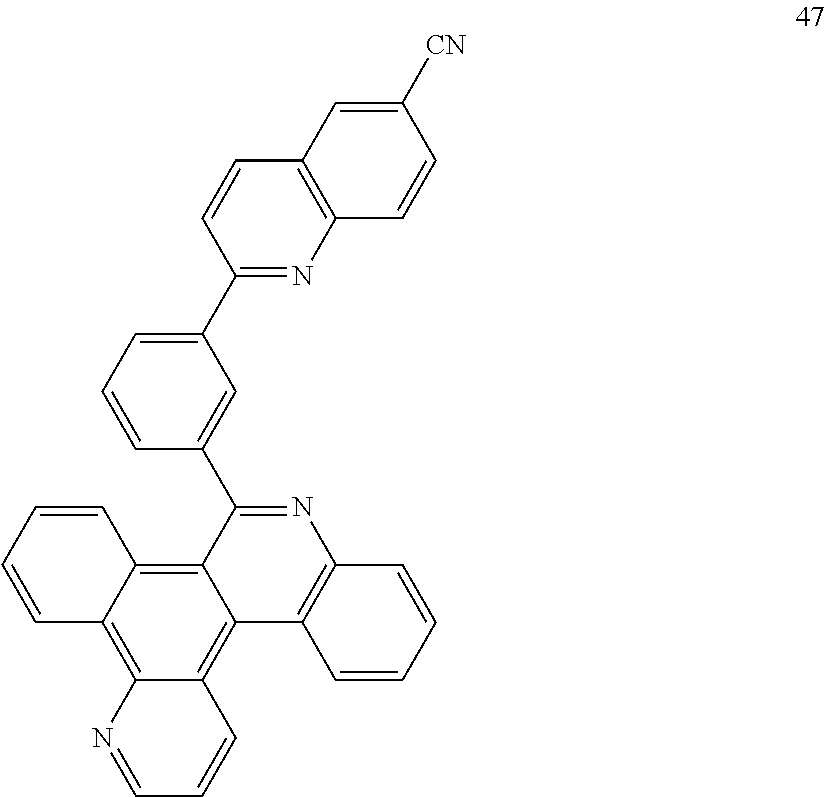
C00024

C00025
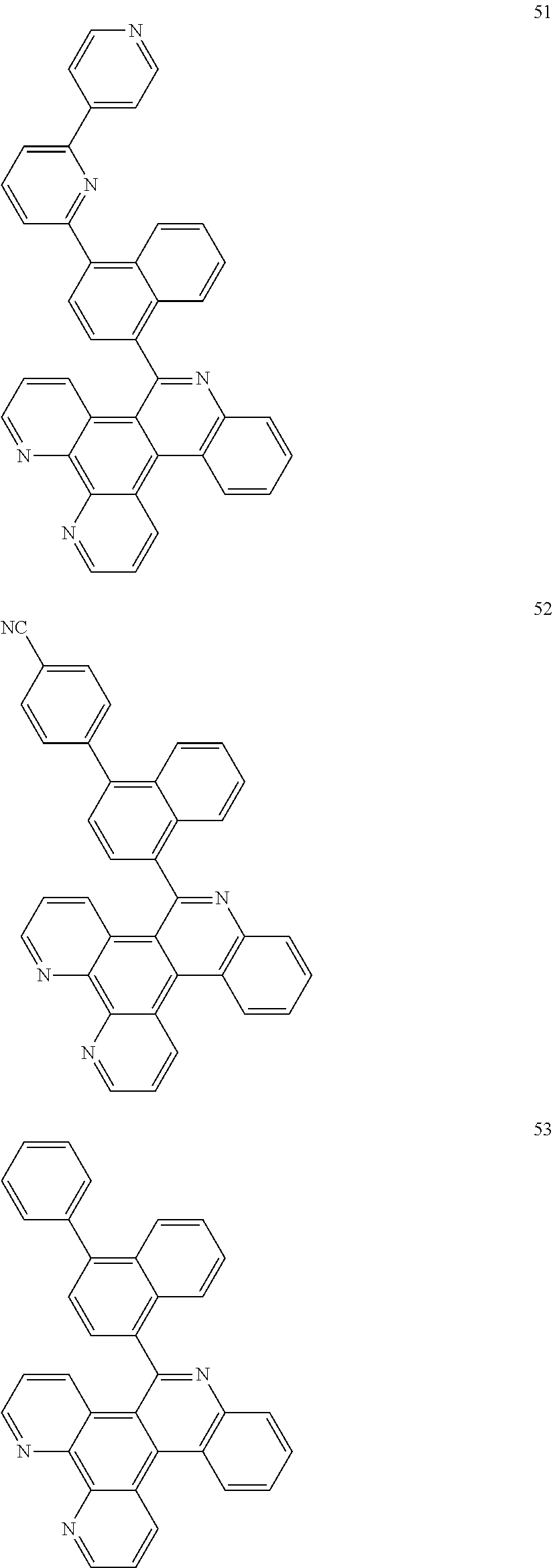
C00026

C00027

C00028

C00029

C00030

C00031

C00032

C00033

C00034

C00035

C00036

C00037

C00038

C00039

C00040
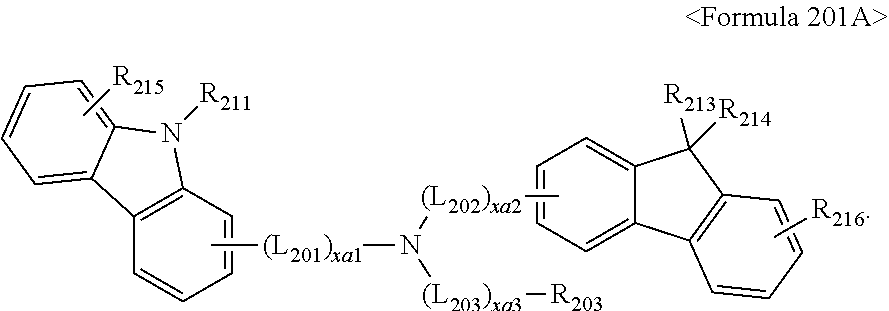
C00041

C00042
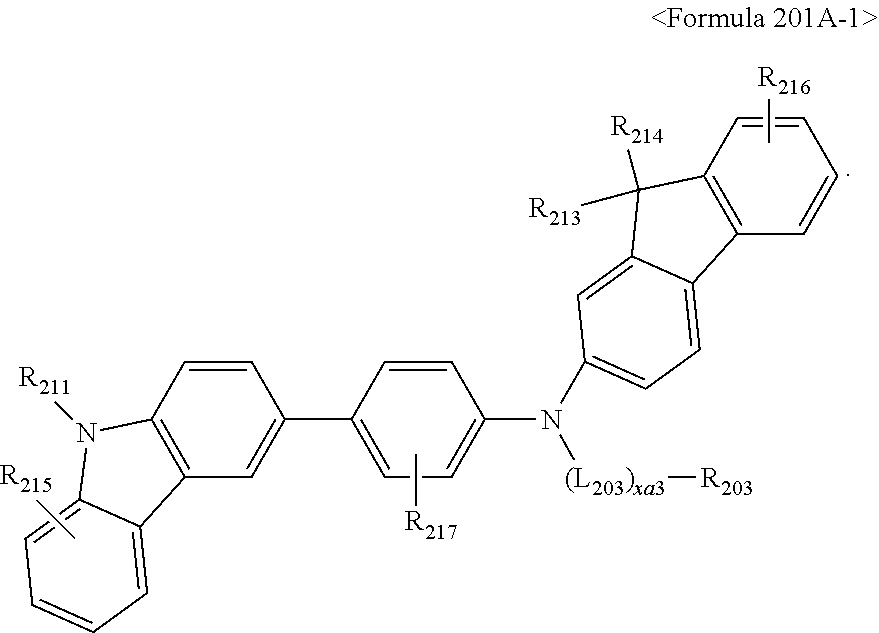
C00043

C00044

C00045
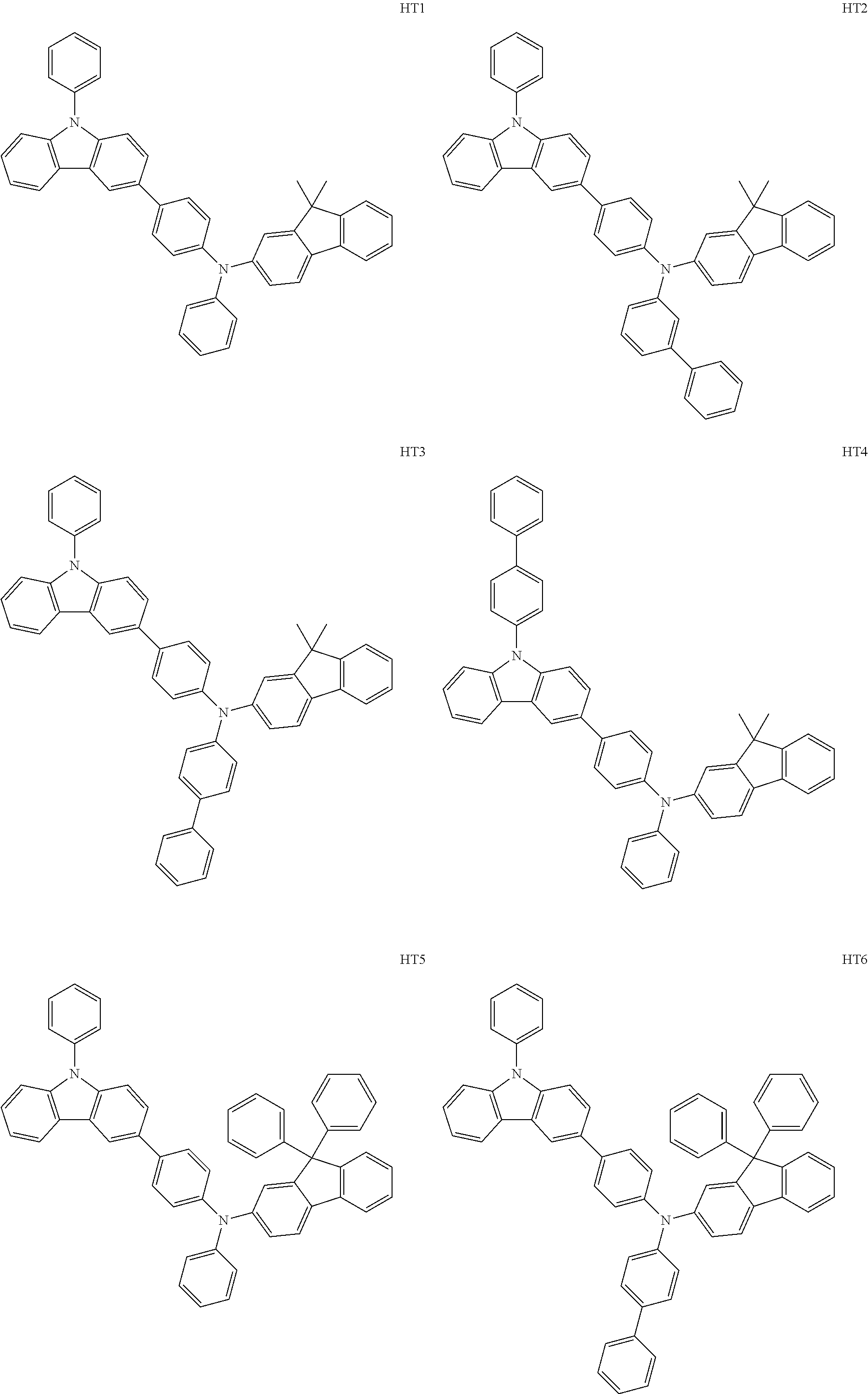
C00046

C00047
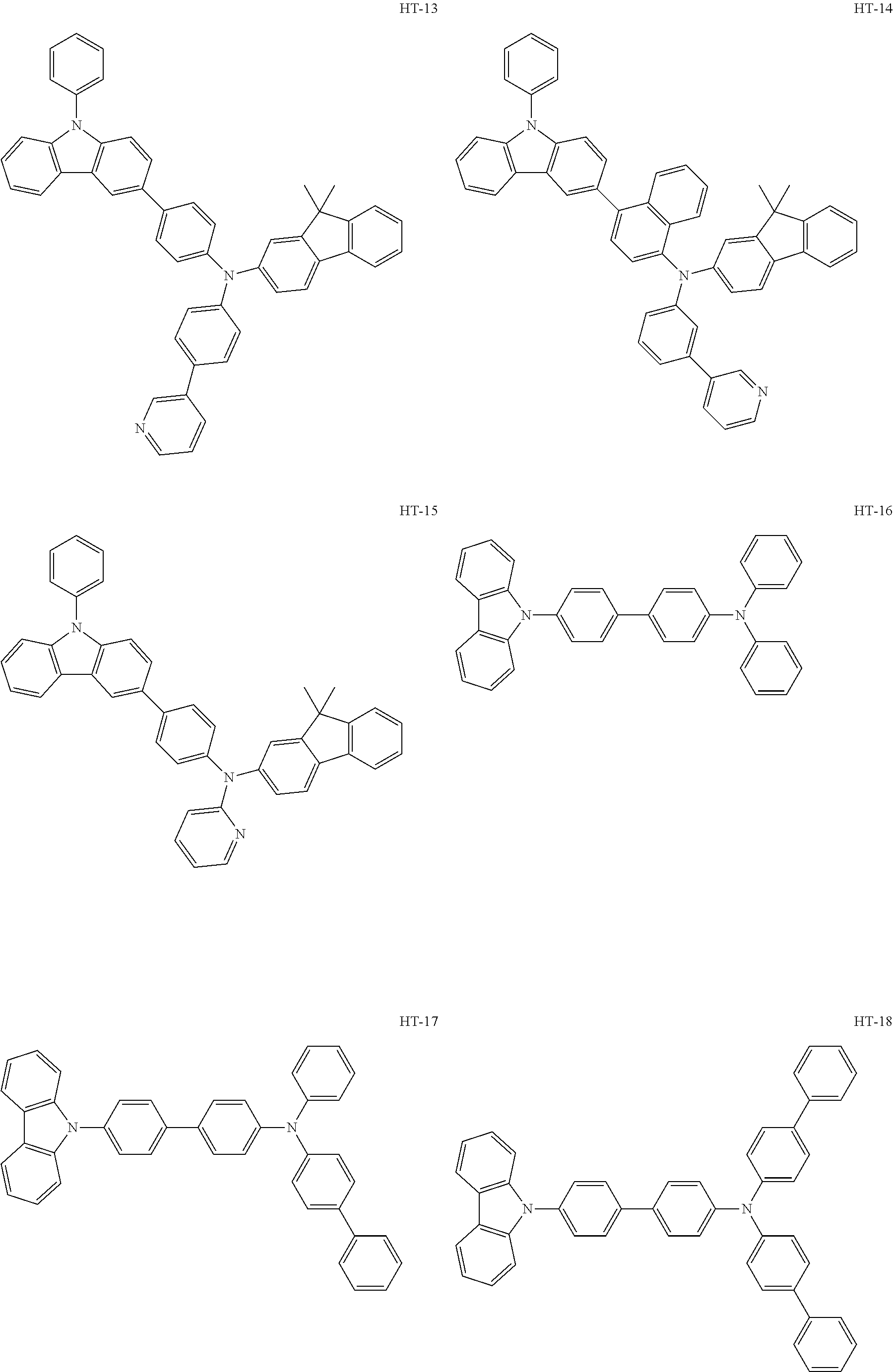
C00048
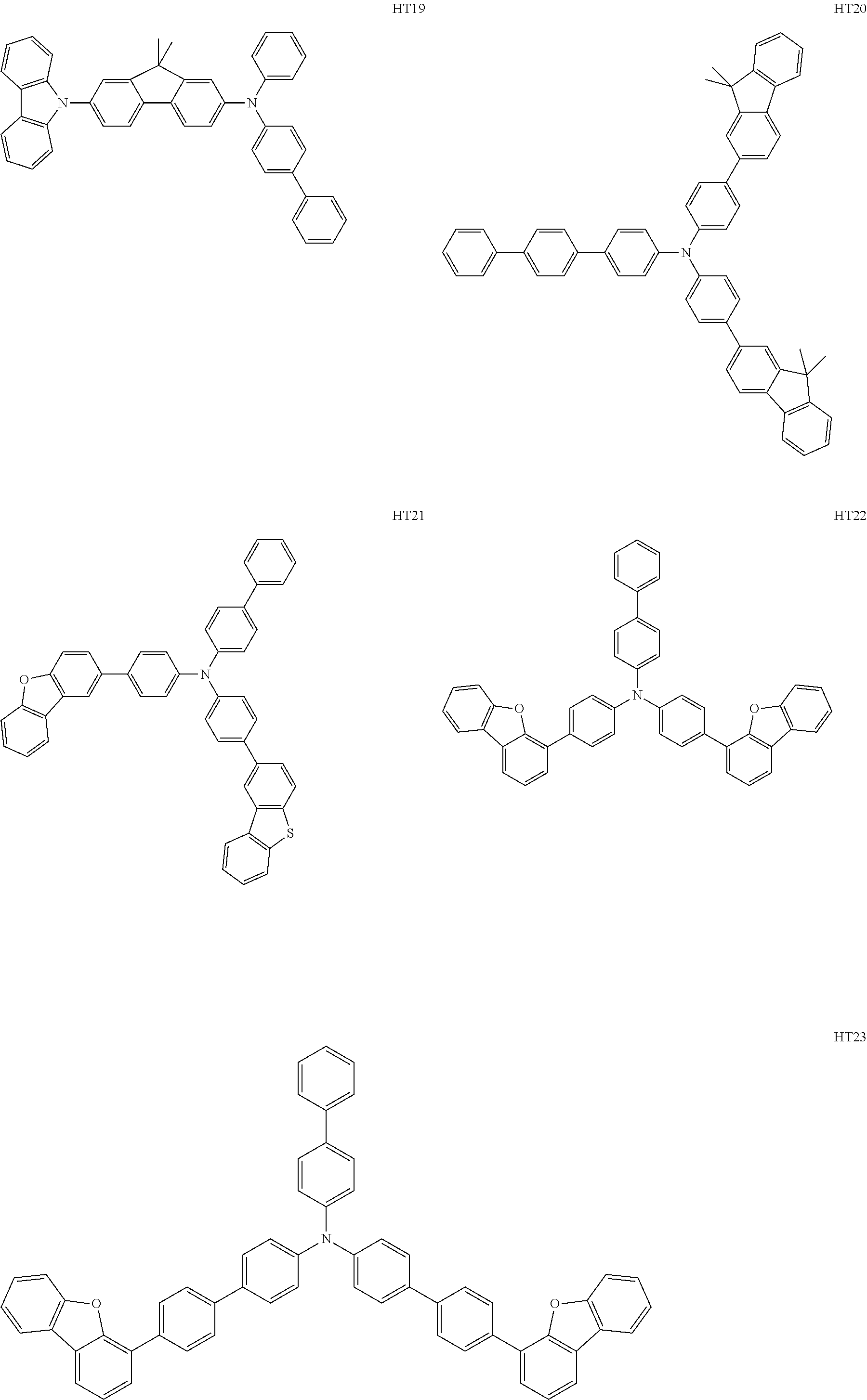
C00049
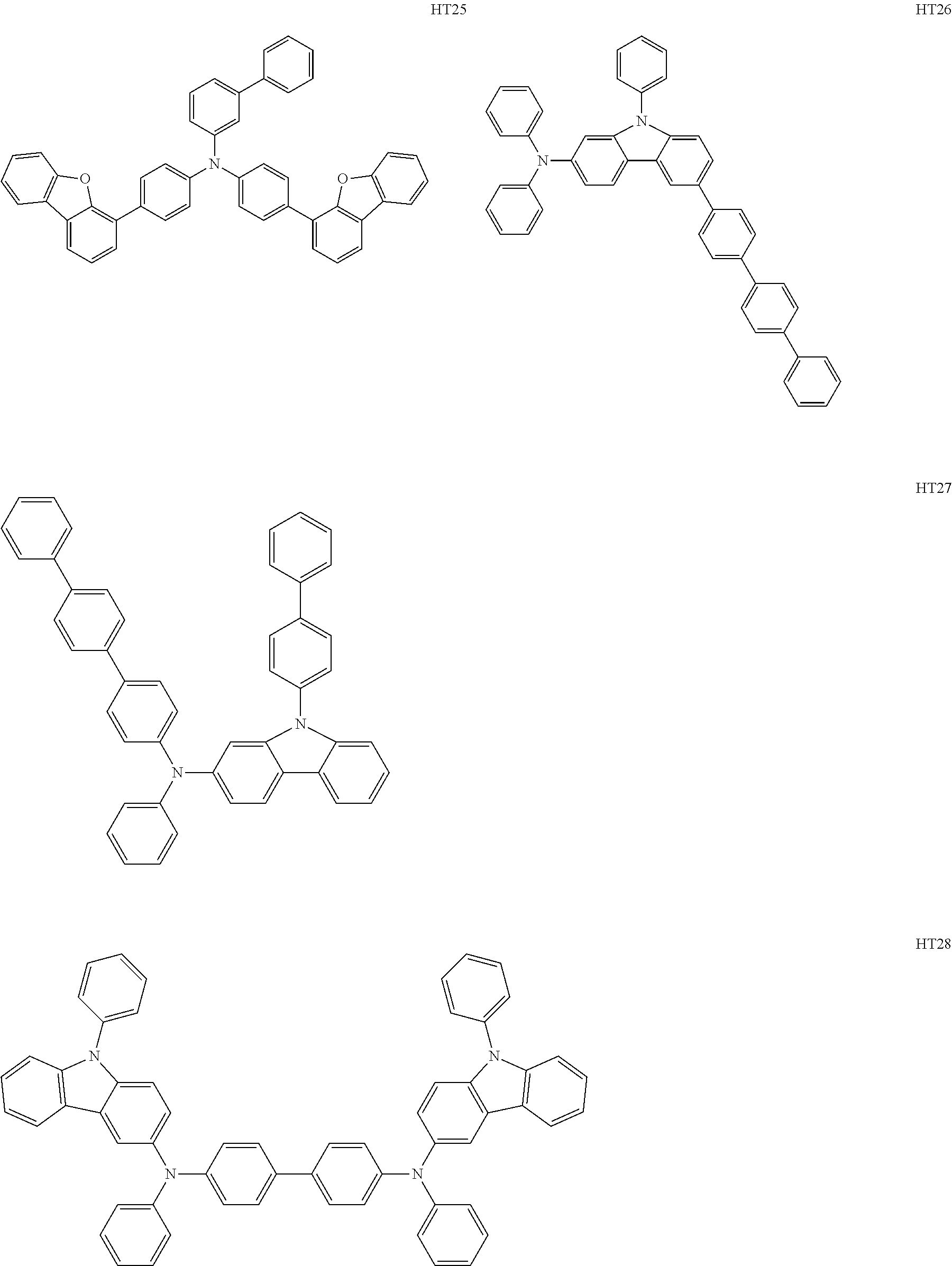
C00050
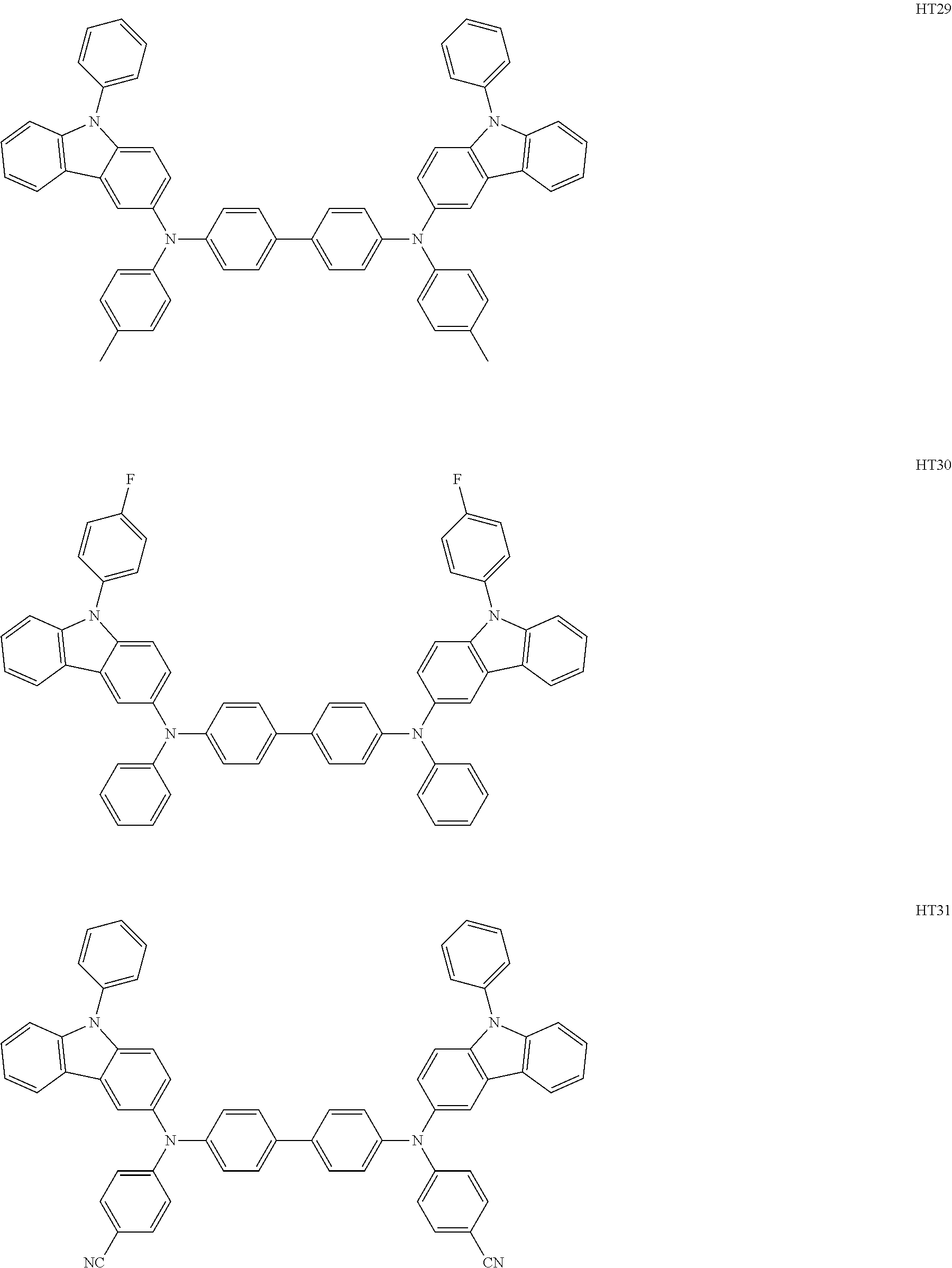
C00051
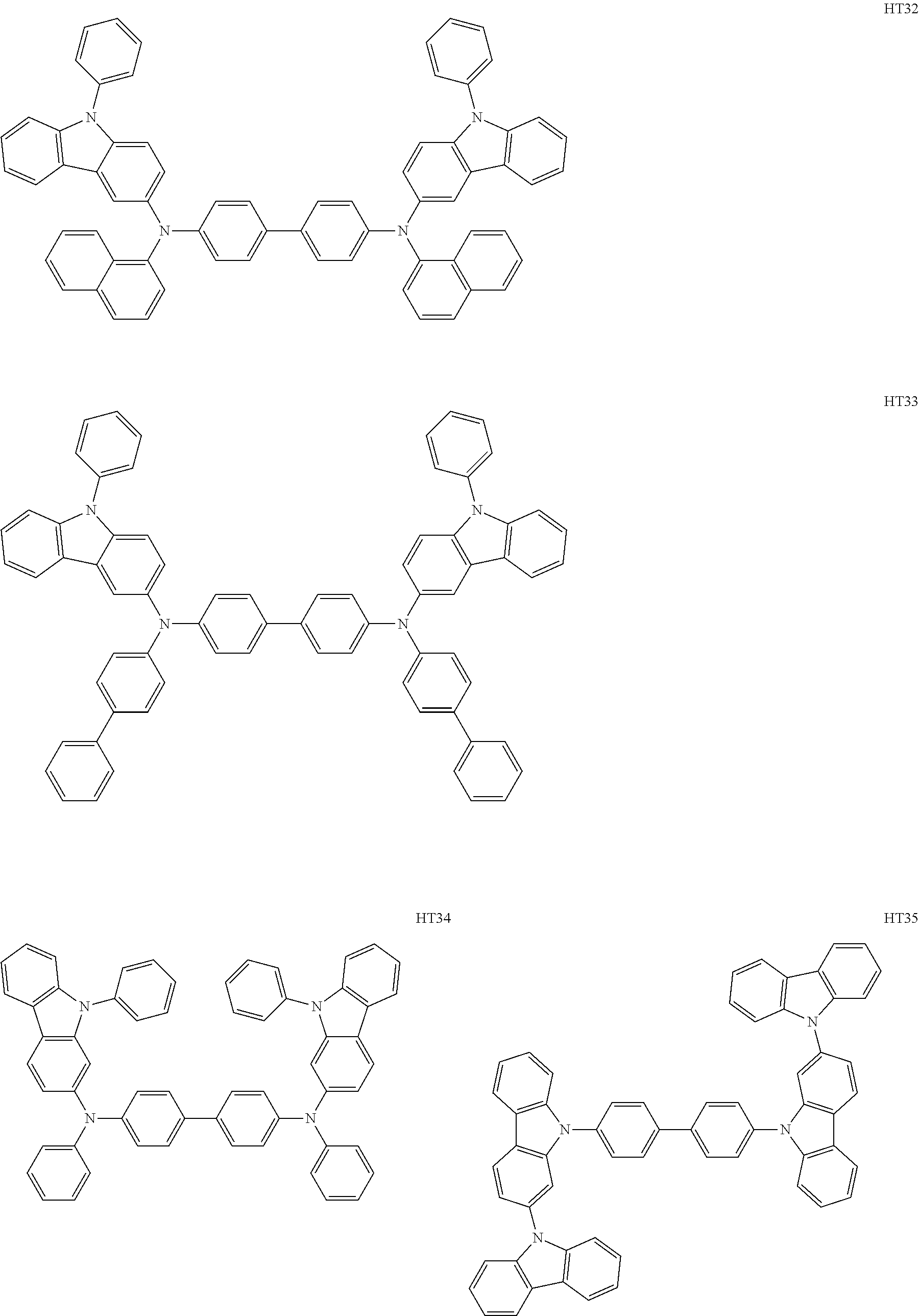
C00052
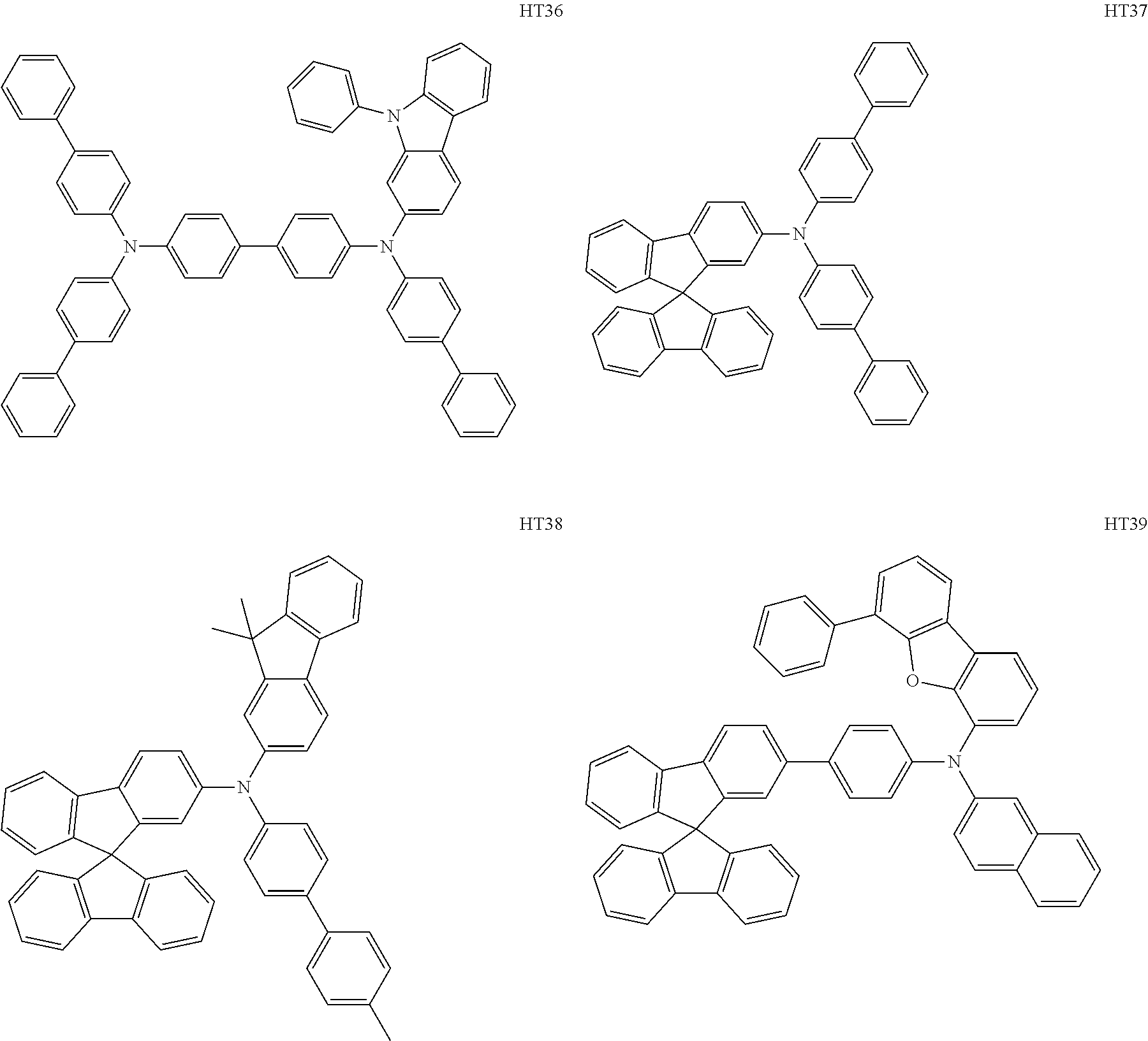
C00053

C00054

C00055

C00056

C00057

C00058

C00059

C00060

C00061

C00062

C00063

C00064

C00065

C00066

C00067
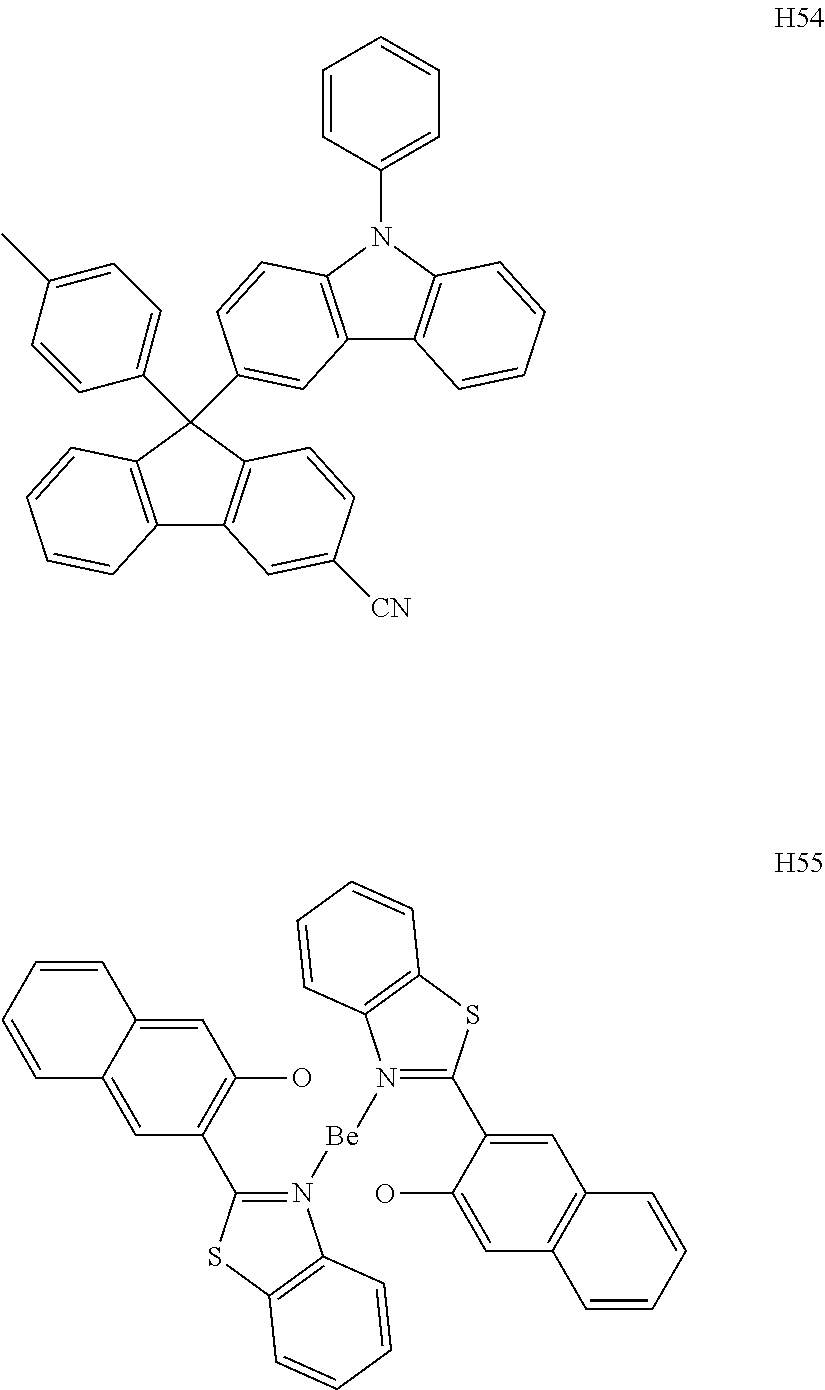
C00068

C00069

C00070

C00071

C00072

C00073

C00074

C00075

C00076

C00077

C00078

C00079
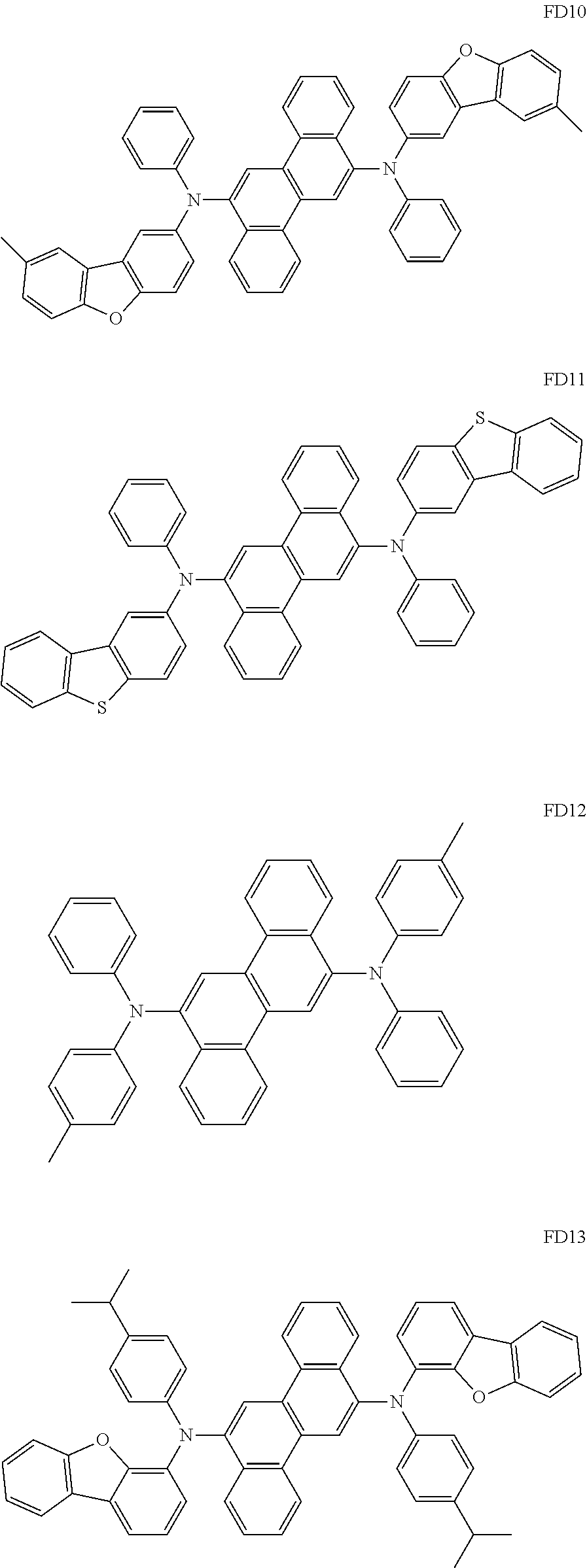
C00080

C00081
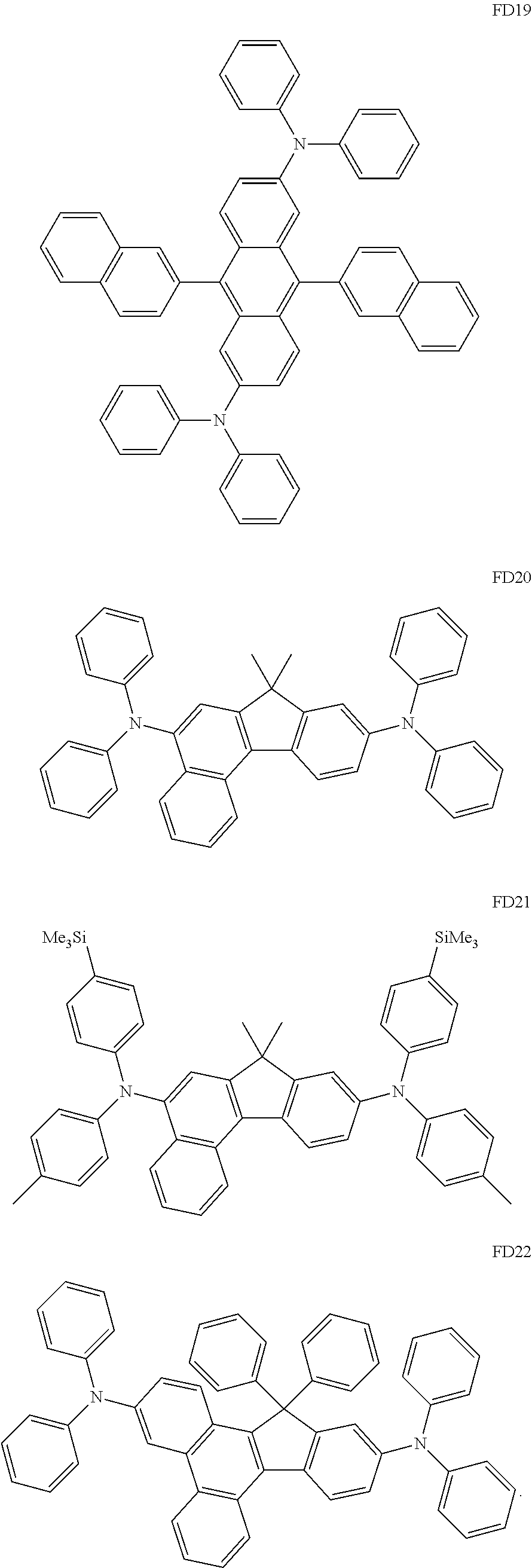
C00082

C00083

C00084

C00085

C00086

C00087

C00088

C00089

C00090

C00091
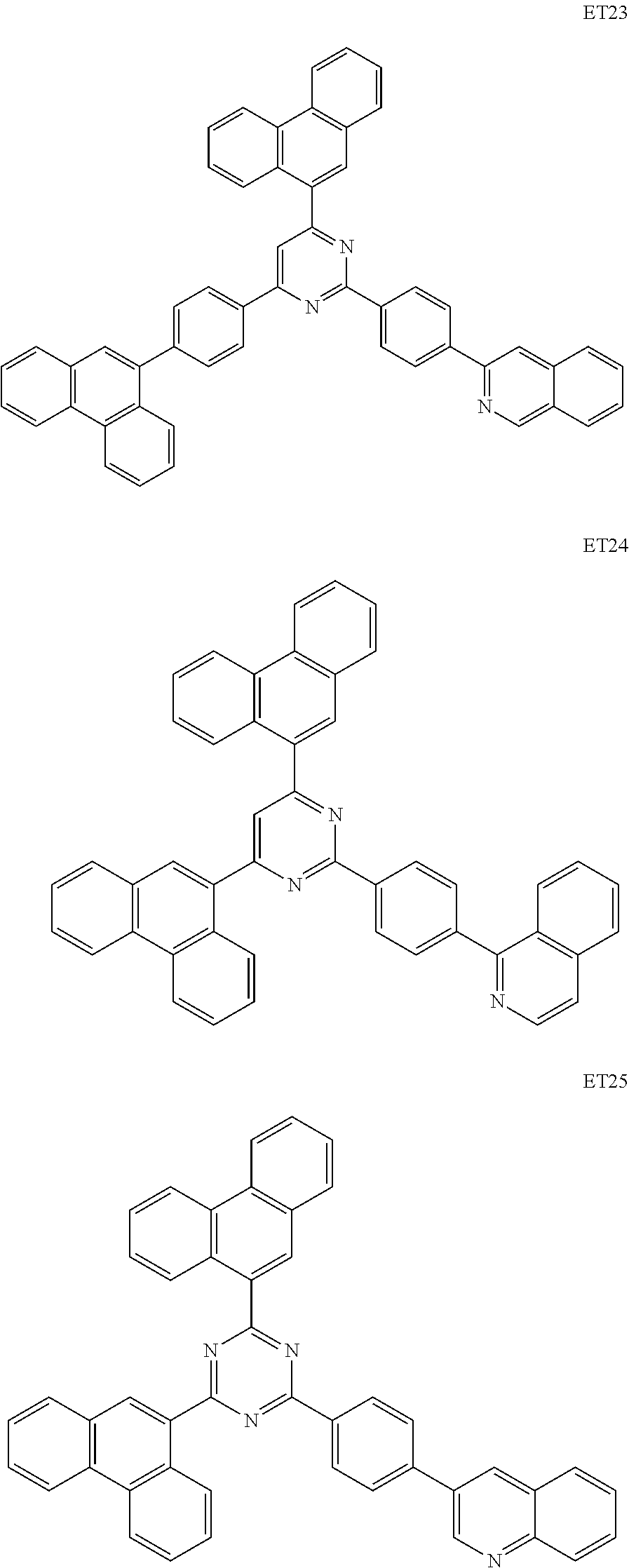
C00092

C00093

C00094
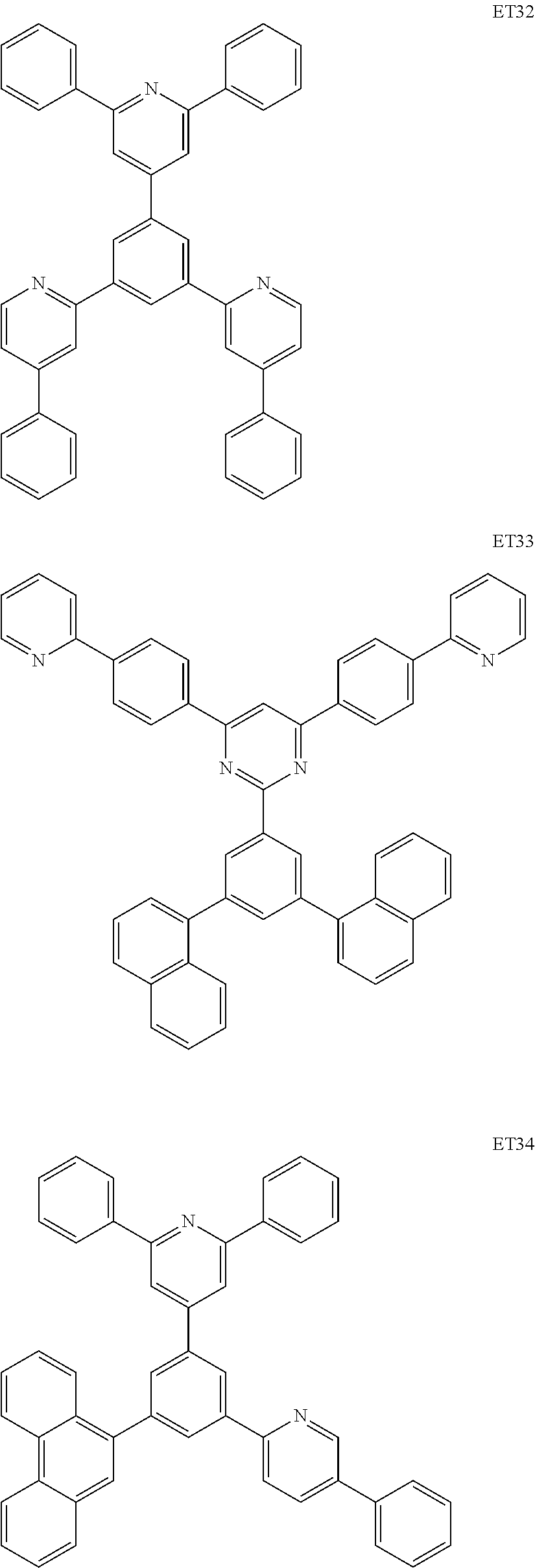
C00095

C00096
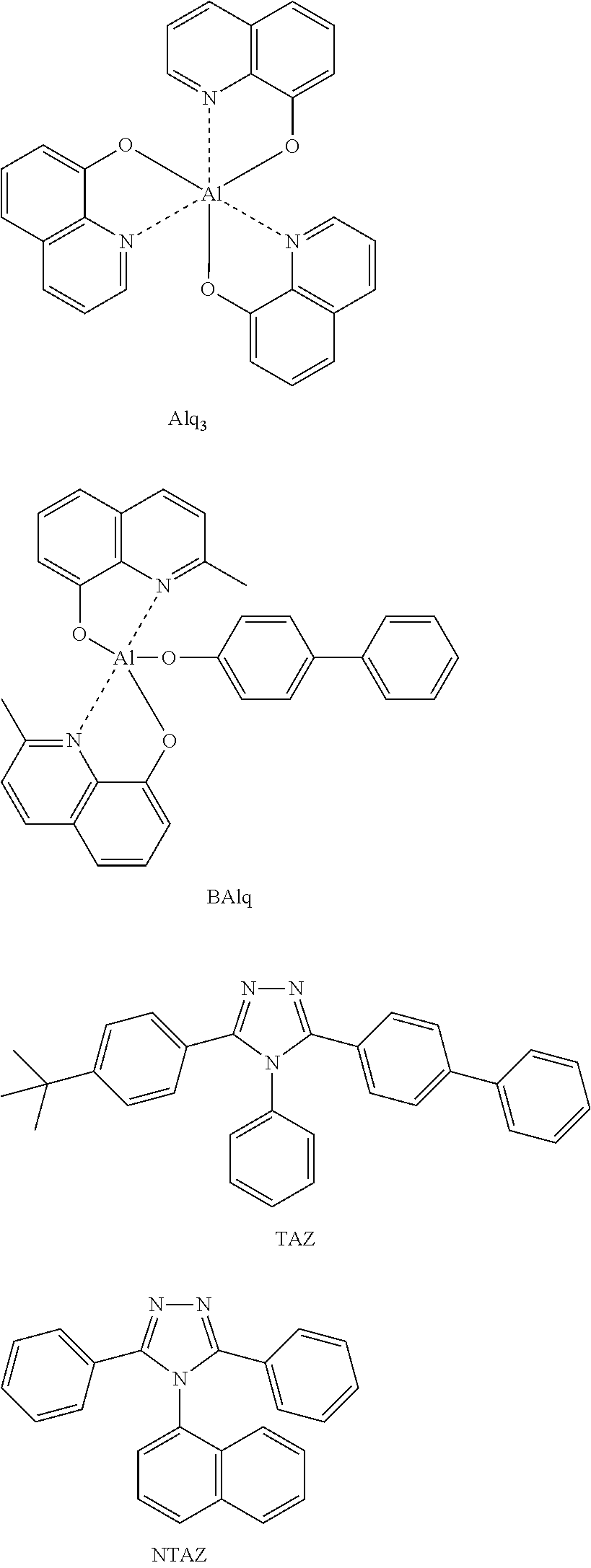
C00097

C00098

C00099

C00100

C00101
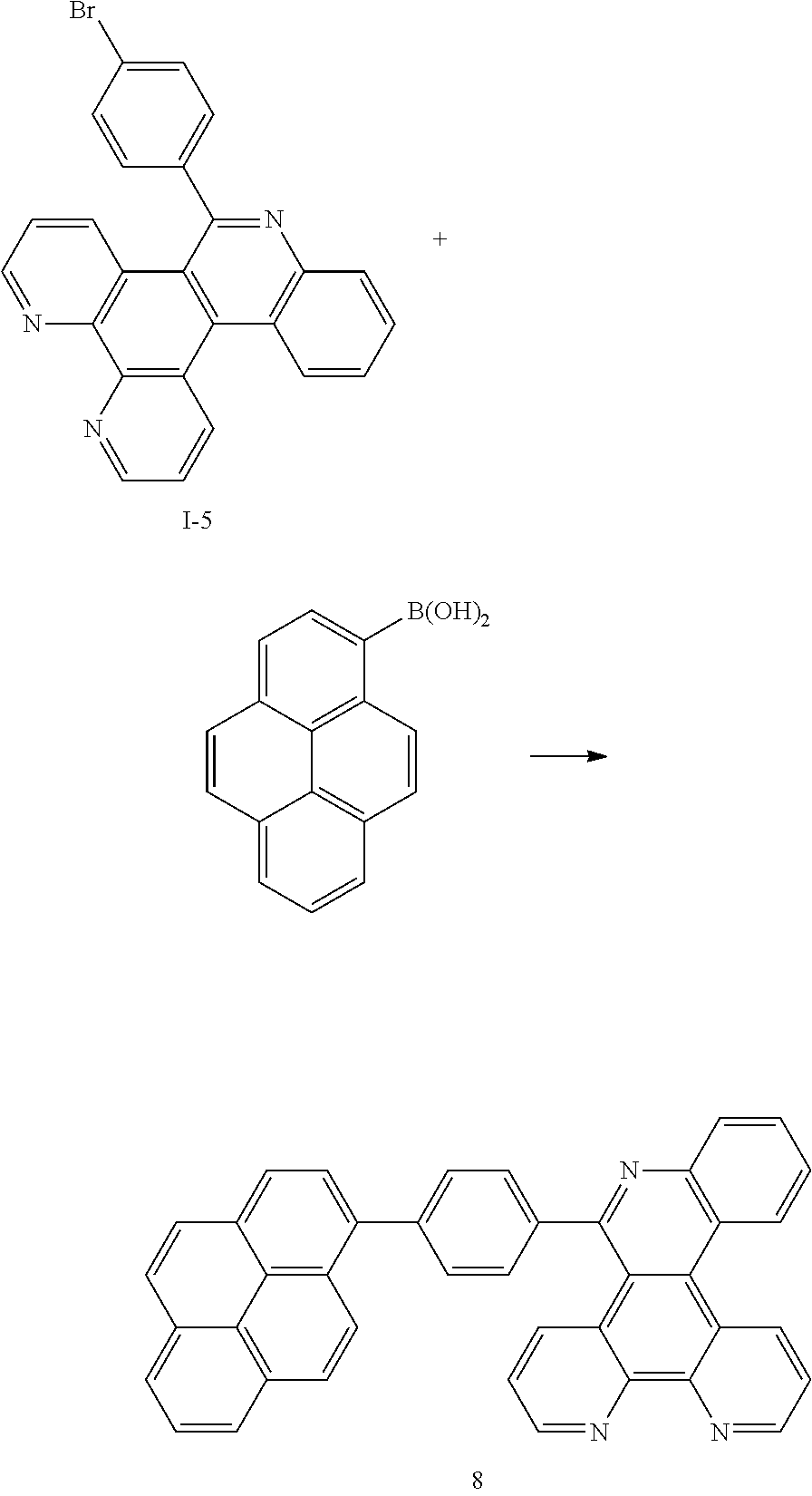
C00102

C00103

C00104
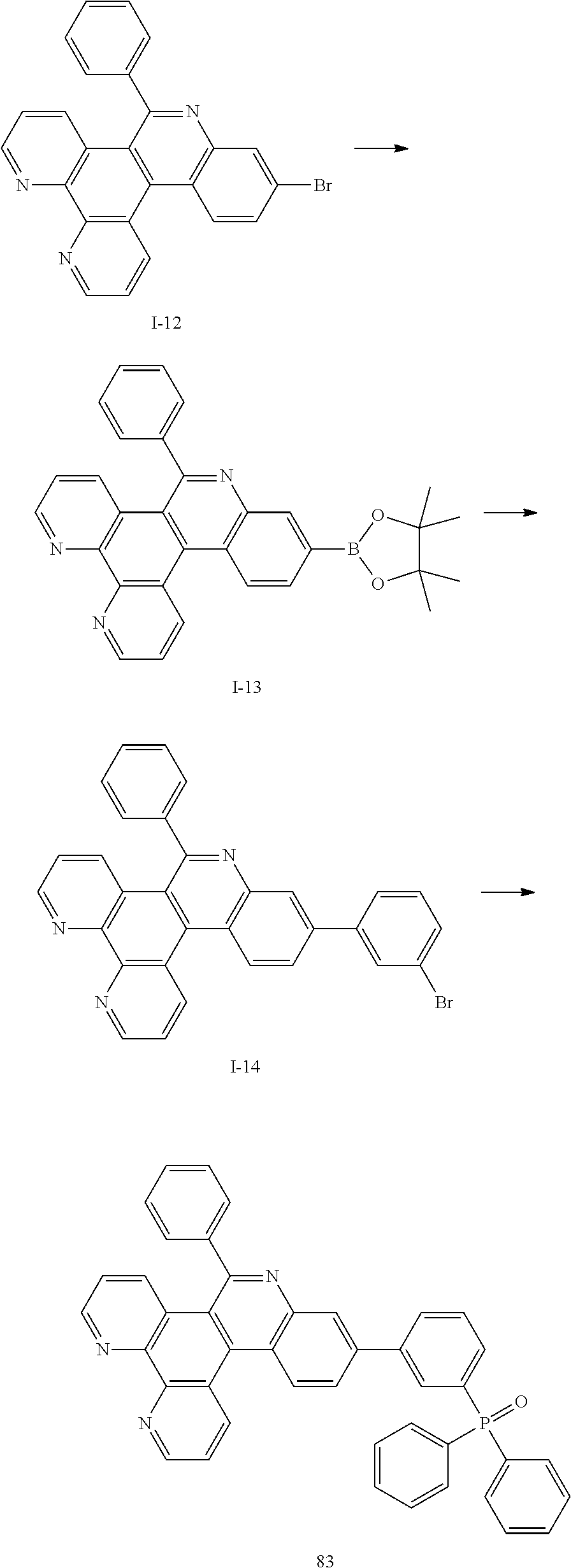
C00105
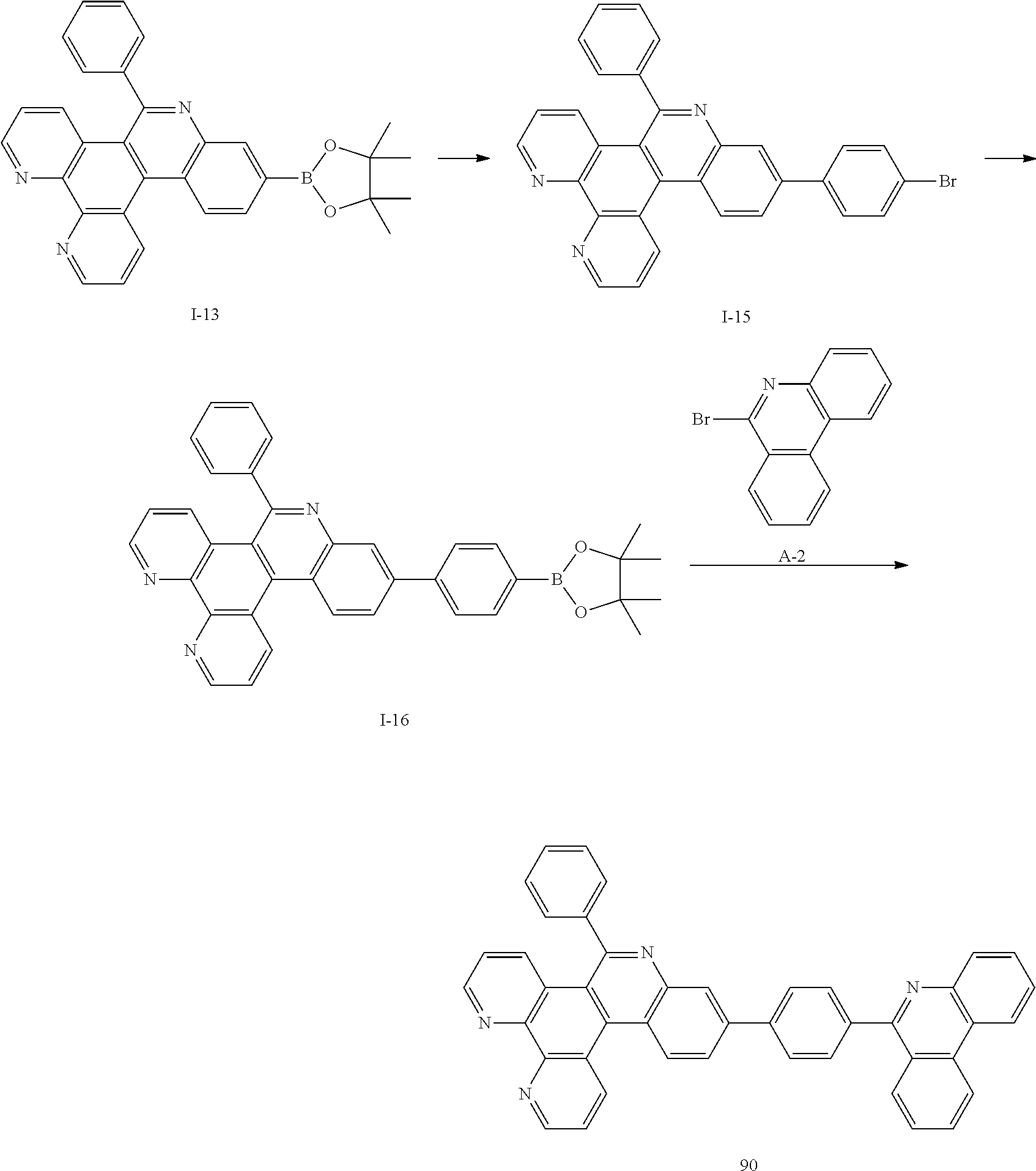
C00106

C00107
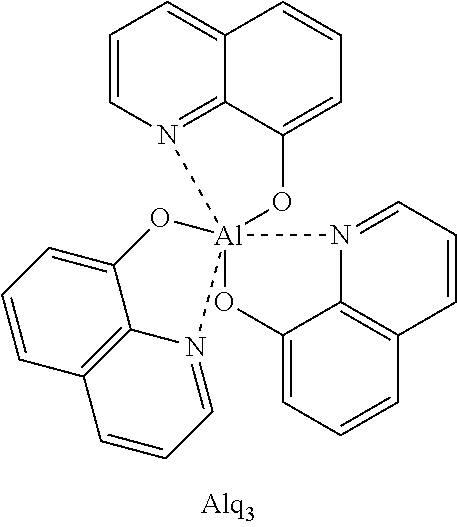
C00108
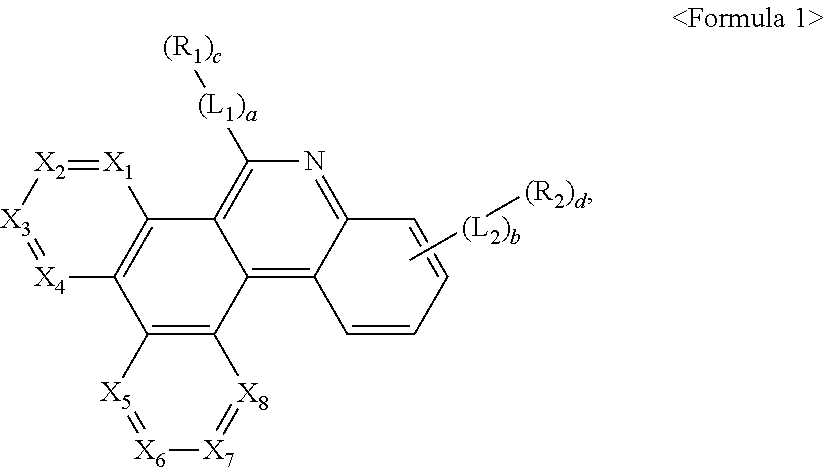
C00109
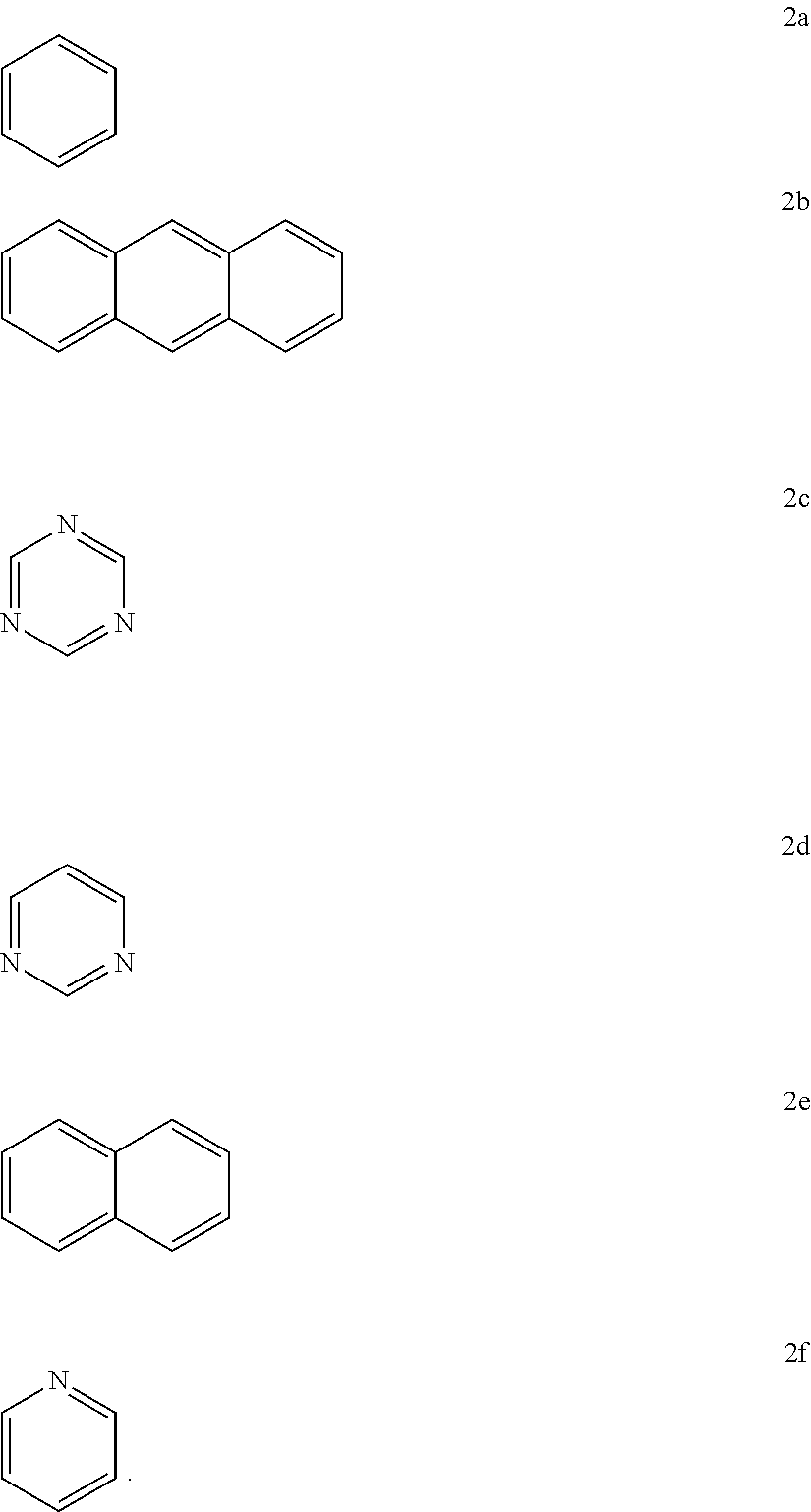
C00110

C00111
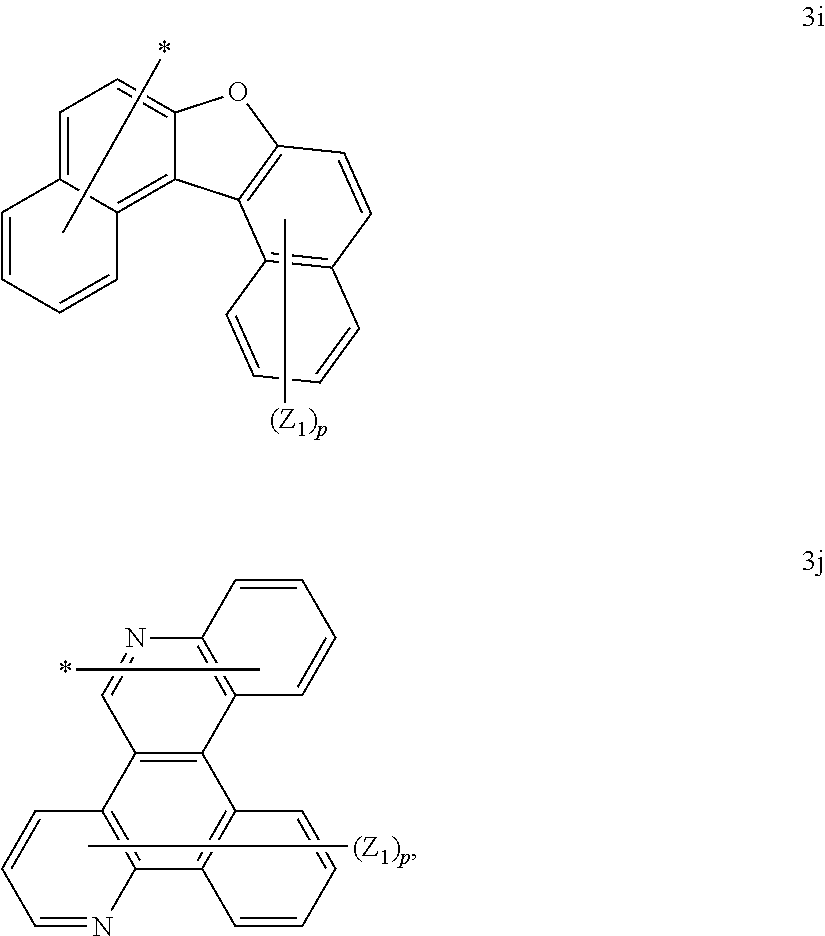
C00112
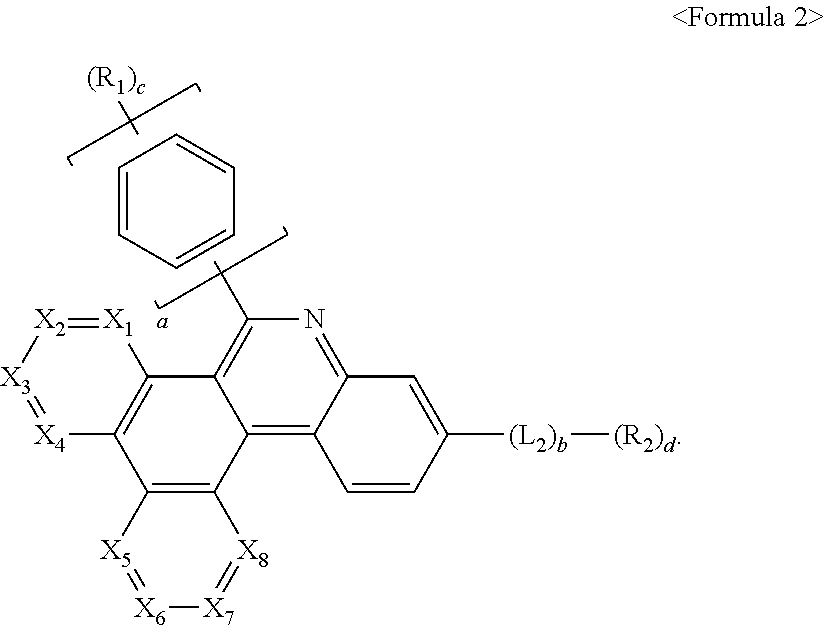
C00113
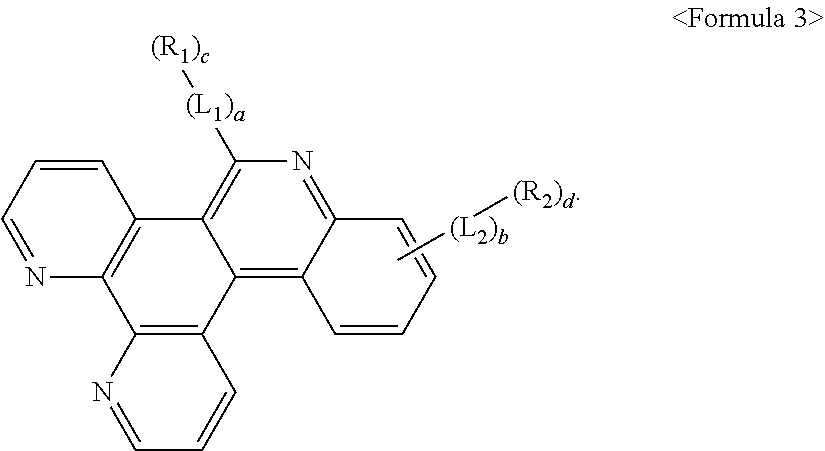
C00114

C00115

C00116

C00117

C00118

C00119

C00120
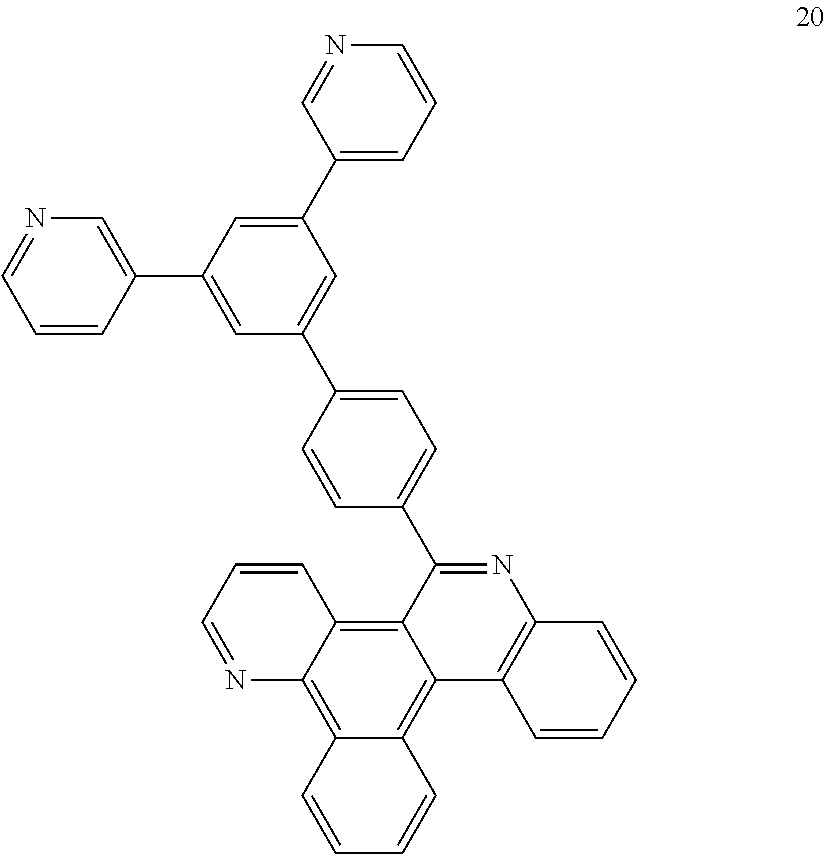
C00121

C00122

C00123

C00124

C00125

C00126

C00127

C00128

C00129

C00130

C00131
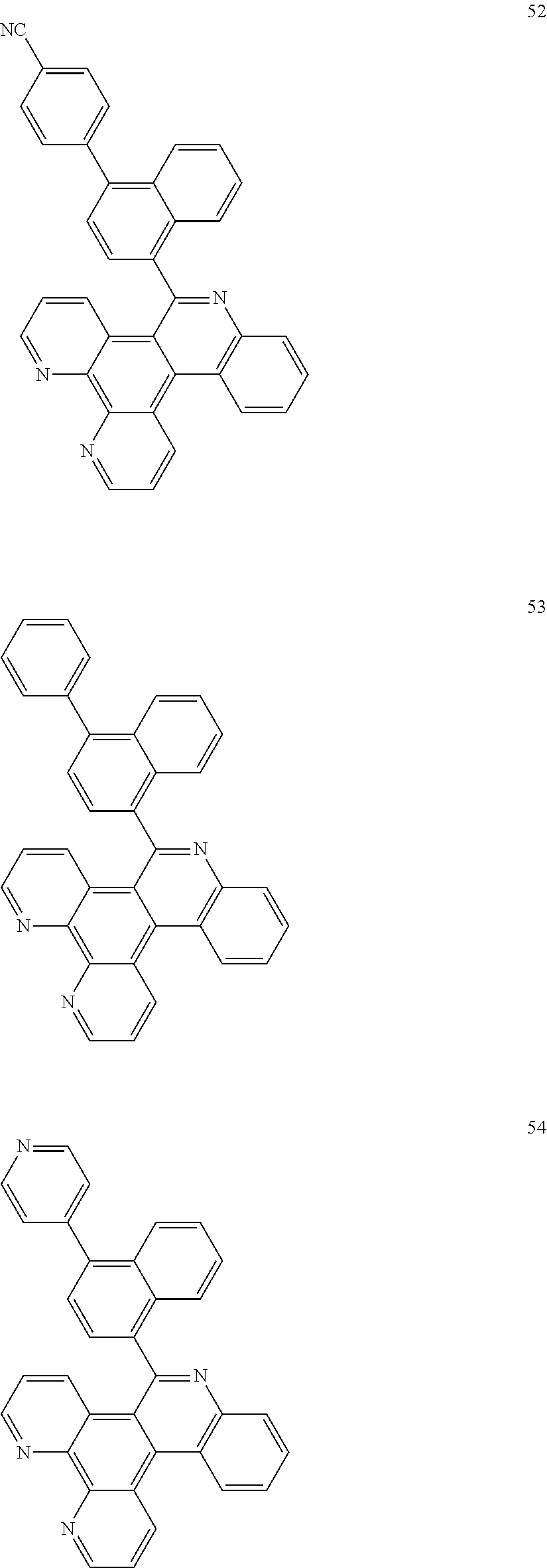
C00132

C00133

C00134
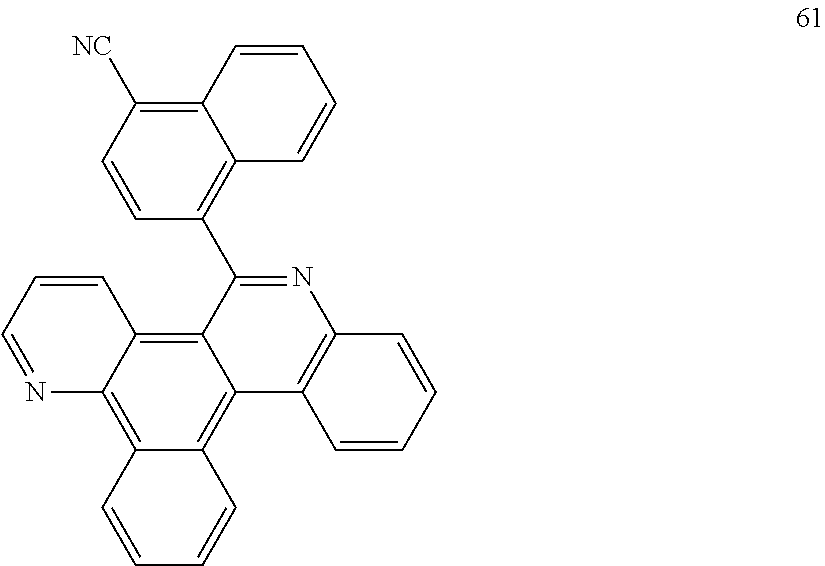
C00135
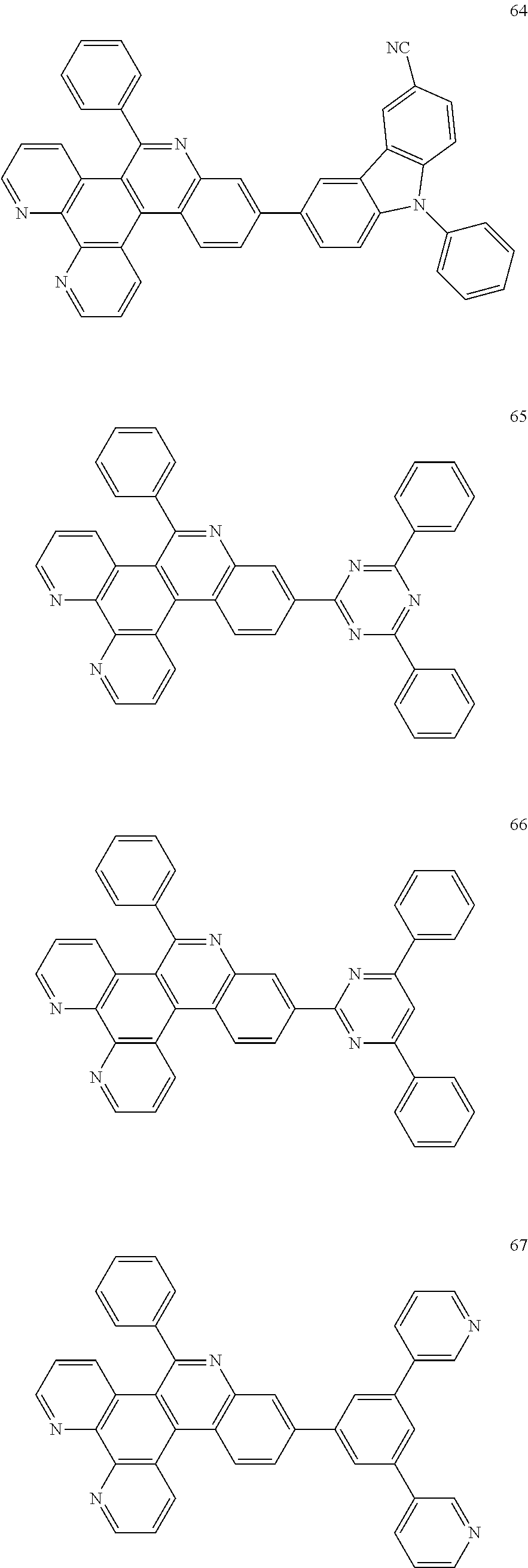
C00136

C00137
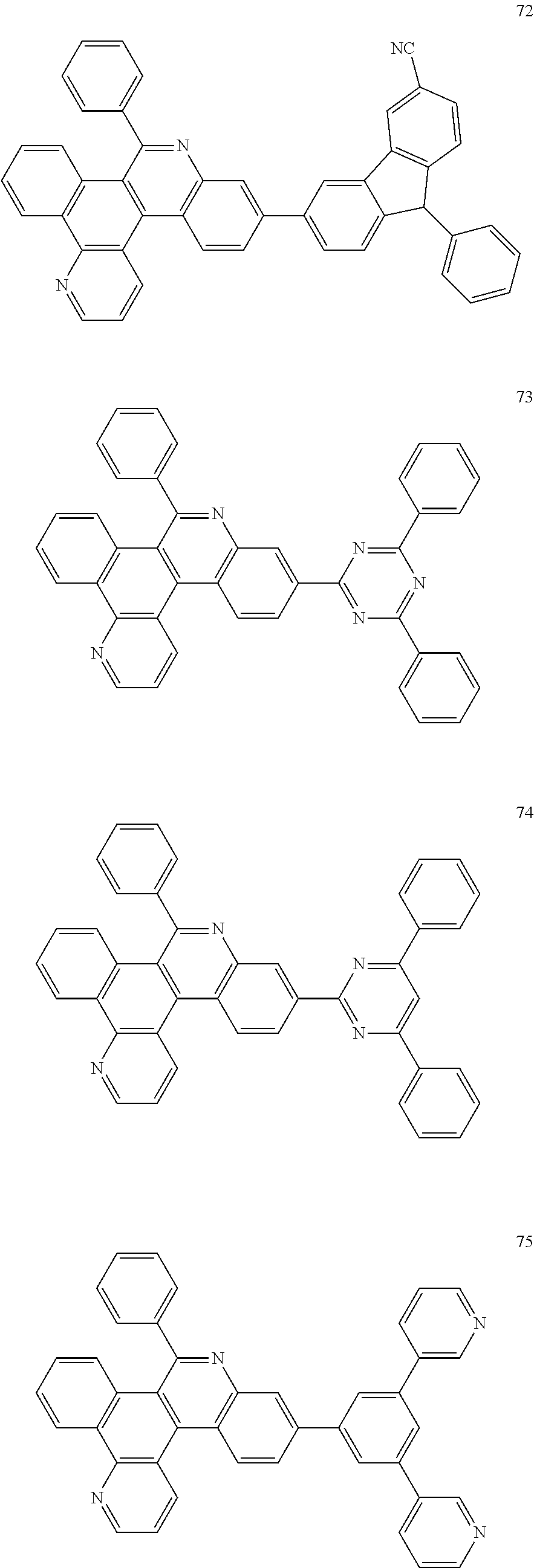
C00138
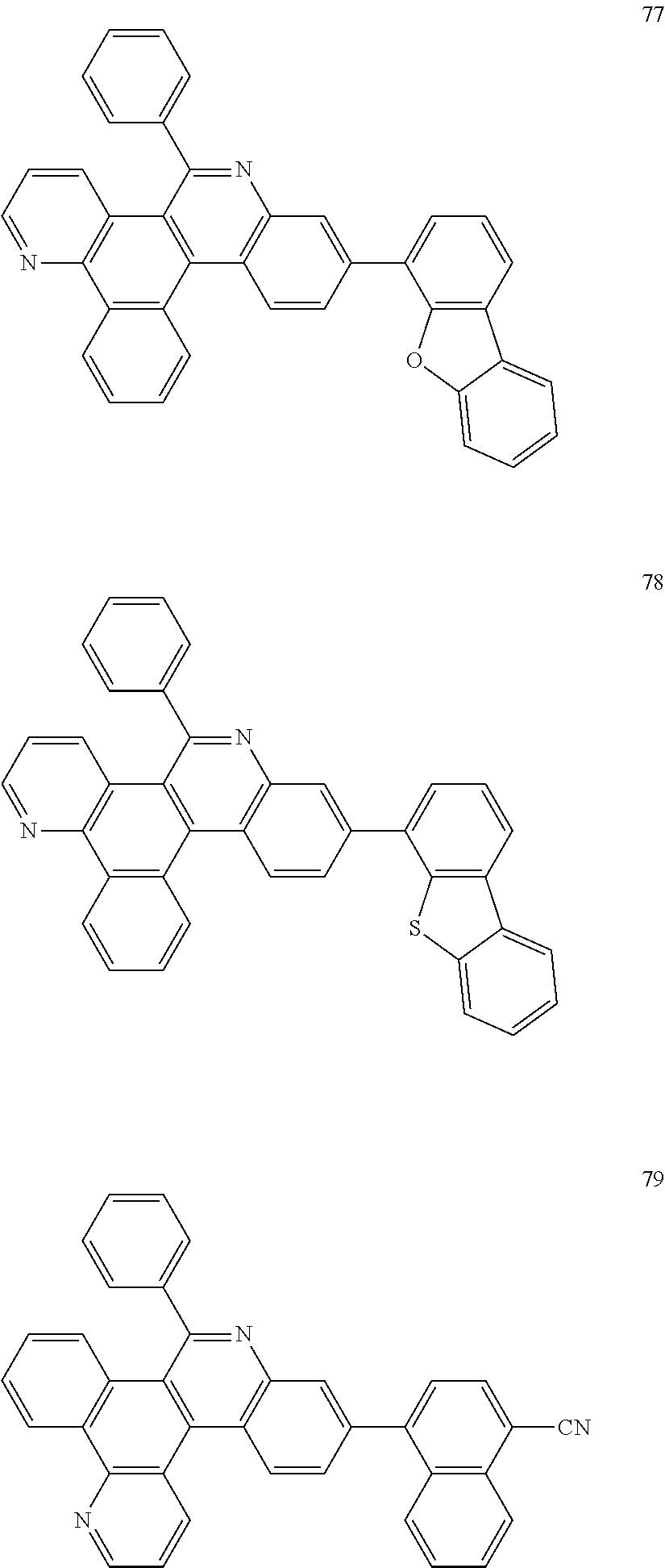
C00139

C00140

C00141

C00142

C00143
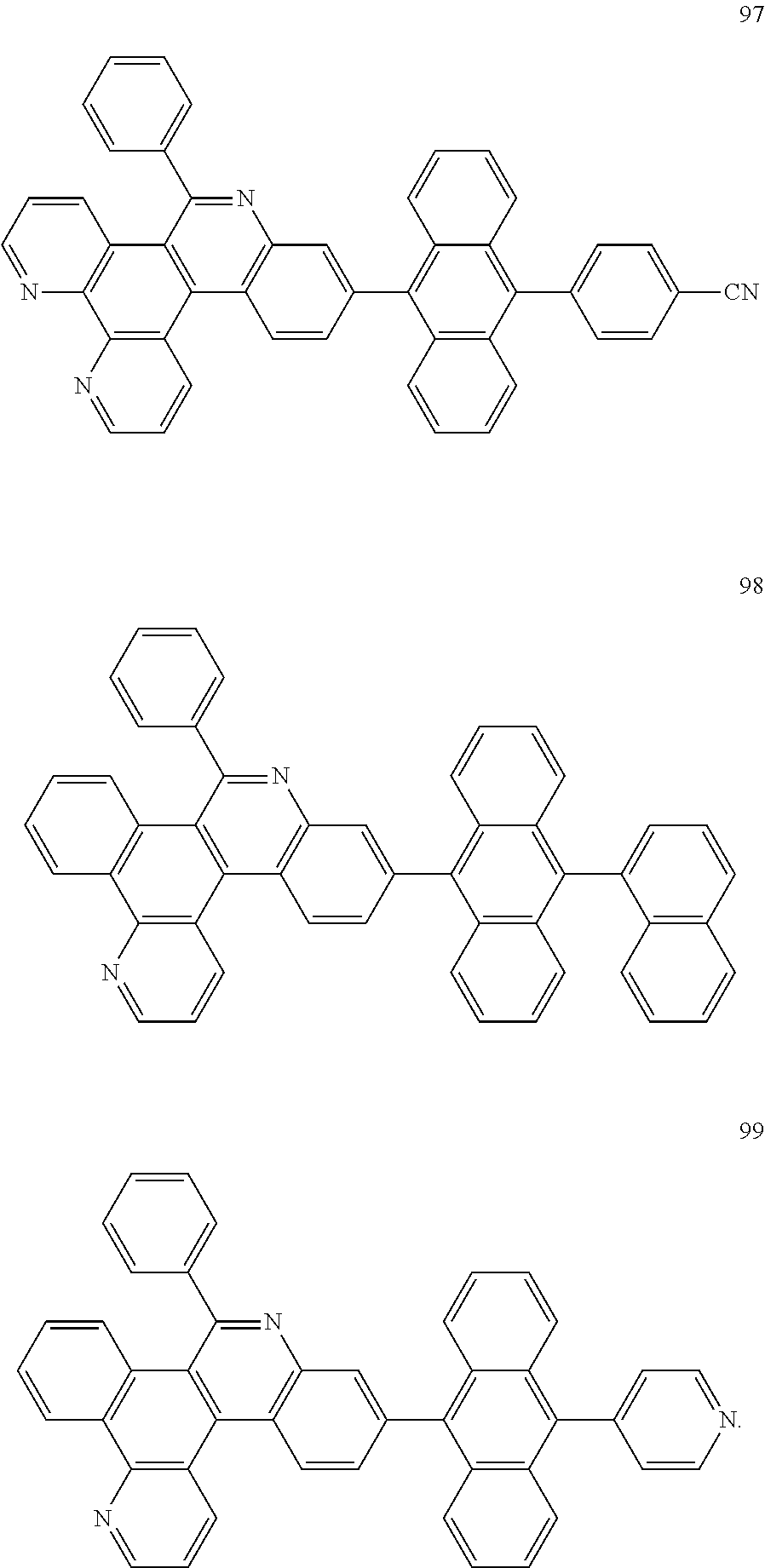
C00144
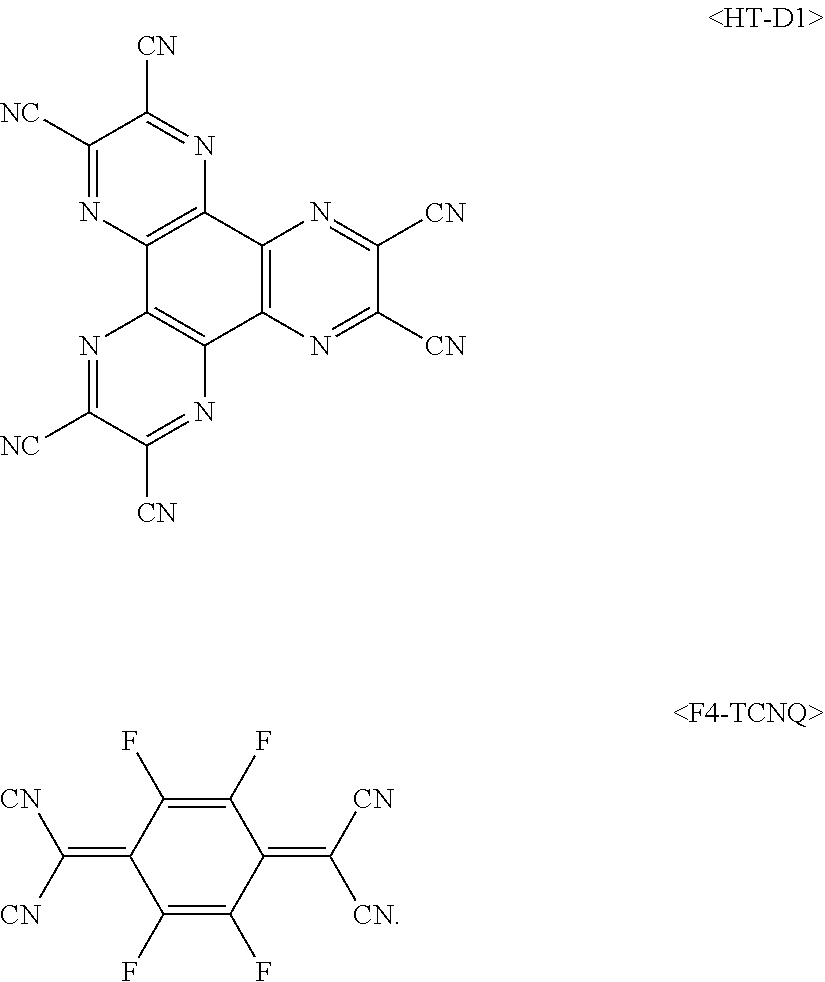
C00145

D00000

D00001
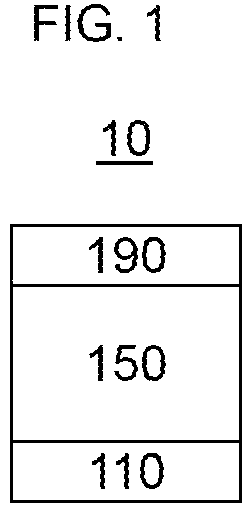
D00002

D00003
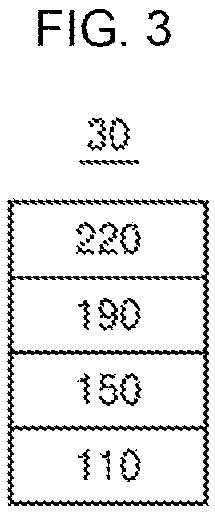
D00004

XML
uspto.report is an independent third-party trademark research tool that is not affiliated, endorsed, or sponsored by the United States Patent and Trademark Office (USPTO) or any other governmental organization. The information provided by uspto.report is based on publicly available data at the time of writing and is intended for informational purposes only.
While we strive to provide accurate and up-to-date information, we do not guarantee the accuracy, completeness, reliability, or suitability of the information displayed on this site. The use of this site is at your own risk. Any reliance you place on such information is therefore strictly at your own risk.
All official trademark data, including owner information, should be verified by visiting the official USPTO website at www.uspto.gov. This site is not intended to replace professional legal advice and should not be used as a substitute for consulting with a legal professional who is knowledgeable about trademark law.